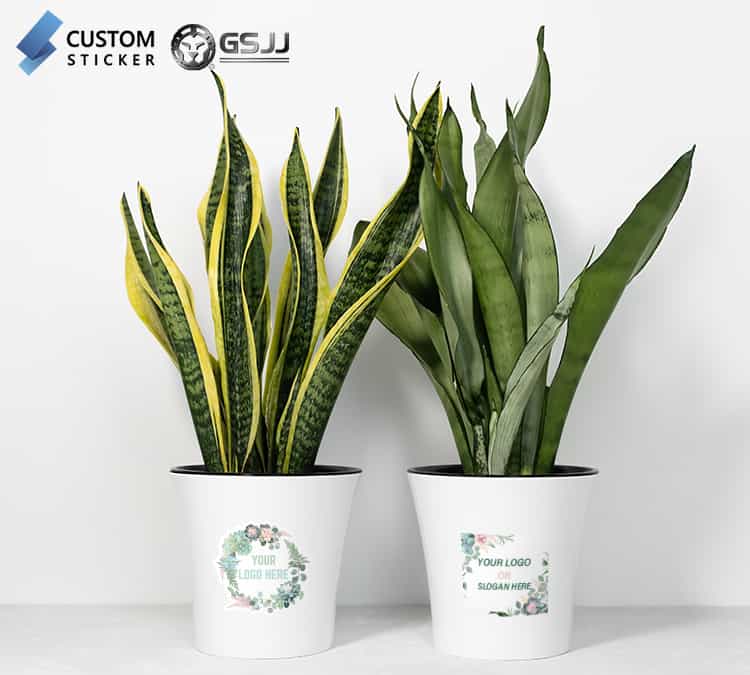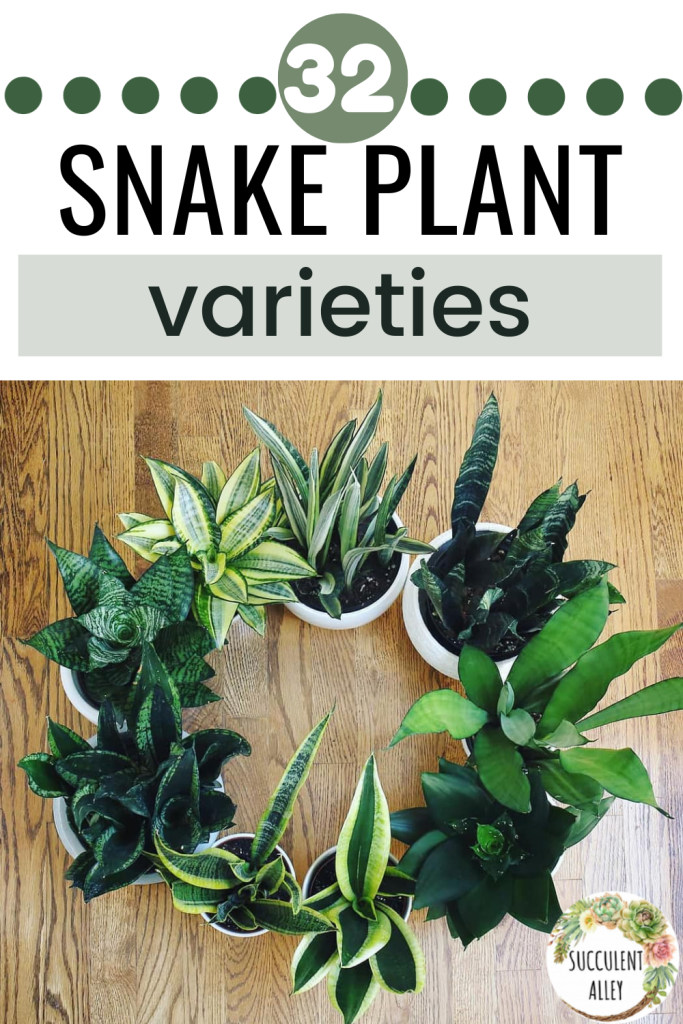137 Types of Snake Plants: Sansevieria Varieties Identification
Snake plants are the coolest, low-maintenance houseplants around! With funky upright leaves and quirky patterns, these striking succulents add a bold, modern touch to any room. Though they used to be overlooked, snake plants (also called sansevieria) have slithered back into popularity as people discover how easy they are to care for and style.
But did you know there are dozens of different varieties of snake plants? From short and stubby to tall and spindly, with leaves ranging from solid green to stripey yellows and whites, there’s a perfect sansevieria for every plant parent. Get ready to be amazed as we showcase 137 awesome snake plant types – you’ll want to collect them all! Whether you’re a new plant lover or an experienced green thumb, this guide will help you identify and pick your favorite sansevierias.
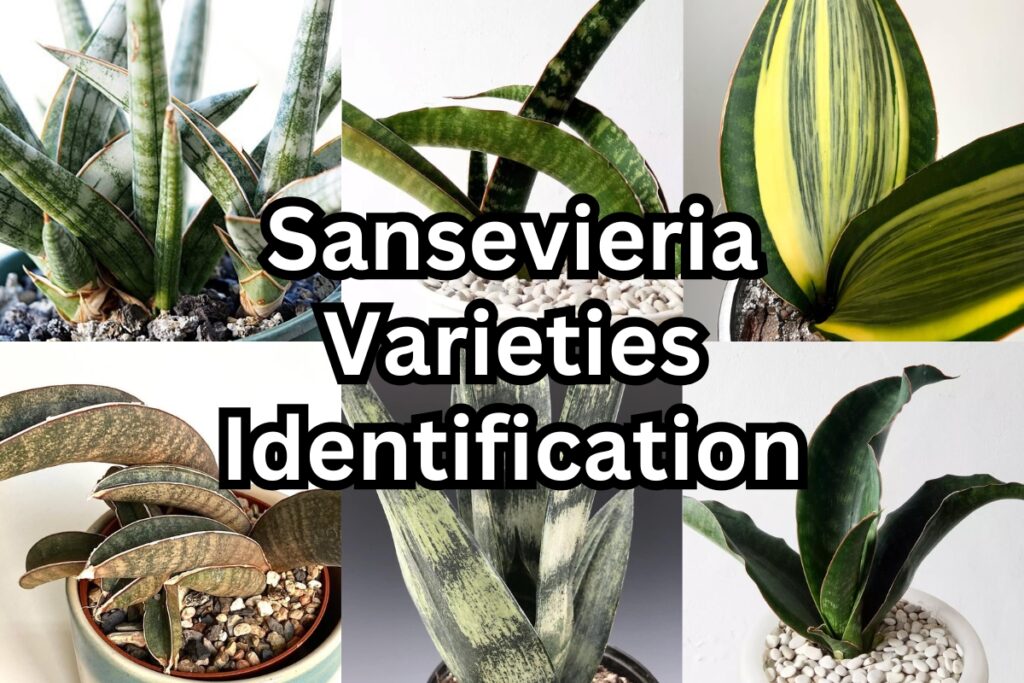
Related Post:
1,000 Types of Succulents with Pictures
Contents
- 1 Snake Plant Varieties With Names and Pictures
- 1.1 Sansevieria aethiopica
- 1.2 Sansevieria aethiopica ‘Variegata’
- 1.3 Sansevieria ‘Agatha’
- 1.4 Sansevieria ‘Andaman’
- 1.5 Sansevieria ‘Andaman Variegata’
- 1.6 Sansevieria arborescens
- 1.7 Sansevieria arborescens ‘Variegata’
- 1.8 Sansevieria ‘Asahi’
- 1.9 Sansevieria aubrytiana
- 1.10 Sansevieria bacularis
- 1.11 Sansevieria bagamoyensis
- 1.12 Sansevieria ballyi
- 1.13 Sansevieria ballyi ‘Minnie’
- 1.14 Sansevieria ballyi ‘Star’
- 1.15 Sansevieria bella
- 1.16 Sansevieria bhitalae
- 1.17 Sansevieria bhitalae ‘Silver Blue’
- 1.18 Sansevieria bhitalae ‘Super Clone’
- 1.19 Sansevieria braunii
- 1.20 Sansevieria ‘Bunlue Torch’
- 1.21 Sansevieria ‘Bruda’
- 1.22 Sansevieria burmanica
- 1.23 Sansevieria canaliculata
- 1.24 Sansevieria canaliculata ‘Dwarf’
- 1.25 Sansevieria caulescens
- 1.26 Sansevieria chahinianii
- 1.27 Sansevieria concinna
- 1.28 Sansevieria conspicua
- 1.29 Sansevieria cylindrica
- 1.30 Sansevieria cylindrica ‘Spaghetti’
- 1.31 Sansevieria cylindrica ‘Skyline’
- 1.32 Sansevieria cylindrica var. patula
- 1.33 Sansevieria cylindrica var. patula ‘Boncel’
- 1.34 Sansevieria dhofarica
- 1.35 Sansevieria dhofarica ‘Variegata’
- 1.36 Sansevieria dooneri
- 1.37 Sansevieria downsii
- 1.38 Sansevieria dumetescens ‘Variegata’
- 1.39 Sansevieria ehrenbergii
- 1.40 Sansevieria ehrenbergii ‘Banana’
- 1.41 Sansevieria ehrenbergii ‘Samurai Salaf Variegata’
- 1.42 Sansevieria eilensis
- 1.43 Sansevieria elliptica
- 1.44 Sansevieria elliptica ‘Horwood’
- 1.45 Sansevieria erythraeae
- 1.46 Sansevieria fasciata
- 1.47 Sansevieria fasciata ‘Frozen’
- 1.48 Sansevieria ‘Fernwood’
- 1.49 Sansevieria fischeri
- 1.50 Sansevieria forskaoliana
- 1.51 Sansevieria francisii
- 1.52 Sansevieria gracillima ‘Variegata’
- 1.53 Sansevieria gracilis
- 1.54 Sansevieria gracilis ‘Variegata’
- 1.55 Sansevieria grandis
- 1.56 Sansevieria guineensis ‘Beauty Queen’
- 1.57 Sansevieria hallii
- 1.58 Sansevieria hallii ‘Blue Bat’
- 1.59 Sansevieria hallii ‘Lundi Bat’
- 1.60 Sansevieria hallii ‘Pink Bat’
- 1.61 Sansevieria hallii ‘Silver Bat’
- 1.62 Sansevieria hargeisana
- 1.63 Sansevieria humbertiana
- 1.64 Sansevieria hyacinthoides
- 1.65 Sansevieria javanica
- 1.66 Sansevieria kirkii var. kirkii
- 1.67 Sansevieria kirkii var. pulchra
- 1.68 Sansevieria kirkii var. pulchra ‘Coppertone’
- 1.69 Sansevieria kirkii var. pulchra ‘Silver Blue’
- 1.70 Sansevieria kitonga
- 1.71 Sansevieria koko
- 1.72 Sansevieria laevifolia
- 1.73 Sansevieria ‘Leopard Bat’
- 1.74 Sansevieria liberica
- 1.75 Sansevieria longiflora
- 1.76 Sansevieria ‘Malawi’
- 1.77 Sansevieria ‘Malawi Bat’
- 1.78 Sansevieria ‘Malawi Midnight’
- 1.79 Sansevieria masoniana
- 1.80 Sansevieria masoniana ‘Variegata’
- 1.81 Sansevieria metallica
- 1.82 Sansevieria metallica ‘Variegata’
- 1.83 Sansevieria nilotica
- 1.84 Sansevieria nitida
- 1.85 Sansevieria parva
- 1.86 Sansevieria parva ‘Variegata’
- 1.87 Sansevieria patens
- 1.88 Sansevieria patens ‘Variegata’
- 1.89 Sansevieria pearsonii
- 1.90 Sansevieria pedicellata
- 1.91 Sansevieria perrotii
- 1.92 Sansevieria pfisterii
- 1.93 Sansevieria phillipsiae
- 1.94 Sansevieria pinguicula
- 1.95 Sansevieria pinguicula ‘Variegata’
- 1.96 Sansevieria powellii
- 1.97 Sansevieria powysii
- 1.98 Sansevieria raffillii
- 1.99 Sansevieria raffillii var. glauca
- 1.100 Sansevieria robusta
- 1.101 Sansevieria rorida
- 1.102 Sansevieria roxburghiana
- 1.103 Sansevieria sambiranensis
- 1.104 Sansevieria scimitariformis
- 1.105 Sansevieria senegambica
- 1.106 Sansevieria sinus simiorum
- 1.107 Sansevieria stuckyi
- 1.108 Sansevieria subspicata
- 1.109 Sansevieria ‘Sudwala Caves’
- 1.110 Sansevieria suffruticosa
- 1.111 Sansevieria suffruticosa ‘Blue Clone’
- 1.112 Sansevieria suffruticosa ‘Frosty Spears’
- 1.113 Sansevieria thyrsiflora
- 1.114 Sansevieria trifasciata
- 1.115 Sansevieria trifasciata ‘Abrorian Sword’
- 1.116 Sansevieria trifasciata ‘Black Gold’
- 1.117 Sansevieria trifasciata ‘Brazilian Moonshine’
- 1.118 Sansevieria trifasciata ‘Craigii’
- 1.119 Sansevieria trifasciata ‘Nelsoni’
- 1.120 Sansevieria trifasciata ‘Midnight Shine’
- 1.121 Sansevieria trifasciata ‘Manolin’
- 1.122 Sansevieria trifasciata ‘Futura Simplex’
- 1.123 Sansevieria trifasciata ‘Moonshine’
- 1.124 Sansevieria trifasciata ‘Hahnii Jade Pagoda’
- 1.125 Sansevieria trifasciata ‘Hahnii Green’
- 1.126 Sansevieria trifasciata ‘Golden Hahnii’
- 1.127 Sansevieria trifasciata ‘Silver Hahnii’
- 1.128 Sansevieria trifasciata ‘Gold Flame’
- 1.129 Sansevieria trifasciata ‘Laurentii’
- 1.130 Sansevieria trifasciata ‘Laurentii Bird Beak’
- 1.131 Sansevieria trifasciata ‘Bantel’s Sensation’
- 1.132 Sansevieria trifasciata ‘Whitney’
- 1.133 Sansevieria trifasciata ‘Hahnii Siver Marginata’
- 1.134 Sansevieria trifasciata ‘Black Coral’
- 1.135 Sansevieria trifasciata ‘Twisted Sister’
- 1.136 Sansevieria volkensii
- 1.137 Sansevieria zeylanica
- 2 Is a snake plant a succulent?
Snake Plant Varieties With Names and Pictures
Sansevieria aethiopica
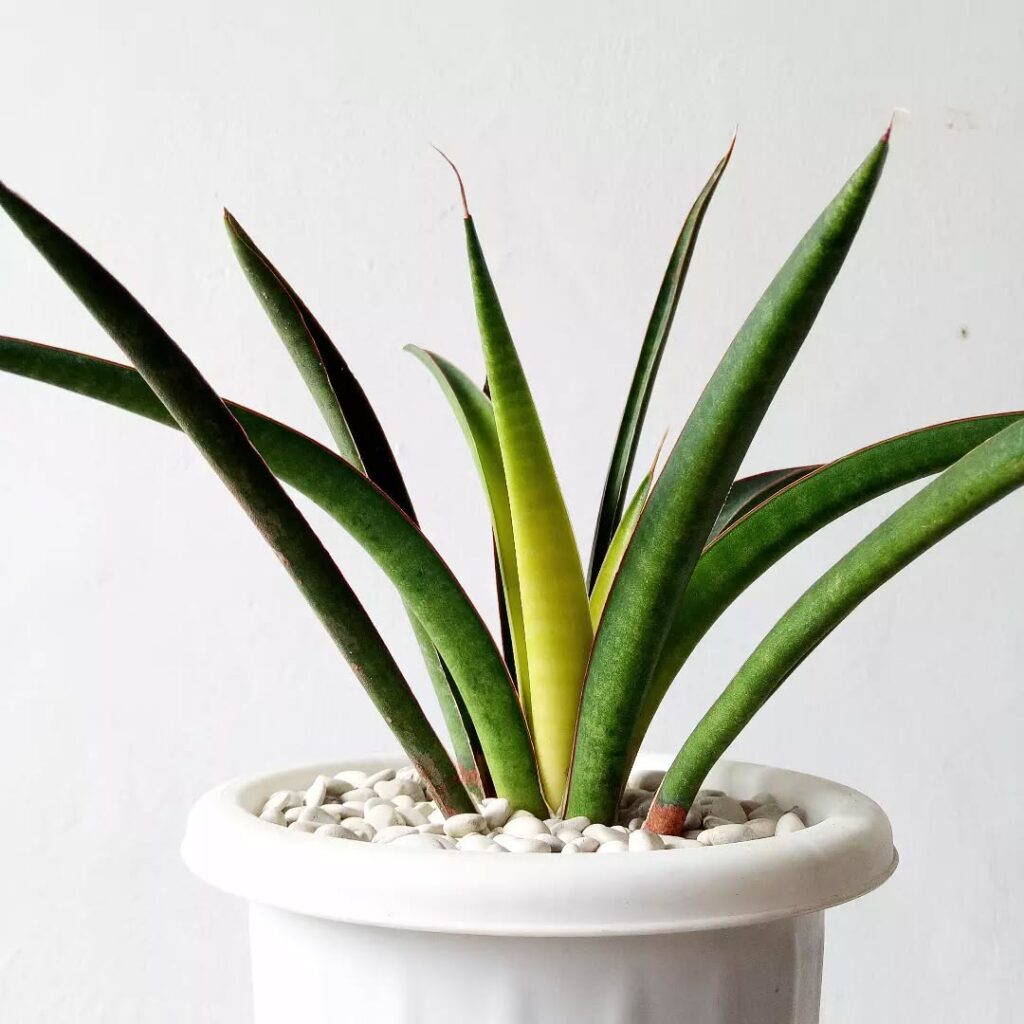
Sansevieria aethiopica is a succulent, evergreen perennial native to South and East Africa, including South Africa, Namibia, Botswana, Zimbabwe, Zambia, and Kenya. It grows from a rhizomatous rootstock, producing long, narrow, sword-shaped leaves that can reach up to 2 feet 5 inches tall. The foliage is green with pale horizontal markings, sometimes appearing glaucous, giving it a slightly frosted look.
This species thrives in dry, open environments, such as savannahs and bushveld, preferring well-drained sandy or rocky soil. It is highly drought-tolerant and can form dense stands under tree canopies. When in bloom, it produces creamy, scented, whitish-yellow tubular flowers on tall flowering stems, followed by reddish-orange berries that attract birds. Traditionally, its fibrous leaves have been used for making ropes and bowstrings, while its rhizomes serve as a water source in arid regions.
Sansevieria aethiopica ‘Variegata’
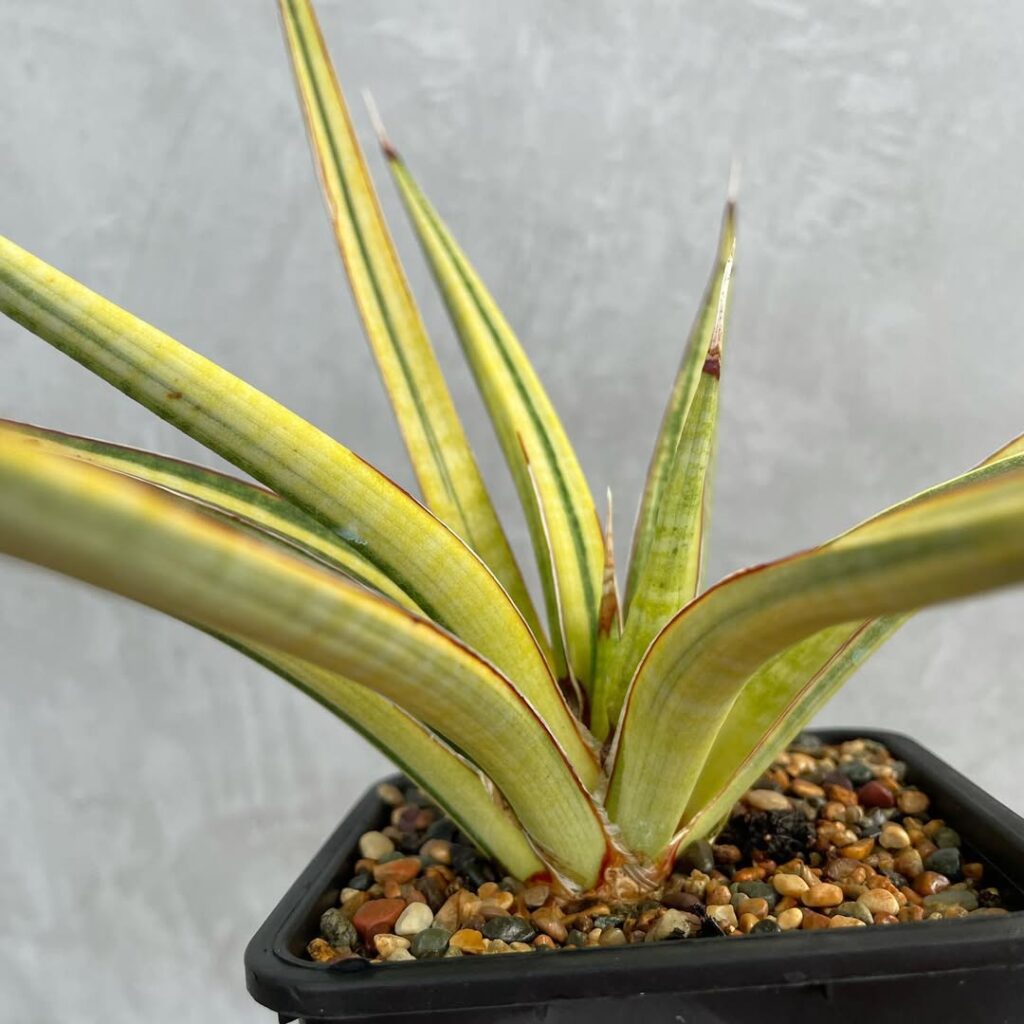
Sansevieria ‘Agatha’
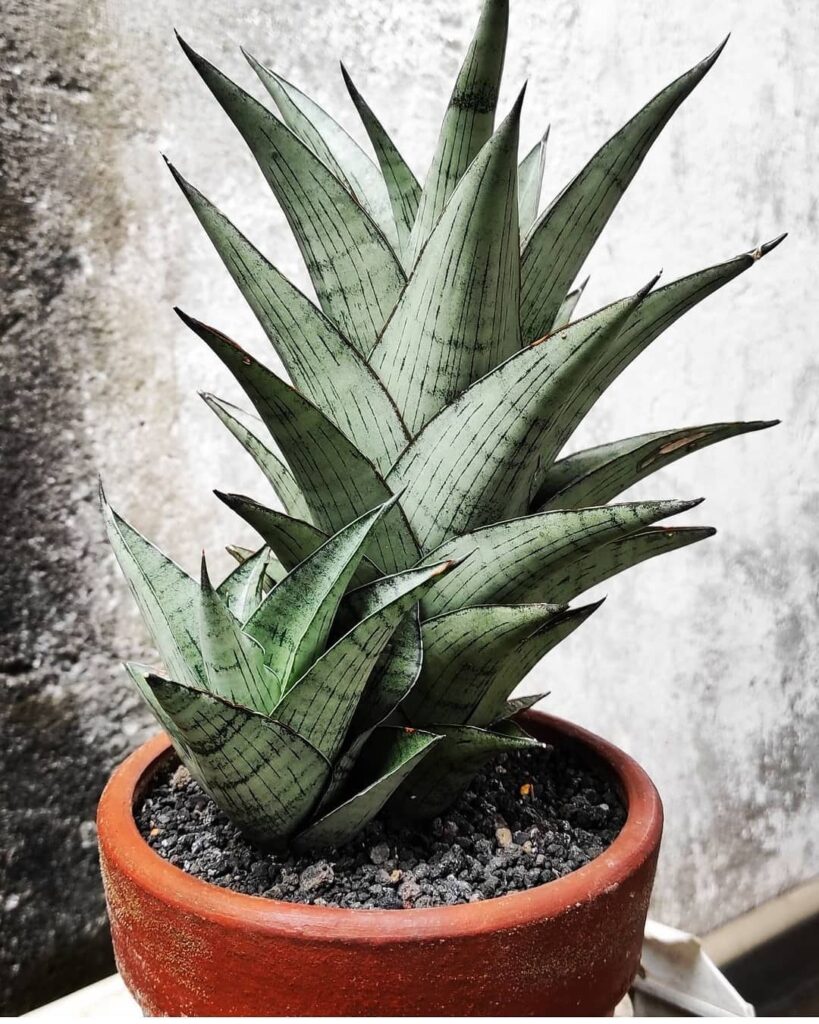
Sansevieria ‘Agatha’ is a compact, upright-growing snake plant cultivar known for its thick, pointed leaves arranged in a rosette formation. The foliage is greenish-gray with dark green horizontal stripes, creating a textured, architectural appearance. Its sturdy leaves contribute to its low-maintenance nature, making it an excellent choice for indoor spaces.
Sansevieria ‘Andaman’
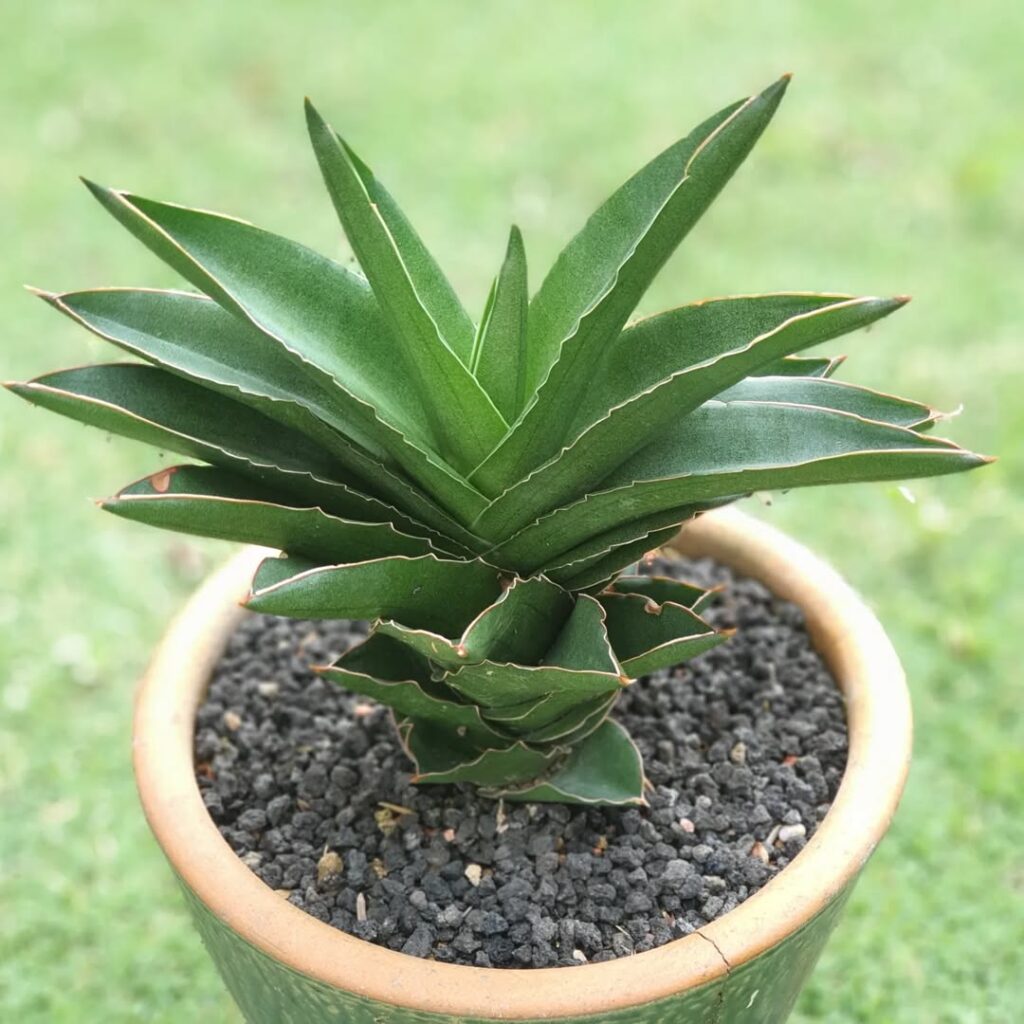
Sansevieria hybrid ‘Andaman’ is a Thai-bred cultivar developed by the renowned hybridizer Suan Unyamanee. This variety exhibits a unique growth transition, initially forming a spiral leaf arrangement before shifting into a distichous (fan-like) formation as it matures.
Its thick, dark green leaves feature light-colored edges, adding contrast to its structured appearance. The foliage is rigid and upright, contributing to its architectural presence. Like other Sansevieria hybrids, ‘Andaman’ thrives in bright, indirect light, requires minimal watering, and benefits from a well-draining, rocky soil mix to prevent excess moisture retention. Its gradual transformation in leaf orientation makes it a fascinating addition to any collection.
Sansevieria ‘Andaman Variegata’
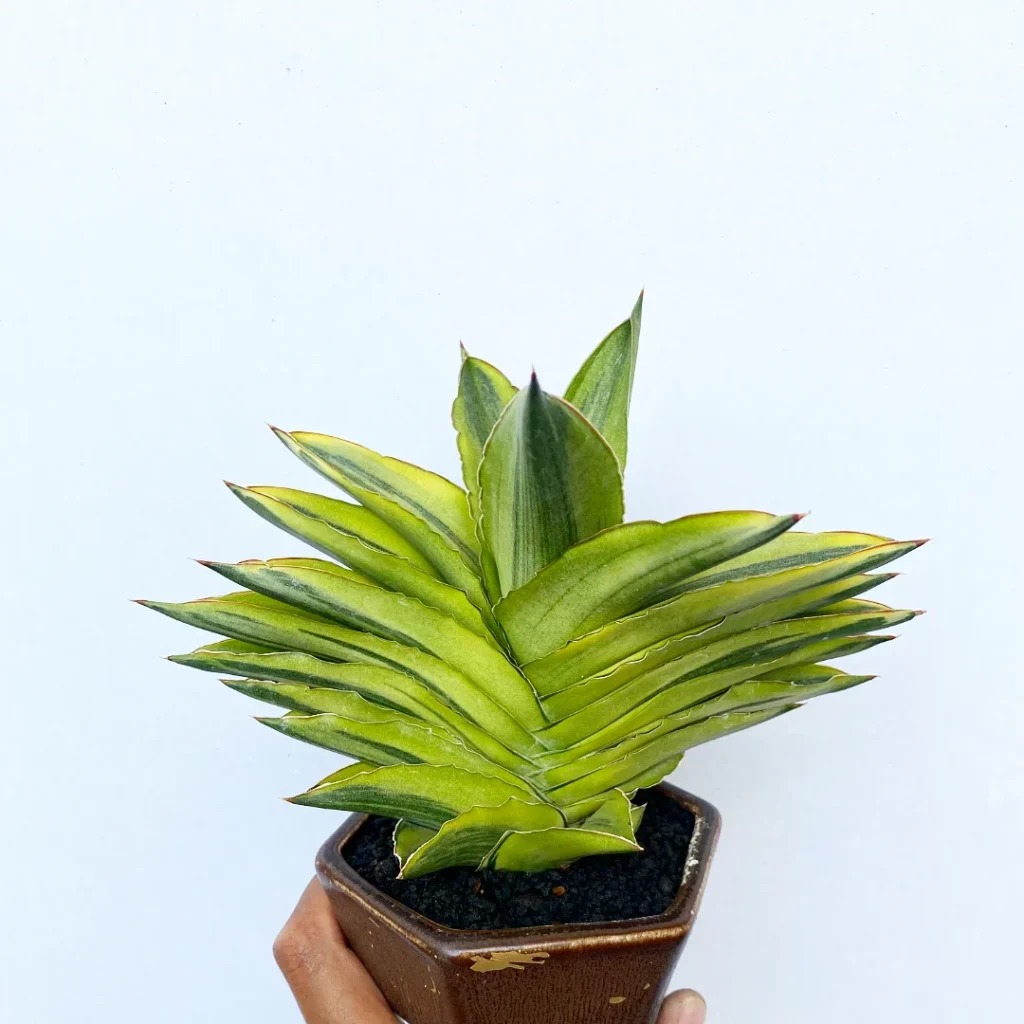
Sansevieria arborescens

Sansevieria arborescens, now classified under Dracaena, is a succulent perennial native to Kenya and Tanzania. It features long, spear-shaped leaves that grow in a rosette formation, reaching over 2 feet tall. The foliage is thick, flexible, and slightly glossy, with a deep green coloration.
This species thrives in warm, dry climates and prefers well-draining soil. It produces white flowers on a central flowering spike, adding a delicate contrast to its structured leaves. Like other snake plants, S. arborescens is drought-tolerant, requiring minimal watering and thriving in bright, indirect light or partial sun. Its tree-like height makes it a striking addition to indoor and outdoor plant collections.
Sansevieria arborescens ‘Variegata’
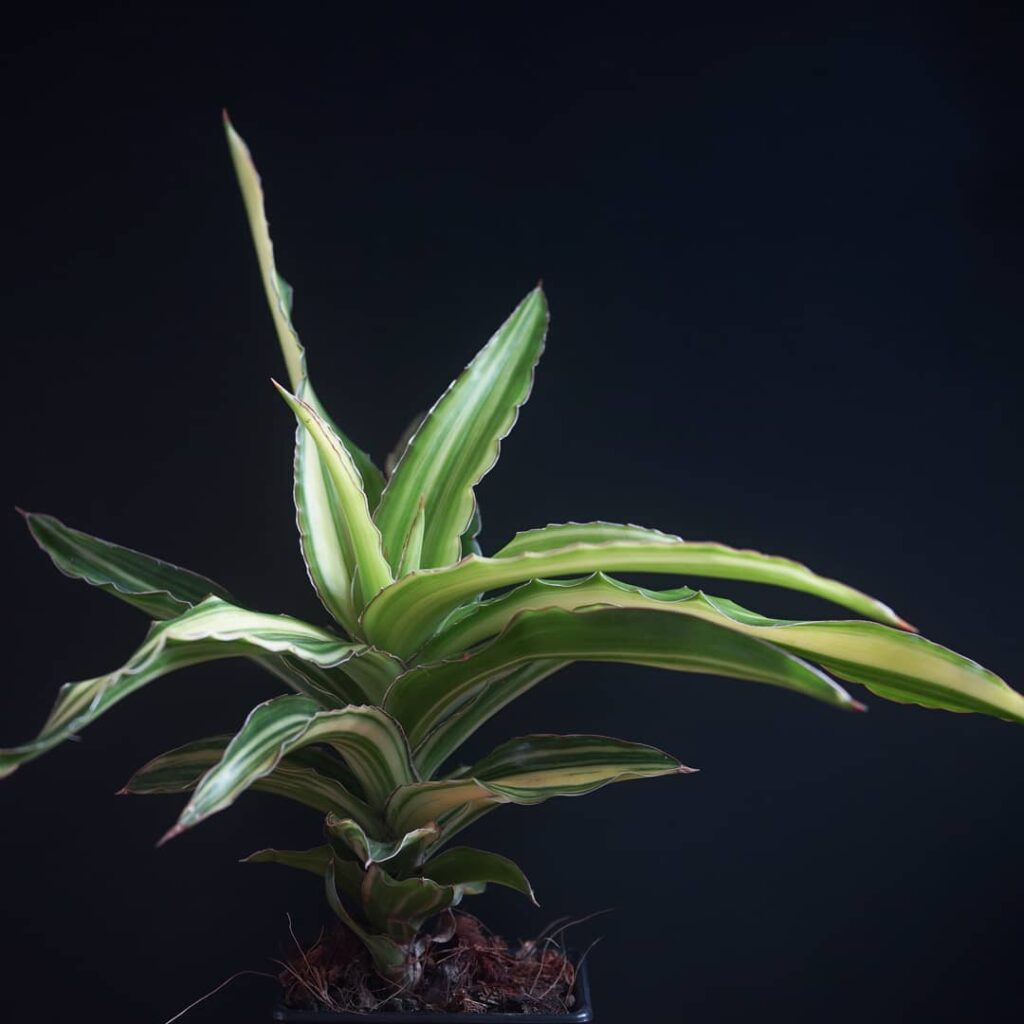
Sansevieria ‘Asahi’
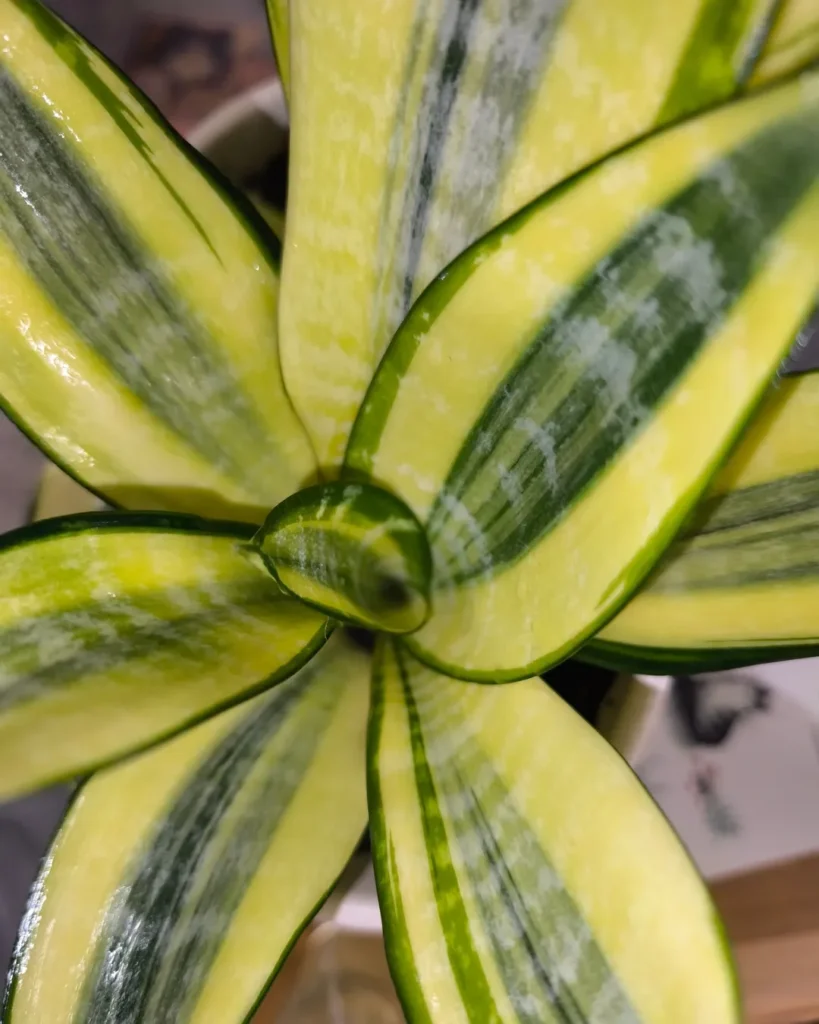
Sansevieria ‘Asahi’ is a rare, variegated cultivar admired for its broad, upright leaves with a striking variegated effect.
Sansevieria aubrytiana
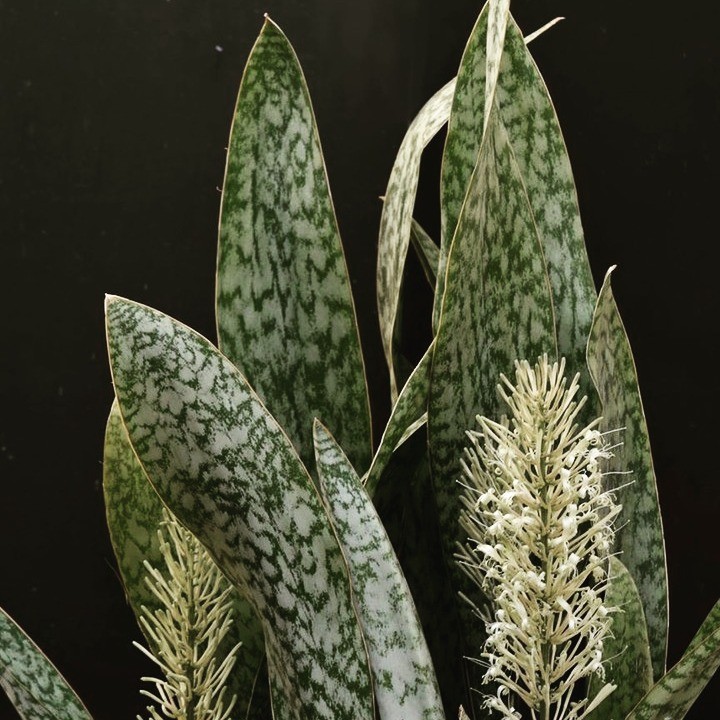
Sansevieria aubrytiana is a medium-sized snake plant with elongated, sword-shaped leaves that display a dark bottle-green base color accented by lighter green horizontal variegation. This variety is native to tropical regions of Africa, including Madagascar, where it has adapted to unpredictable rainfall by storing water in its thick foliage.
Indoors, S. aubrytiana typically grows up to 2 feet tall, but when planted outdoors, it can exceed 3 feet in height. While it can produce cream to off-white flowers, sometimes with a pinkish hue, blooming is rare and depends on optimal conditions. It thrives in bright indirect light, prefers temperatures between 60-85°F, and requires well-draining loamy soil. Like other snake plants, it is drought-tolerant, needing water only when the soil is dry.
Sansevieria bacularis

This variety stands out with its long, thick leaves, which can grow up to 5 feet 7 inches—almost as tall as some people. The dark green foliage features lighter horizontal bands, adding texture and visual appeal. Unlike some snake plants, the tips of its leaves are soft, making it a bit more approachable.
In spring, this sansevieria produces white flowers with a bold purple stripe. It thrives in bright, warm locations and can be moved outdoors during summer. Like most snake plants, it’s low maintenance—water sparingly when the soil dries out, as it tolerates periods of dryness well. However, it’s not frost-hardy, so bring it inside before temperatures drop.
Sansevieria bagamoyensis
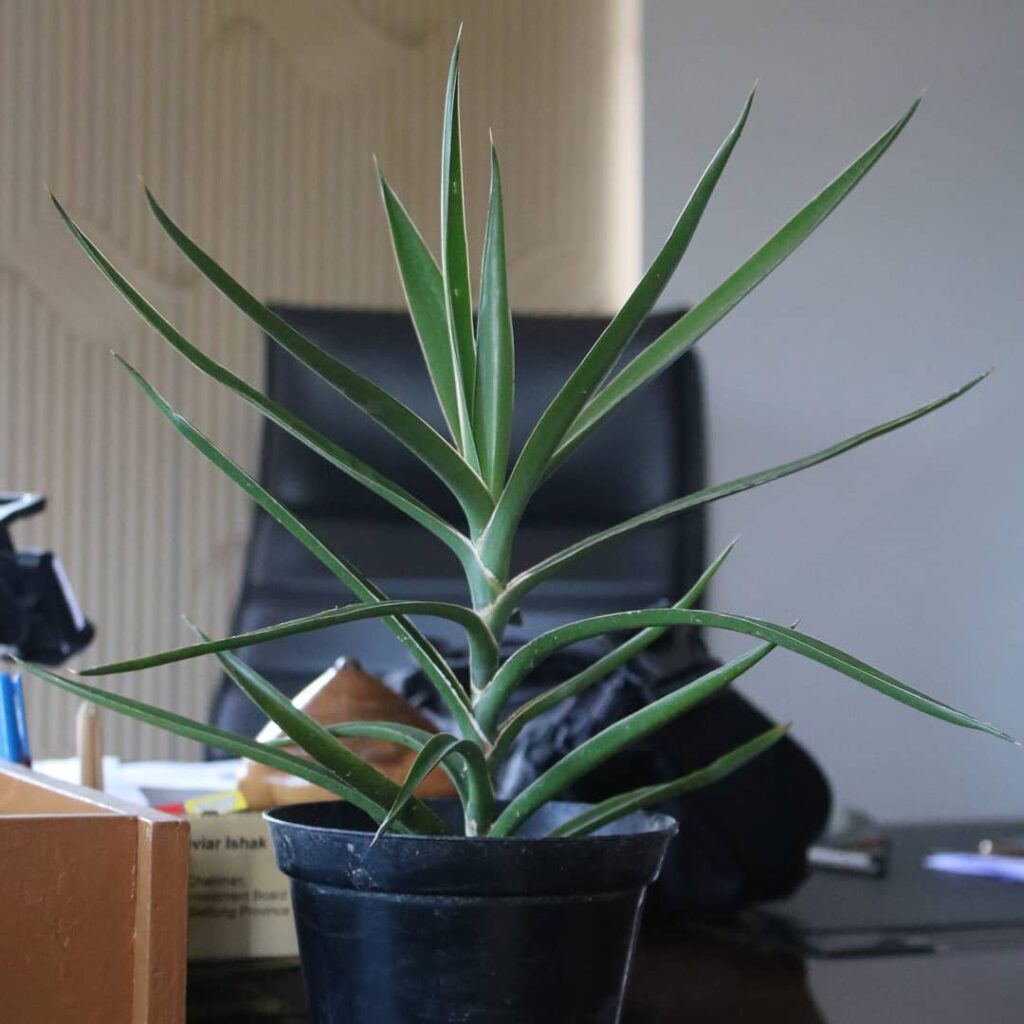
Sansevieria bagamoyensis, now classified as Dracaena bagamoyensis, is a succulent species native to Kenya and Tanzania. It features long, slender, flat leaves that are narrower and more brittle compared to its close relative, Dracaena arborescens. The foliage is typically dark green, with a rigid, upright growth habit, making it a structural and ornamental plant.
Sansevieria bagamoyensis is often confused with Sansevieria arborescens, but its longer, thinner leaves distinguish it.
Sansevieria ballyi
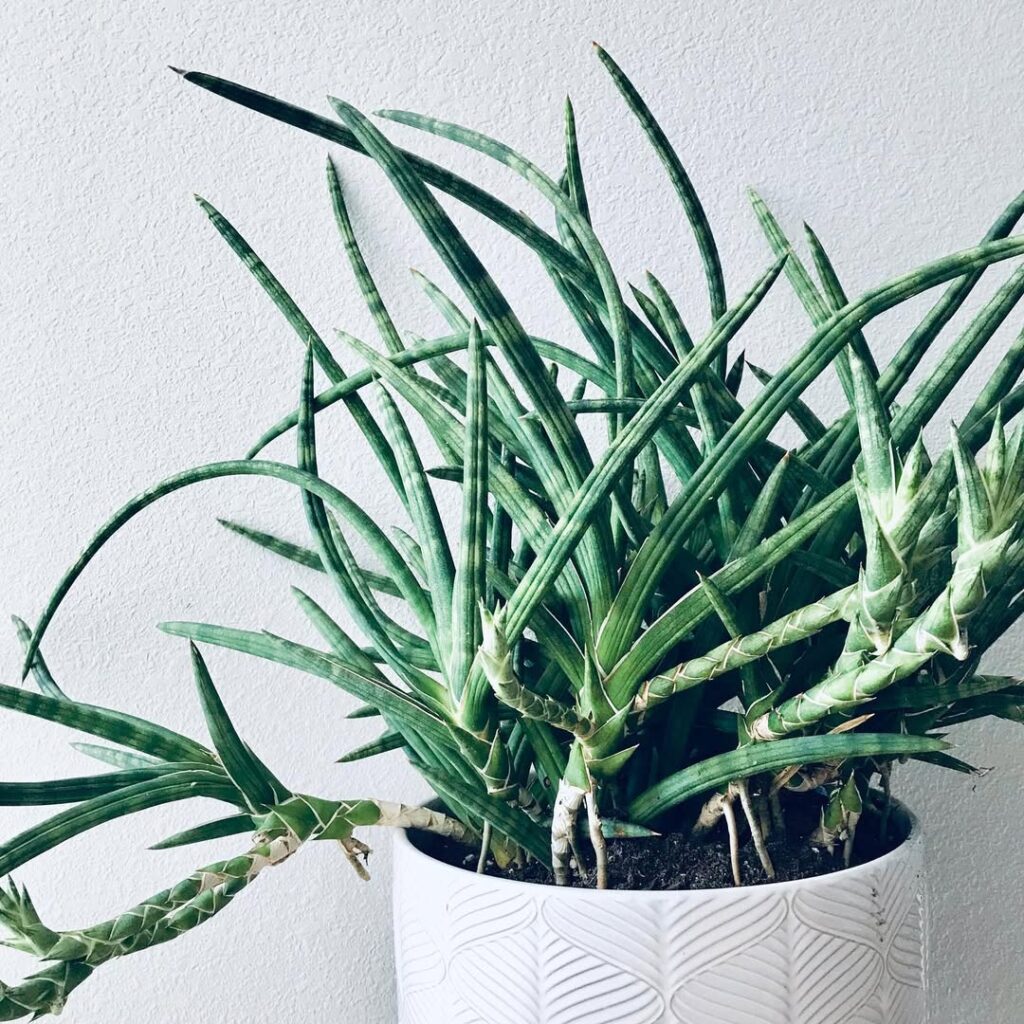
Sansevieria ballyi, also known as dwarf Sansevieria, is a compact, slow-growing succulent native to Kenya and Tanzania. It features dark green, nearly cylindrical leaves with light green cross-banding, arranged in symmetrical rosettes. The leaves are stiff and recurved, tapering to a sharp red-brown tip, adding to its distinctive appearance.
This species spreads through above-ground stolons, which extend horizontally and form new plantlets, making it ideal for ground cover or clustered arrangements
Sansevieria ballyi ‘Minnie’
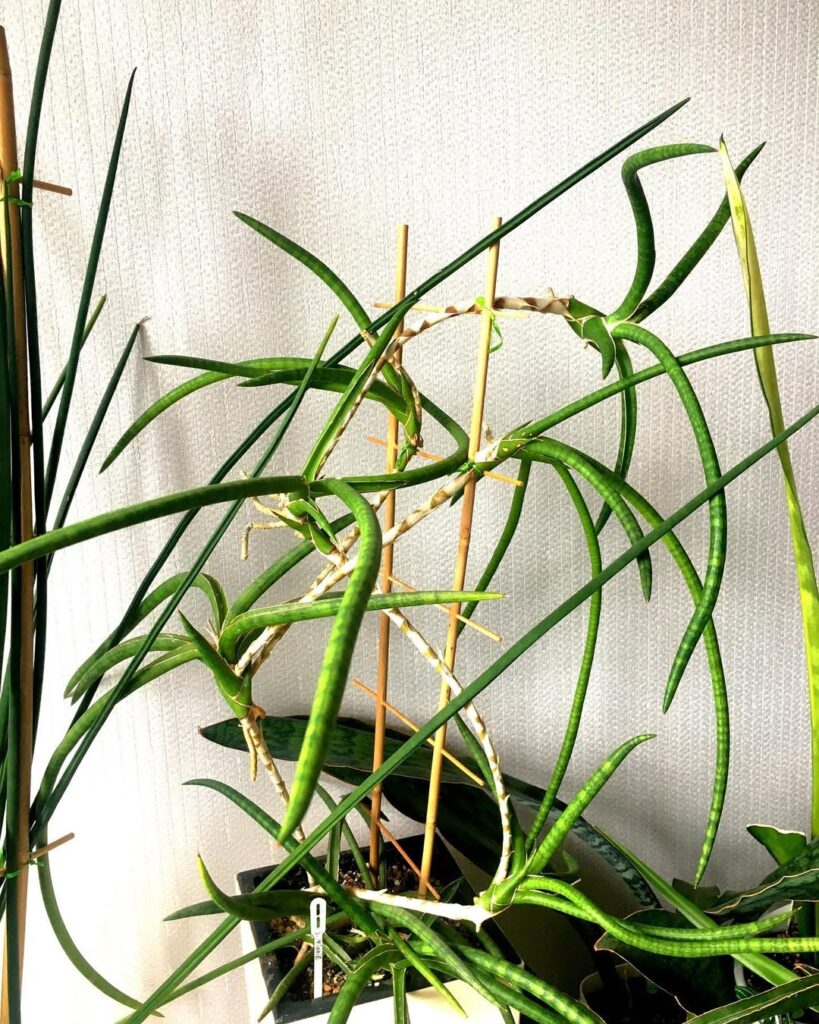
Sansevieria ballyi ‘Minnie’ is a dwarf cultivar of Sansevieria ballyi, featuring short, stubby leaves that grow in a compact rosette formation. The foliage is dark green with light green cross-banding, creating a textured appearance. Unlike the standard S. ballyi, ‘Minnie’ remains smaller in size, reaching only about 5 inches across before sending out above-ground stolons to propagate.
Sansevieria ballyi ‘Star’

Sansevieria ballyi ‘Star’ is a compact, dwarf Sansevieria with dark green, thick, recurved leaves that grow in a symmetrical rosette formation. The foliage features light green cross-banding, adding subtle texture to its appearance. This variety spreads through above-ground stolons, allowing it to form dense clusters over time.
Sansevieria bella
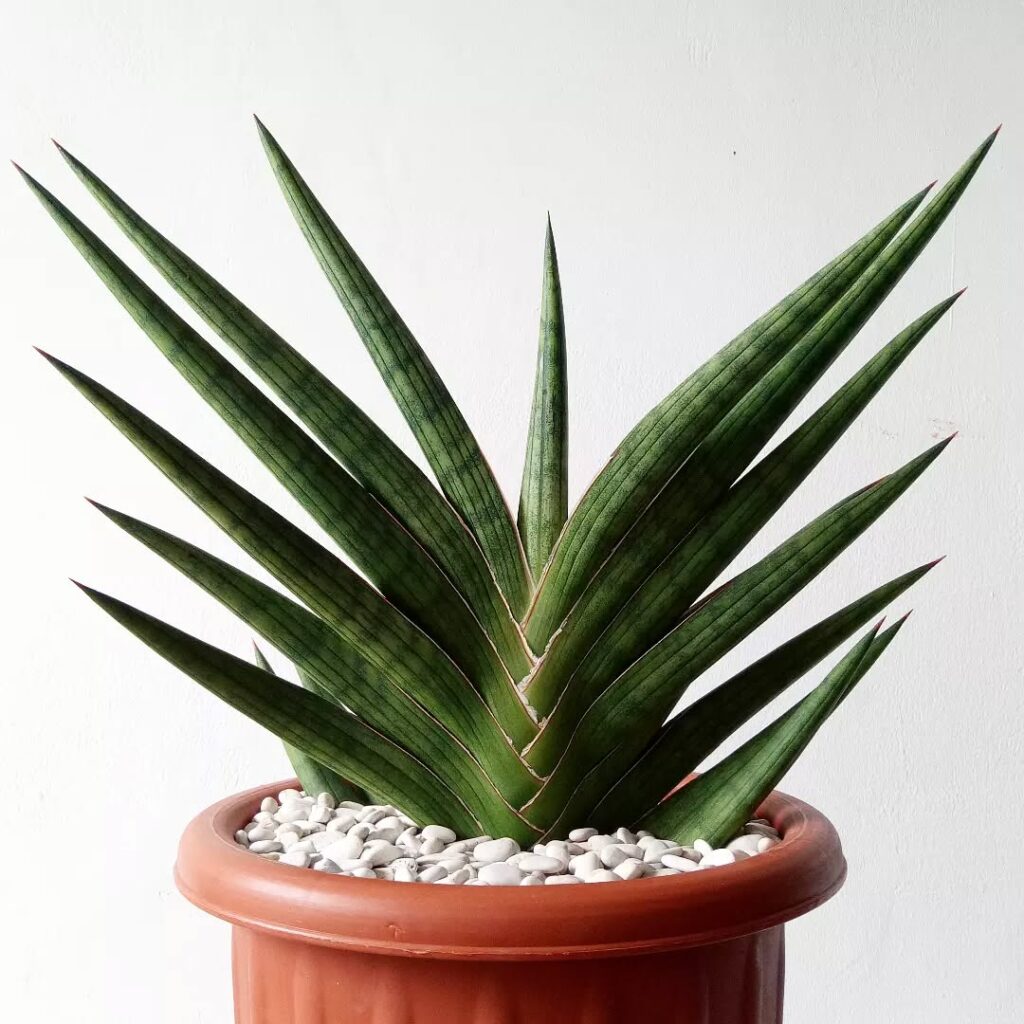
Sansevieria bella is a compact, upright-growing snake plant with long, pointed leaves arranged in a fan-like pattern. Its foliage is deep green with darker horizontal stripes, creating a textured, visually striking appearance. The leaves are rigid and slightly curved, contributing to its structured form.
Sansevieria bhitalae
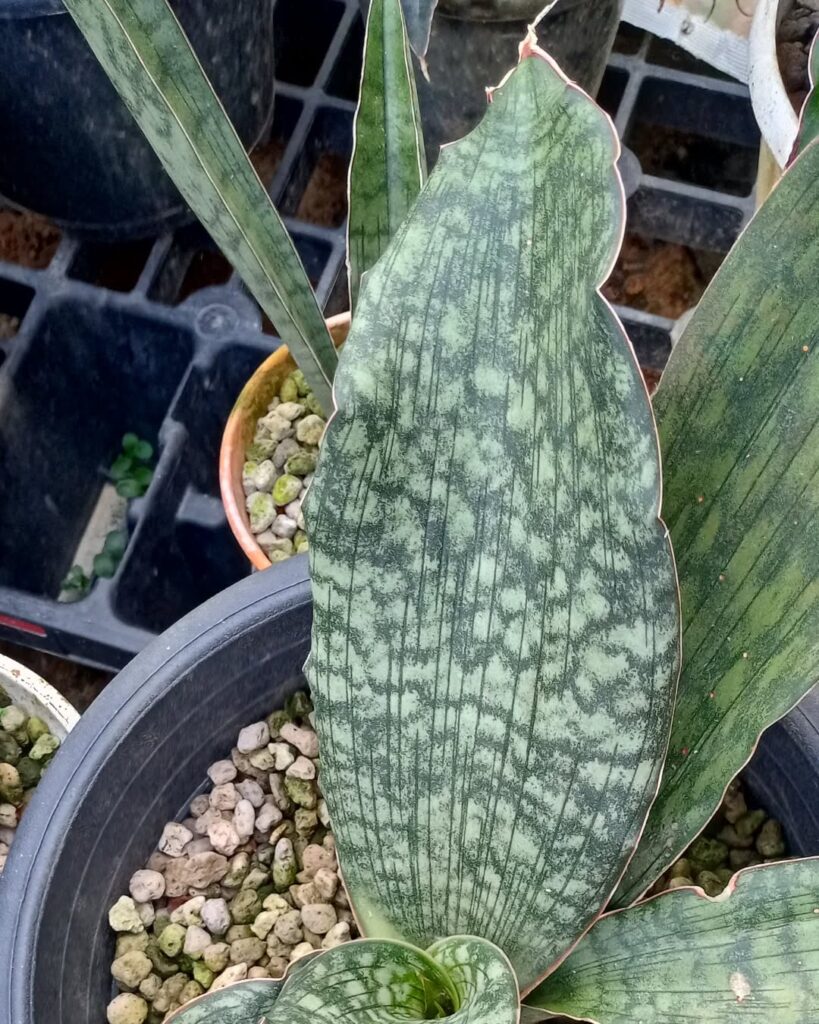
Sansevieria bhitalae, now classified as Dracaena bhitalae, is a rare and structurally impressive species native to East Africa. It features thick, upright leaves with a blue-gray hue, often displaying a slightly wavy brown edge. The foliage grows in a vertical, clumping habit, making it a bold architectural plant.
Sansevieria bhitalae ‘Silver Blue’

Sansevieria bhitalae ‘Silver Blue’ is a rare and visually striking cultivar known for its silvery-blue foliage with a smooth, leathery texture. The leaves are thick and slightly curved, forming a structured, upright growth habit. This variety is admired for its subtle color variations, which can range from pale silver-green to deeper blue-green tones, depending on light exposure.
Sansevieria bhitalae ‘Super Clone’
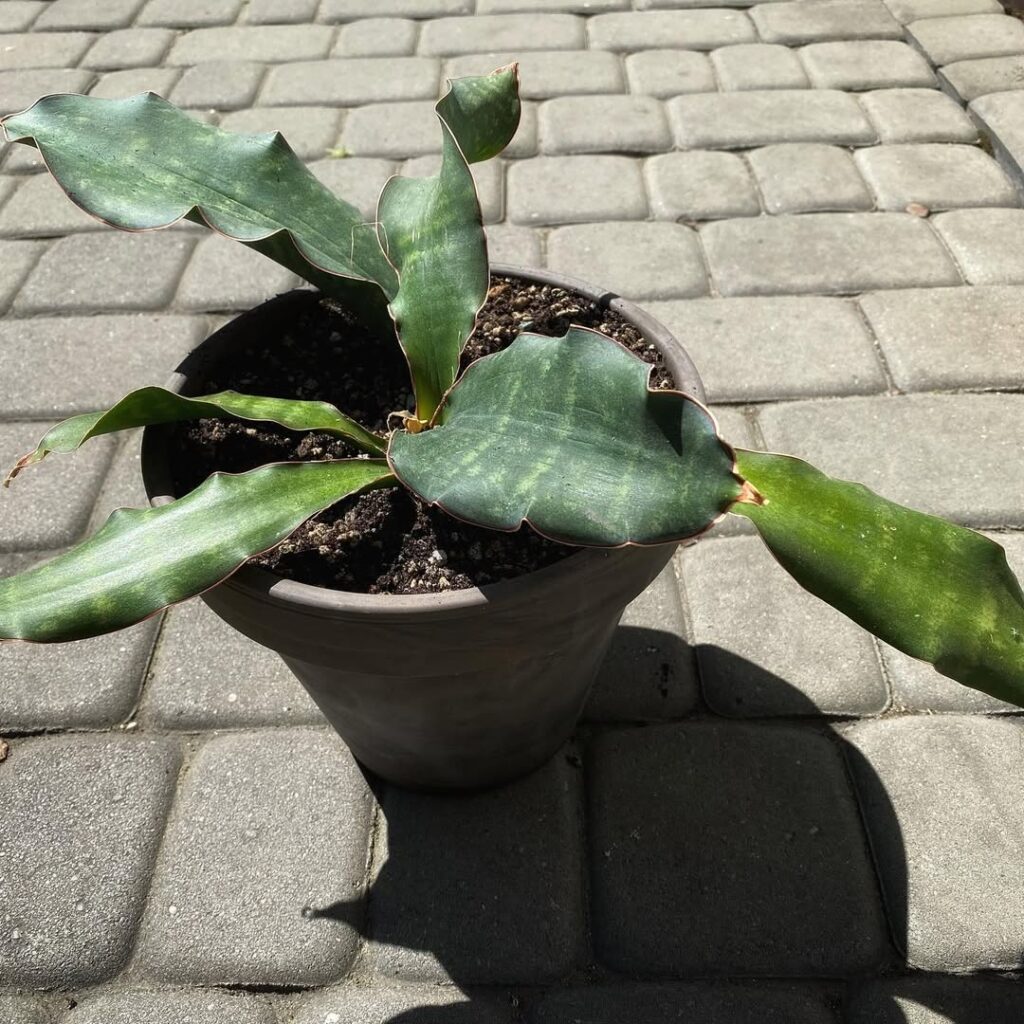
Sansevieria bhitalae ‘Super Clone’ is a robust, upright-growing snake plant with thick, blue-gray leaves that can reach 4 to 6 feet tall. The foliage has a slightly wavy brown edge, adding to its distinctive appearance. This cultivar is known for its strong vertical growth, making it a striking architectural plant.
Originally sold under the name Sansevieria kirkii ‘Super Clone’, this plant was later classified as Sansevieria bhitalae in 2018. It remains a collector’s favorite due to its bold structure and resilience.
Sansevieria braunii
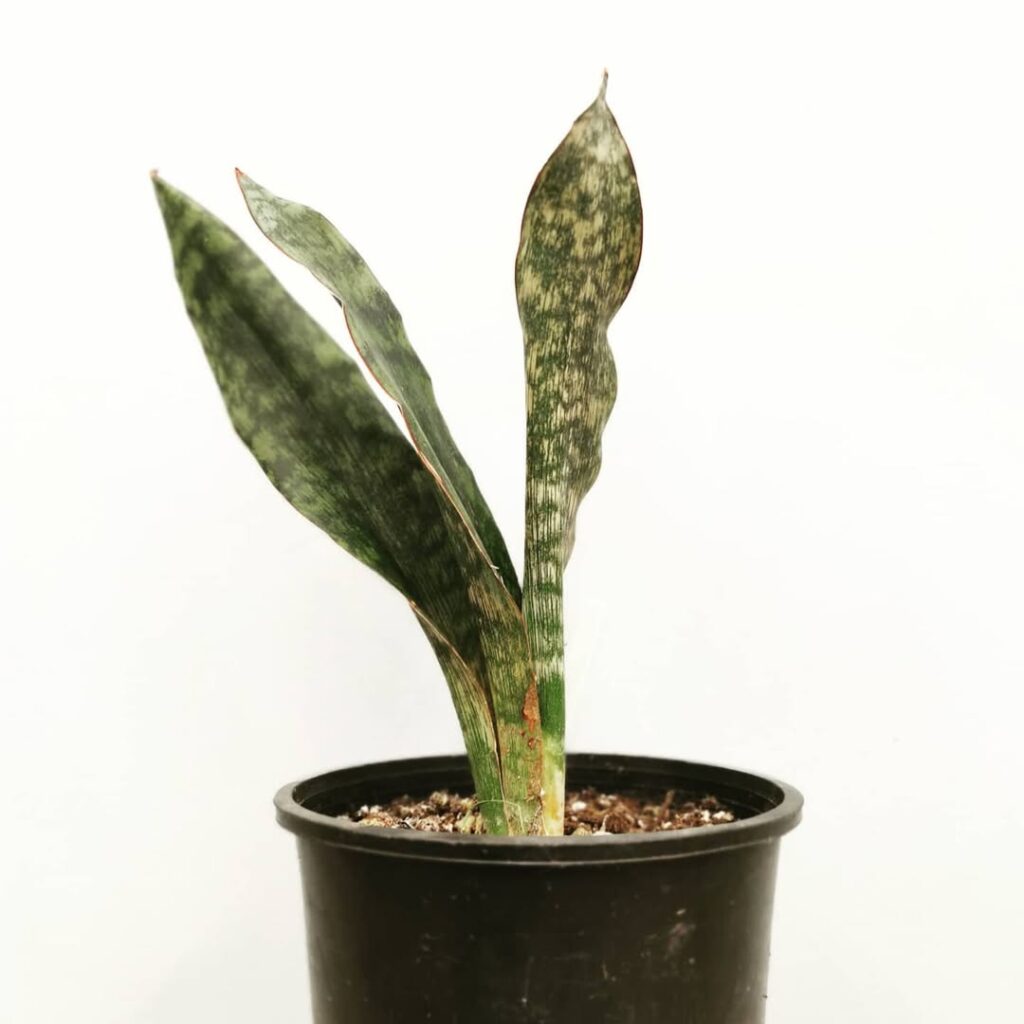
Sansevieria braunii, now classified as Dracaena testudinea, is a rare and structurally unique species originally described in 1910. It features thick, upright leaves with a deep green coloration and subtle cross-banding, giving it a textured appearance. The foliage grows in a vertical, clumping habit, making it a bold architectural plant.
Sansevieria ‘Bunlue Torch’
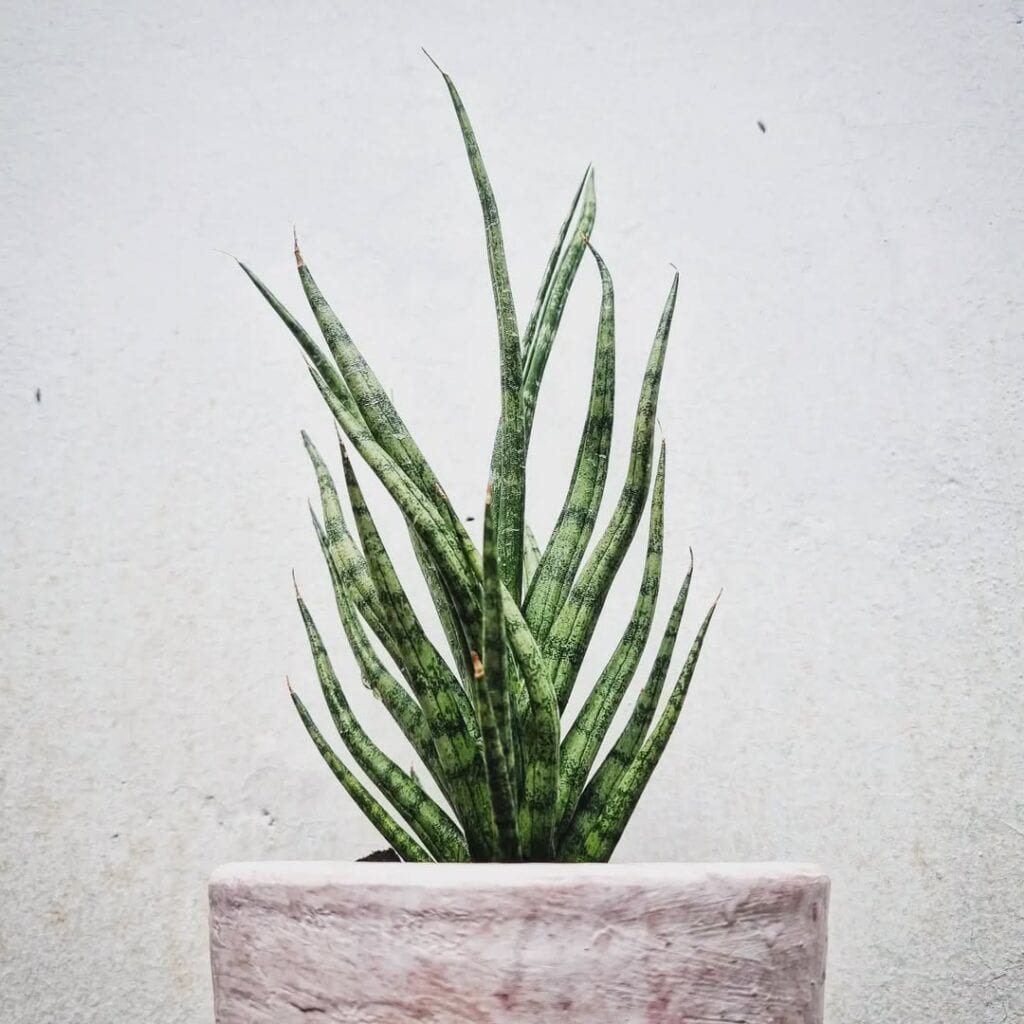
Sansevieria ‘Bunlue Torch’ Variegated is a rare and visually striking hybrid known for its distinctive foliage. This variety features long, thin, cylindrical leaves that radiate outward, resembling the flames of a torch. The variegation presents as beautiful striped patterns, adding to its ornamental appeal.
Sansevieria ‘Bruda’
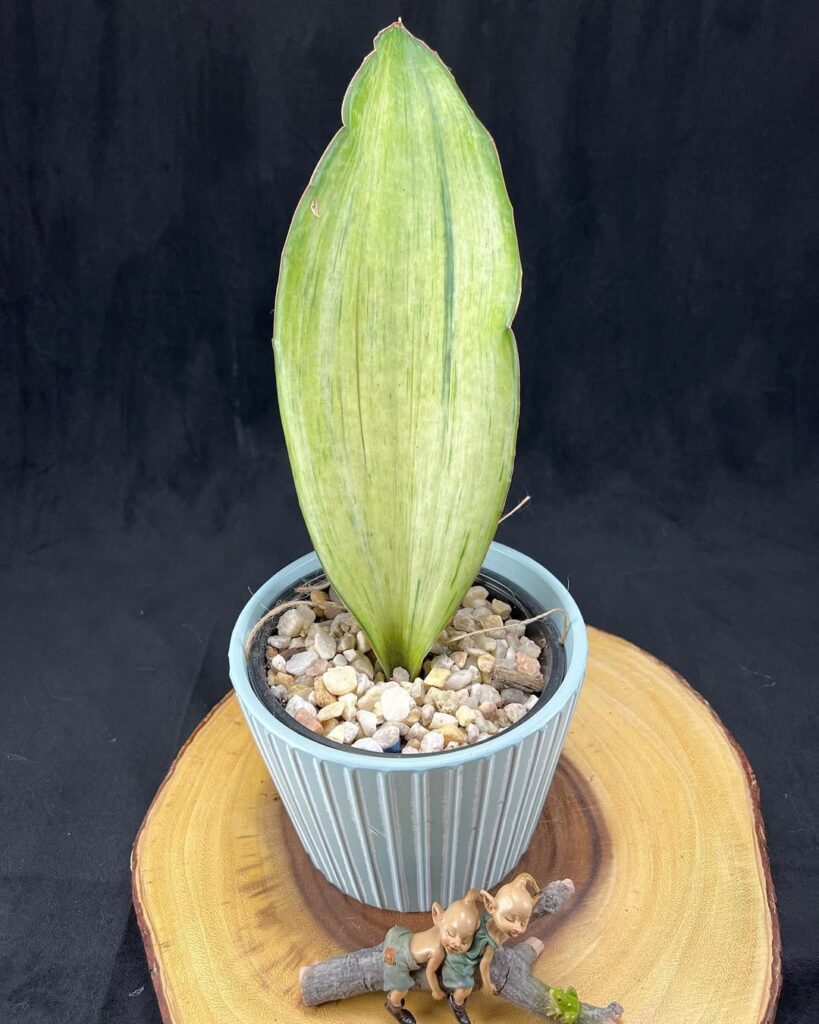
Sansevieria ‘Bruda’ is a stunning hybrid of S. Masoniana and S. Elliptica variegated, known for its broad, thick leaves with striking variegation. As the plant matures, its variegations gradually lighten, sometimes turning almost white, creating a dramatic transformation over time.
Sansevieria burmanica
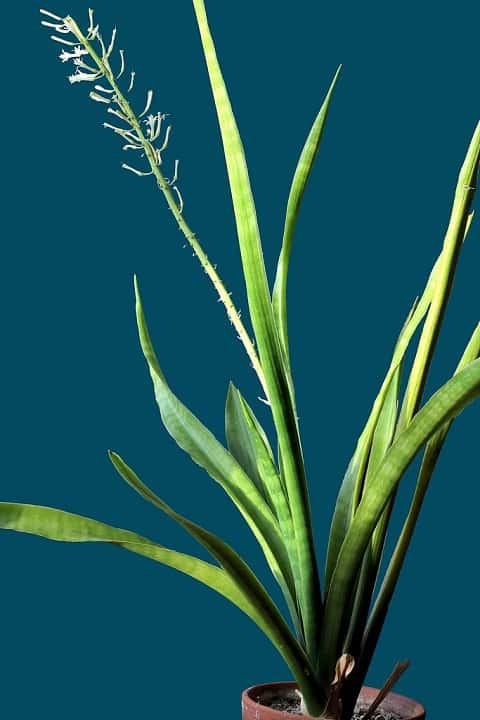
Native to India, this variety forms an upright rosette of wide, rigid leaves that can reach 18-30 inches tall (up to 2 feet 6 inches) and up to 5 inches across. The leaves have a green base color with lighter horizontal bands, and as the plant matures, the edges may turn white, adding a distinct contrast.
Its tall white flower spikes appear in panicle-like clusters, growing up to 2 feet 6 inches high. To keep it healthy, place it in a sunny or partially shaded location with temperatures around 68°F, avoiding anything below 57°F. Water moderately, reducing frequency in winter. A sandier soil mix works best, and applying fertilizer every two weeks in summer supports steady growth.
Sansevieria canaliculata
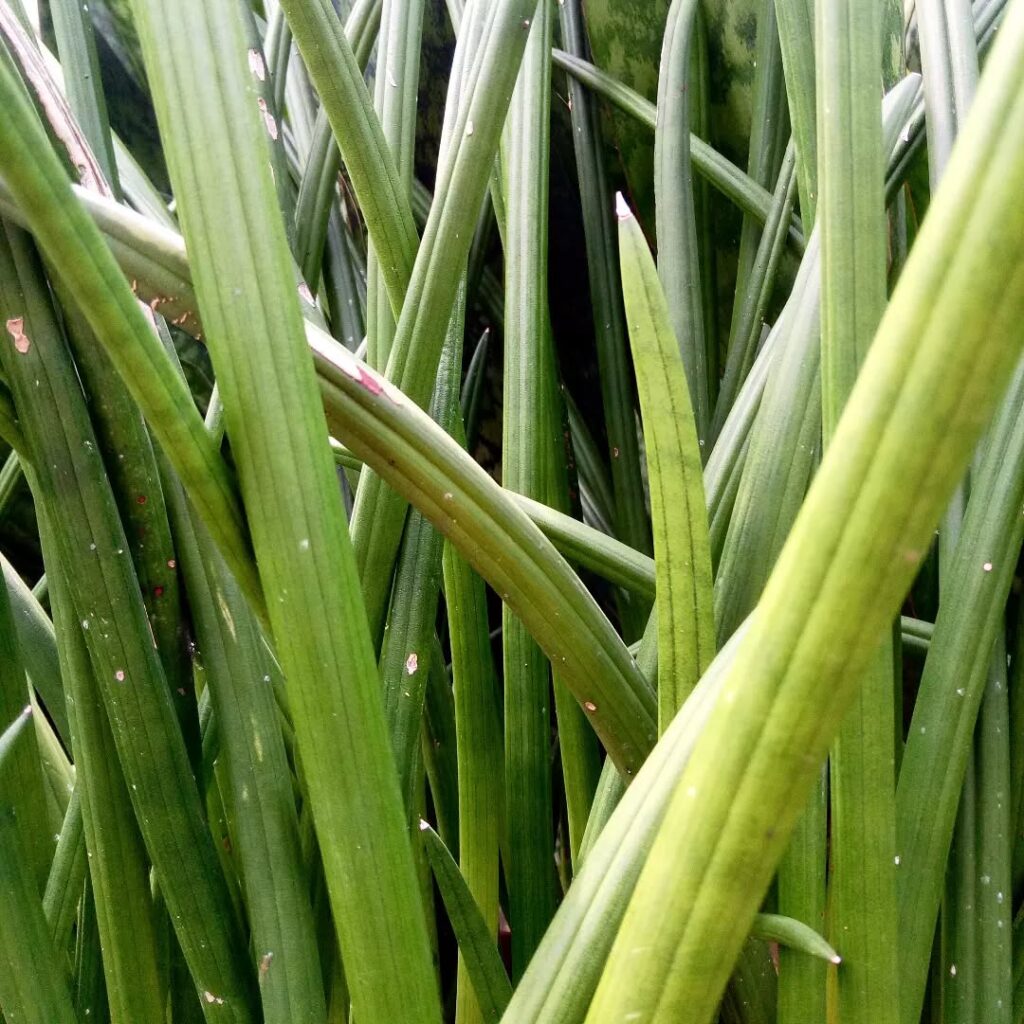
Sansevieria canaliculata, now classified as Dracaena canaliculata, is a stemless succulent native to Madagascar. It features cylindrical, upright leaves that grow solitary or in pairs from underground rhizomes. The foliage is pale to dark green, with longitudinal grooves running along its length, giving it a channeled texture.
Sansevieria canaliculata ‘Dwarf’
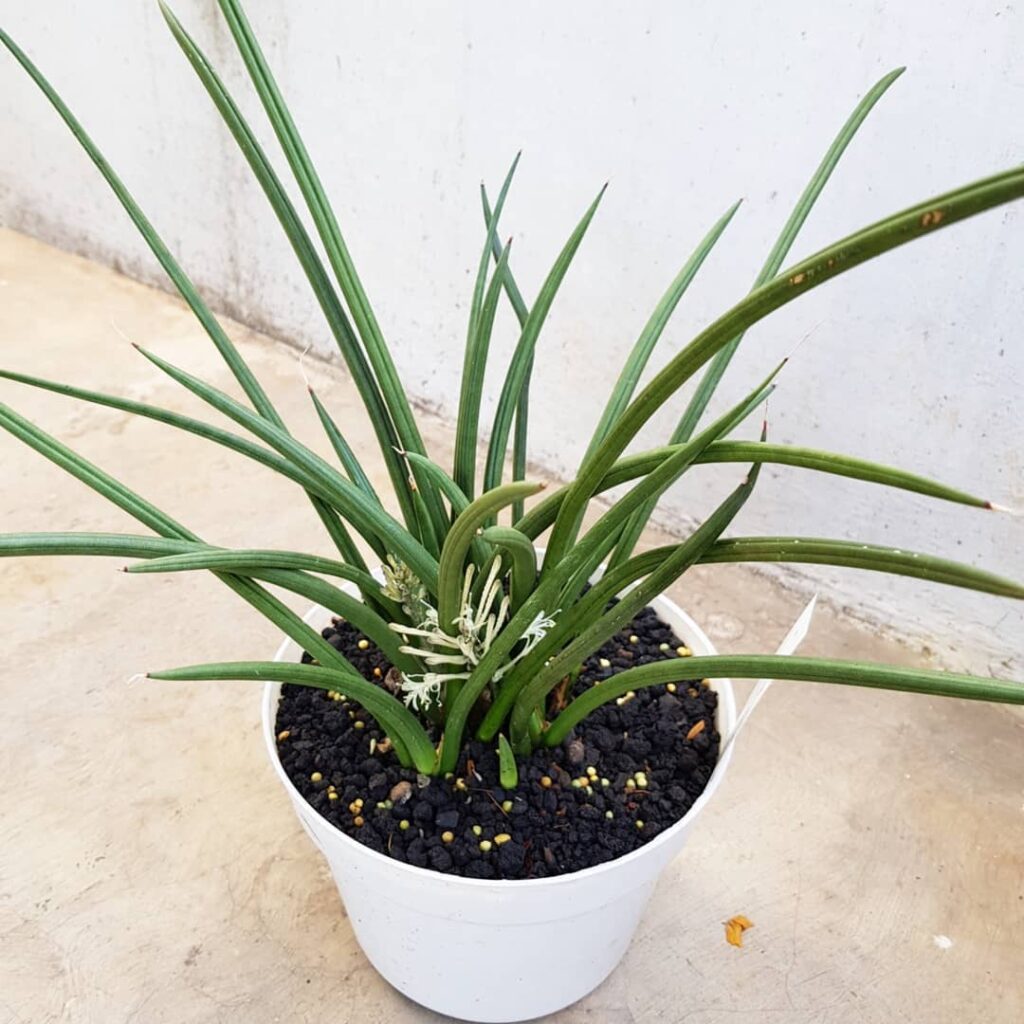
Sansevieria canaliculata ‘Dwarf’ is a compact variant of Sansevieria canaliculata, featuring shorter, cylindrical leaves with distinct longitudinal grooves. Unlike the standard species, this dwarf form remains smaller in stature, making it ideal for tight spaces and container gardening. Its pale to dark green foliage grows solitary or in pairs from underground rhizomes, maintaining a structured, upright habit.
Sansevieria caulescens
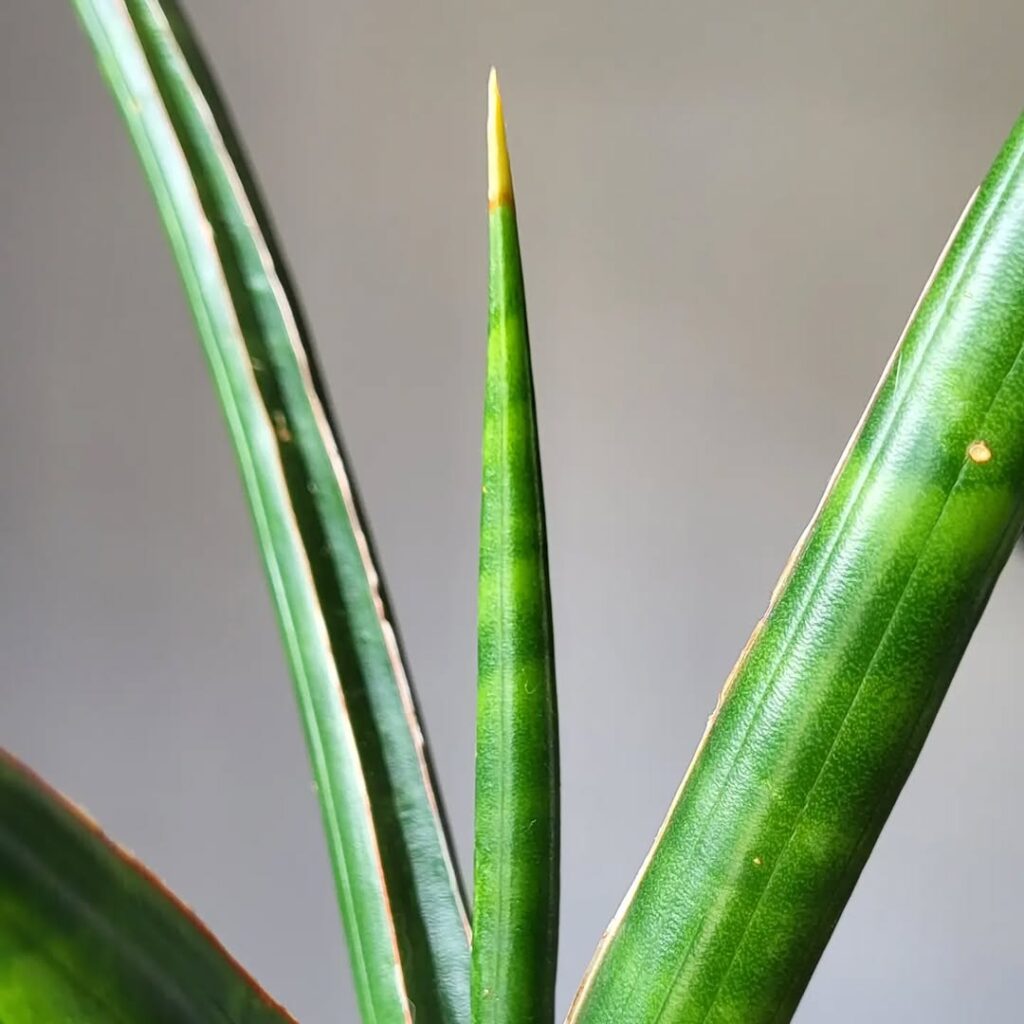
Sansevieria caulescens, now classified as Dracaena caulescens, is a stem-forming Sansevieria species native to East Africa. Unlike most snake plants, it develops elongated stems, with narrow, upright leaves growing along them. The foliage is deep green, sometimes featuring light cross-banding, and can reach up to 3 feet tall.
Sansevieria caulescens is sometimes referred to as the “African Traveler” due to its ability to spread through rhizomes, forming dense clusters over time.
Sansevieria chahinianii
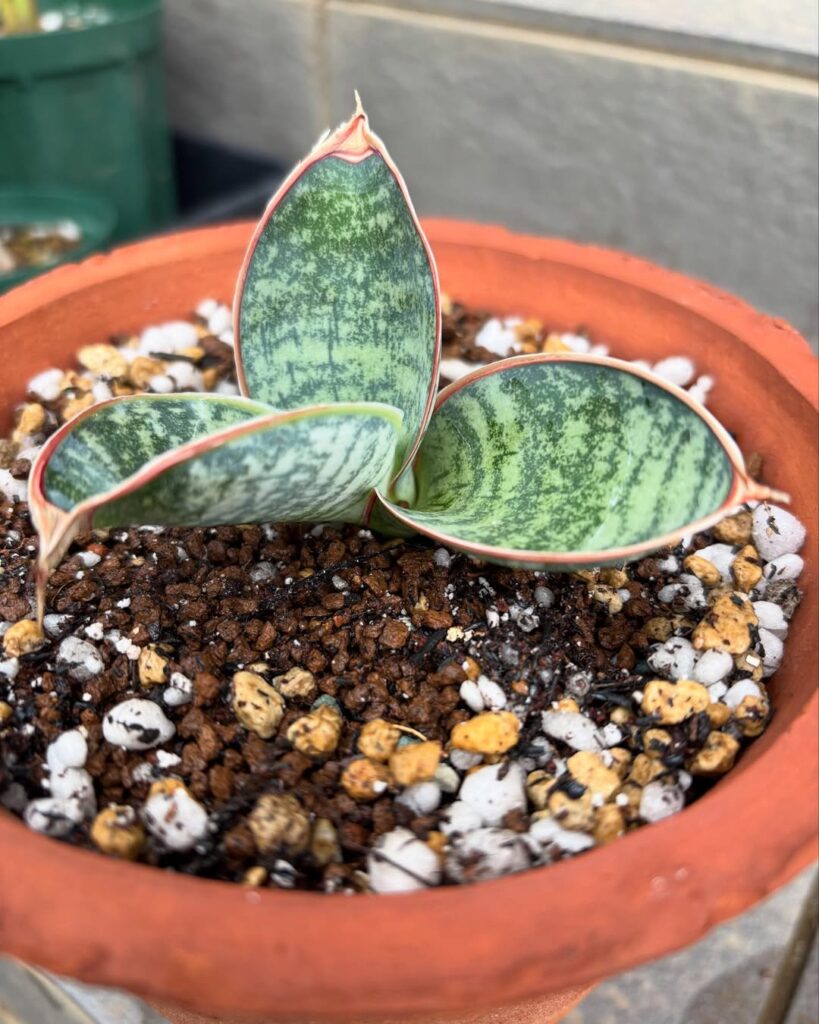
Sansevieria chahinianii, now classified as Dracaena chahinianii, is a compact, slow-growing species with thick, fleshy leaves that display a green and white marbled pattern with red edges. The foliage grows in a tight rosette formation, making it a visually striking and space-efficient plant.
Sansevieria chahinianii is sometimes referred to as “Mouse Ear” due to its rounded leaf shape. It remains a collector’s favorite for its unique coloration and compact form.
Sansevieria concinna
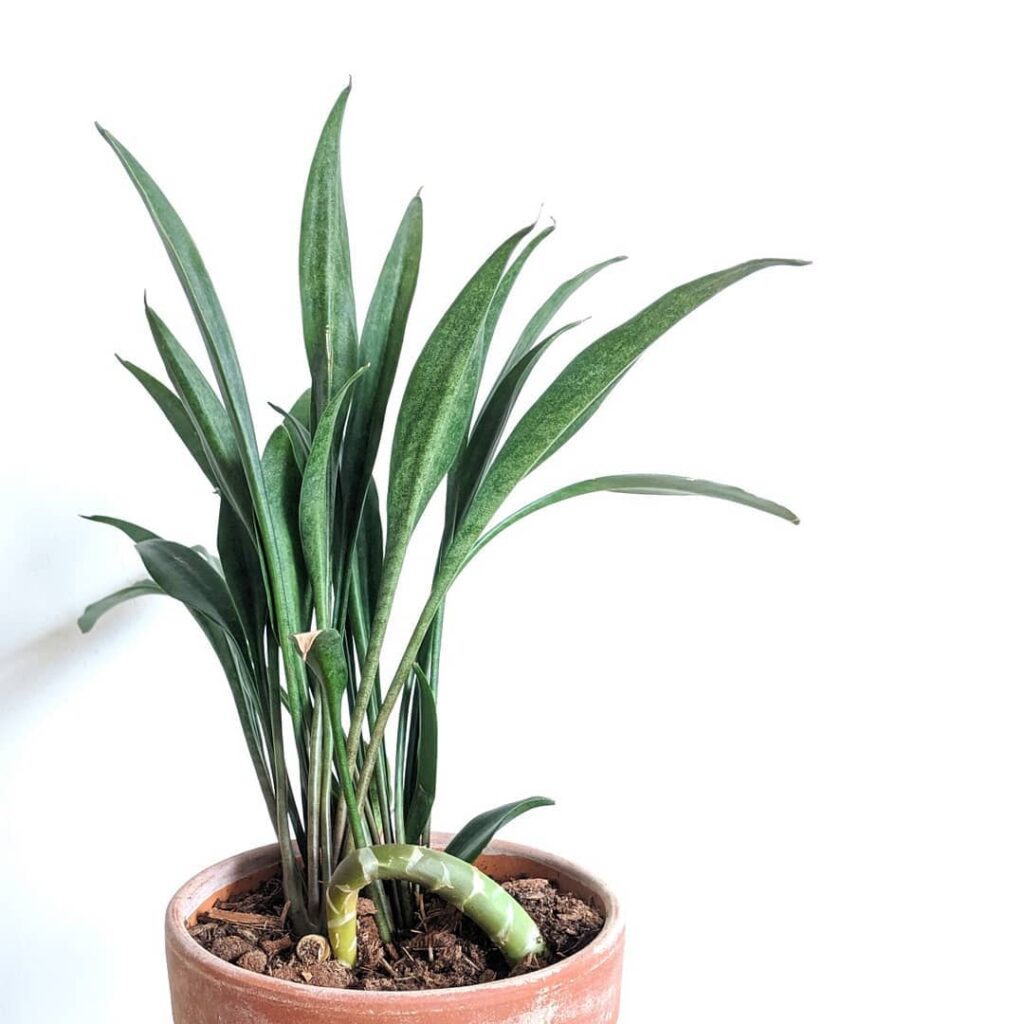
A lesser-known species from South Africa, Sansevieria concinna has sleek, lance-shaped leaves that grow upright from a thick rhizome, forming a rosette. Its foliage is smooth and green, with subtle pale crossbands, reaching 6-10 inches in length. Unlike some sansevieria species, its leaf edges are soft rather than rigid.
In its growing season, it produces white flower spikes ranging from 6-12 inches tall (up to 1 foot). This variety prefers shaded conditions and a stable temperature around 68°F. Allow the soil to dry slightly between waterings to prevent overwatering. A well-draining, slightly sandy soil mix is ideal, and fertilizing during spring through fall supports healthy development.
Sansevieria conspicua
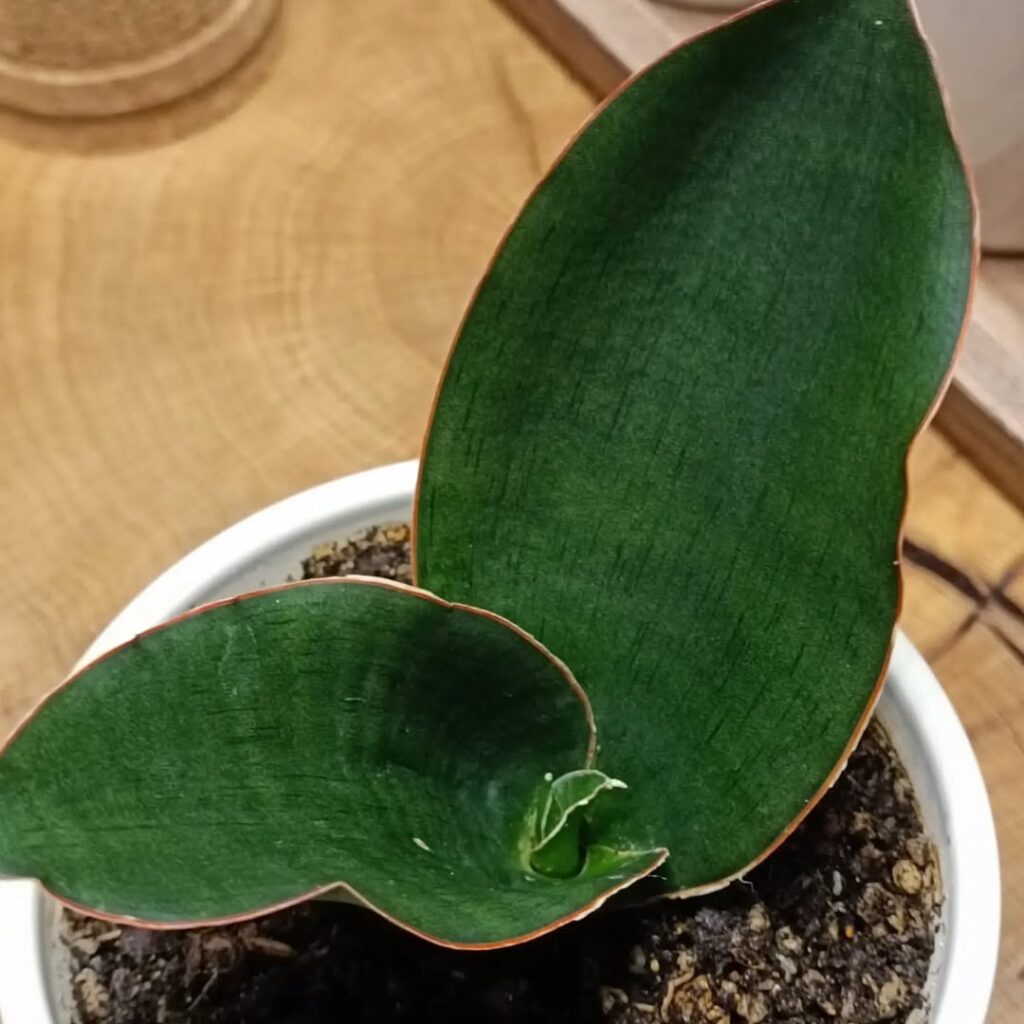
Sansevieria conspicua, now classified as Dracaena conspicua, is a rare, upright-growing succulent native to Kenya, Tanzania, and Malawi. It features dark green, lanceolate leaves with prominent longitudinal lines, creating a textured appearance. The foliage grows in a sub-erect to procumbent habit, with a reddish or purplish subterranean rhizome that branches in shallow soils.
Sansevieria cylindrica
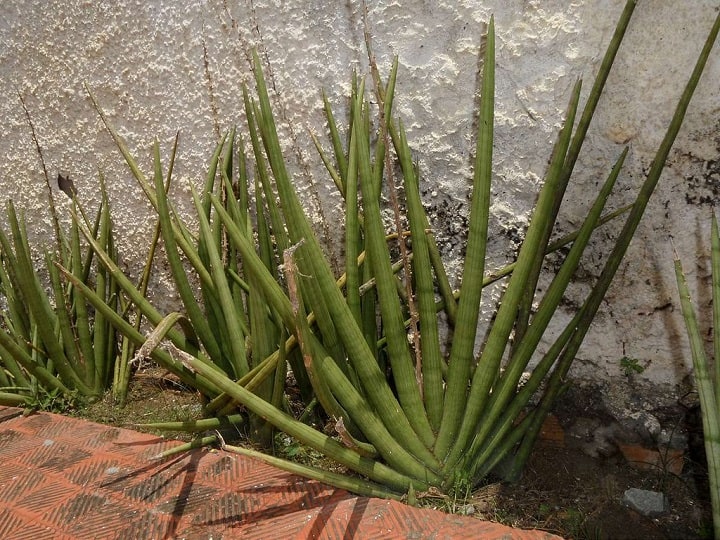
This unusual, less common snake plant is native to South Africa and features cylindrical, columnar leaves that grow up to 3 feet 3 inches tall and 0.8-1.2 inches thick. Young leaves display dark green horizontal banding, which fades with age into a slightly furrowed texture.
Cultivars of this variety include ‘Spaghetti,’ ‘Skyline,’ and ‘Patula’—each bringing a unique twist to its architectural form. To keep this plant thriving, provide bright light or direct sun, and consider placing it outdoors in summer. Water thoroughly but moderately, allowing the soil to dry between waterings. Maintain 60% humidity at around 68°F and use a cactus or succulent fertilizer from spring through fall.
Sansevieria cylindrica ‘Spaghetti’
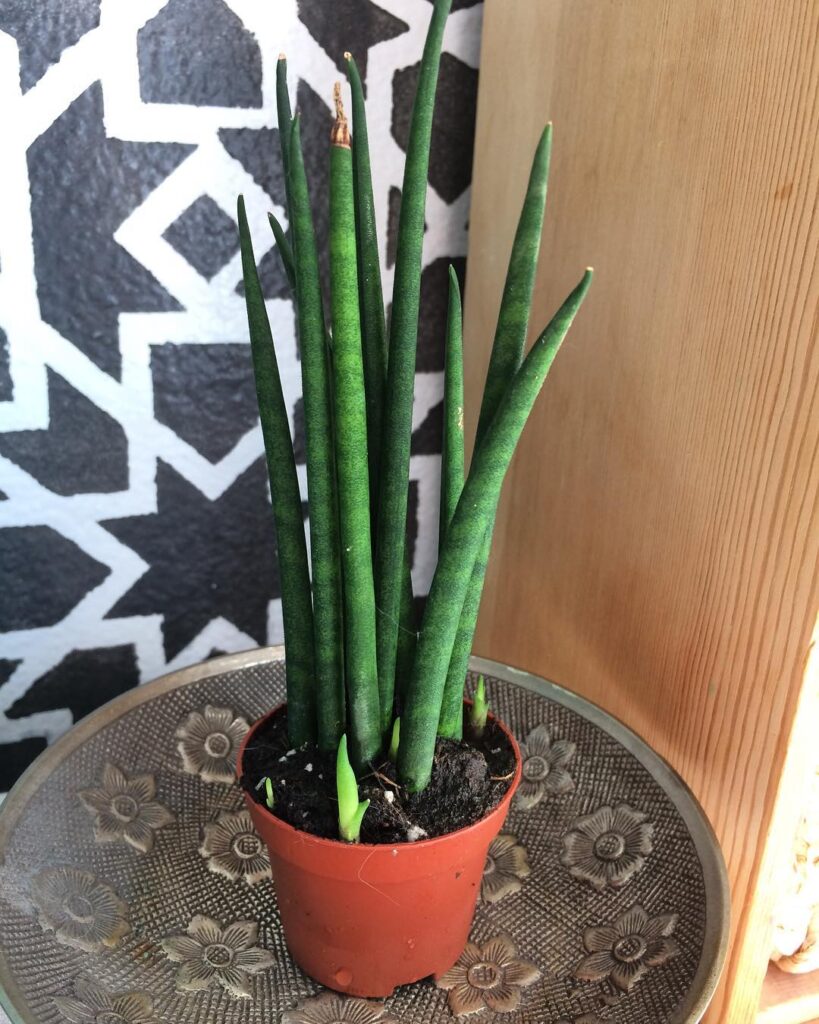
Sansevieria cylindrica ‘Spaghetti’ is a compact and quirky take on the traditional cylindrical snake plant. Its thin, upright leaves resemble strands of spaghetti, giving it a fun, architectural look. Native to Angola, this variety thrives in bright light or direct sun, making it a great choice for modern indoor spaces.
The leaves start dark green to grayish-green, often showing faint horizontal banding when young. Over time, the texture becomes slightly furrowed, adding an intriguing visual element. ‘Spaghetti’ grows in a dense cluster, reaching heights of up to 3 feet 3 inches, though it stays more compact compared to other Sansevieria cylindrica varieties.
Sansevieria cylindrica ‘Skyline’

Sansevieria cylindrica ‘Skyline’ is a visually striking variety known for its tall, cylindrical leaves that grow in an upright, sculptural form. Its foliage has a deep green base color with lighter horizontal banding, creating a modern, minimalist aesthetic. This distinct pattern is more pronounced in younger leaves but fades into a subtly furrowed texture as the plant matures.
Thriving in bright light or direct sun, ‘Skyline’ is an excellent choice for well-lit indoor spaces or outdoor placement during warmer months. It can reach up to 3 feet 3 inches tall, making it a dramatic yet low-maintenance addition to plant collections. With its vertical growth habit and resilience, it brings height and structure while requiring minimal care.
Sansevieria cylindrica var. patula
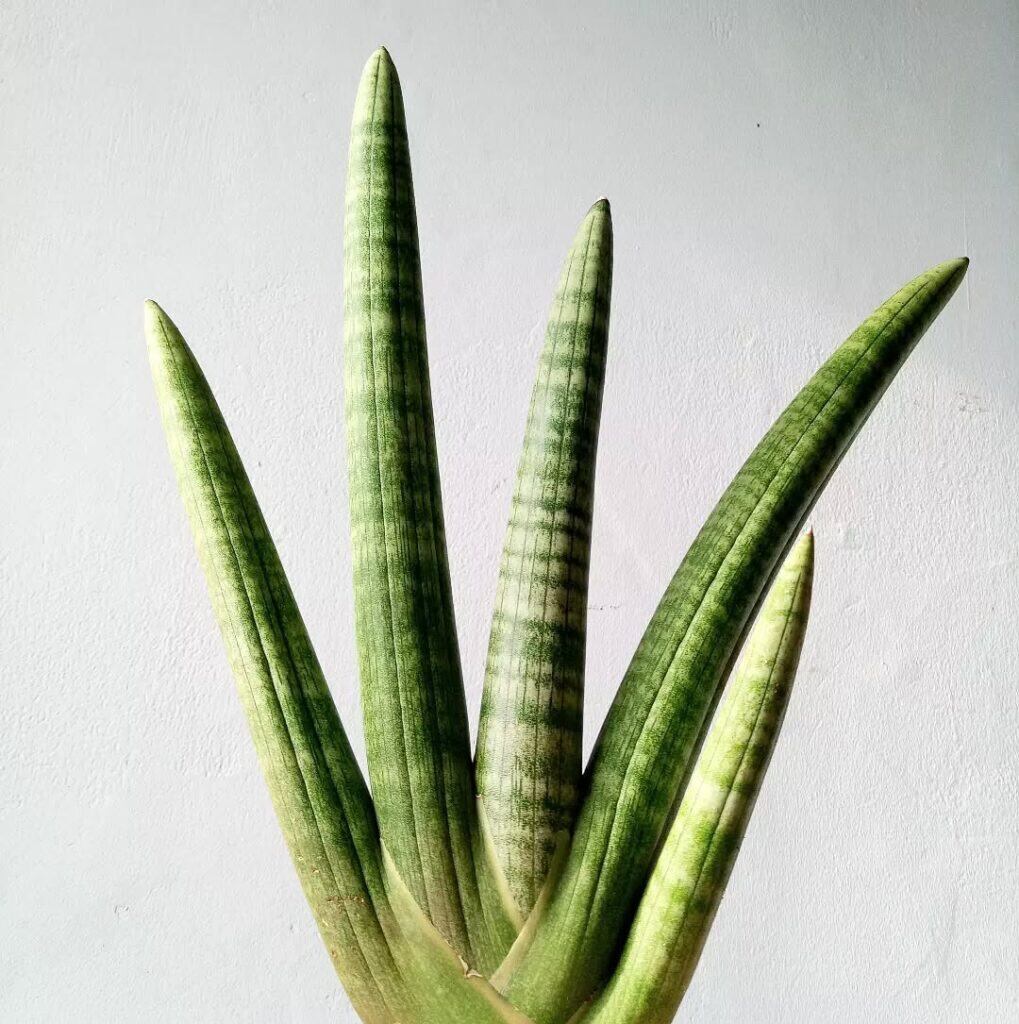
Sansevieria cylindrica var. patula showcases an elegant yet structured growth habit, characterized by its attenuate, terete leaves that gradually taper to fine points. These linear-lanceolate blades exhibit a coriaceous texture, giving them a firm, leather-like feel, while their glaucous surface lends a muted, frosted appearance, especially in young foliage. The leaves emerge in a relaxed, outward-spreading arrangement, contrasting with the more upright forms of other cylindrica varieties.
Flowering reveals a delicate raceme structure, where filiform pedicels support clusters of sessile blooms. Each flower is accompanied by a small bract at its base, subtly accentuating the plant’s intricate floral presentation. The inflorescence takes on a panicle-like form, with slender branches carrying multiple blossoms, adding an unexpected architectural element to this otherwise foliage-driven species.
Sansevieria cylindrica var. patula ‘Boncel’
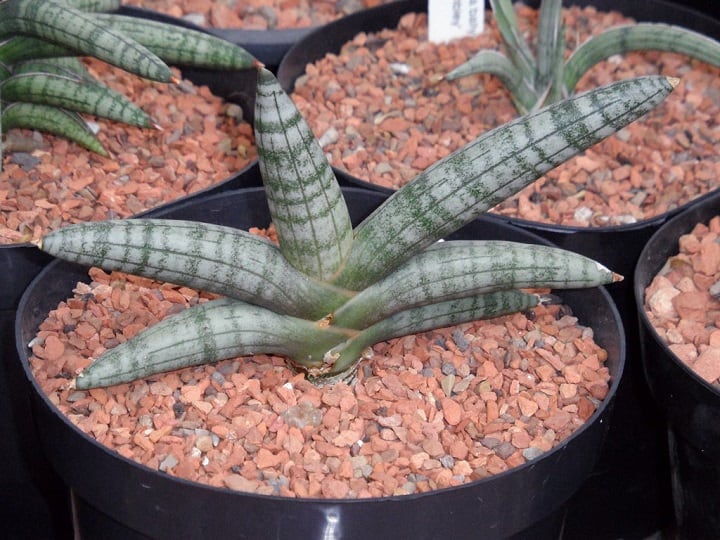
A variation of Sansevieria cylindrica, ‘Boncel’ features a unique spreading leaf growth pattern. While it maintains the same care requirements, it offers a slightly different aesthetic with more compact, outward-growing foliage.
Sansevieria dhofarica
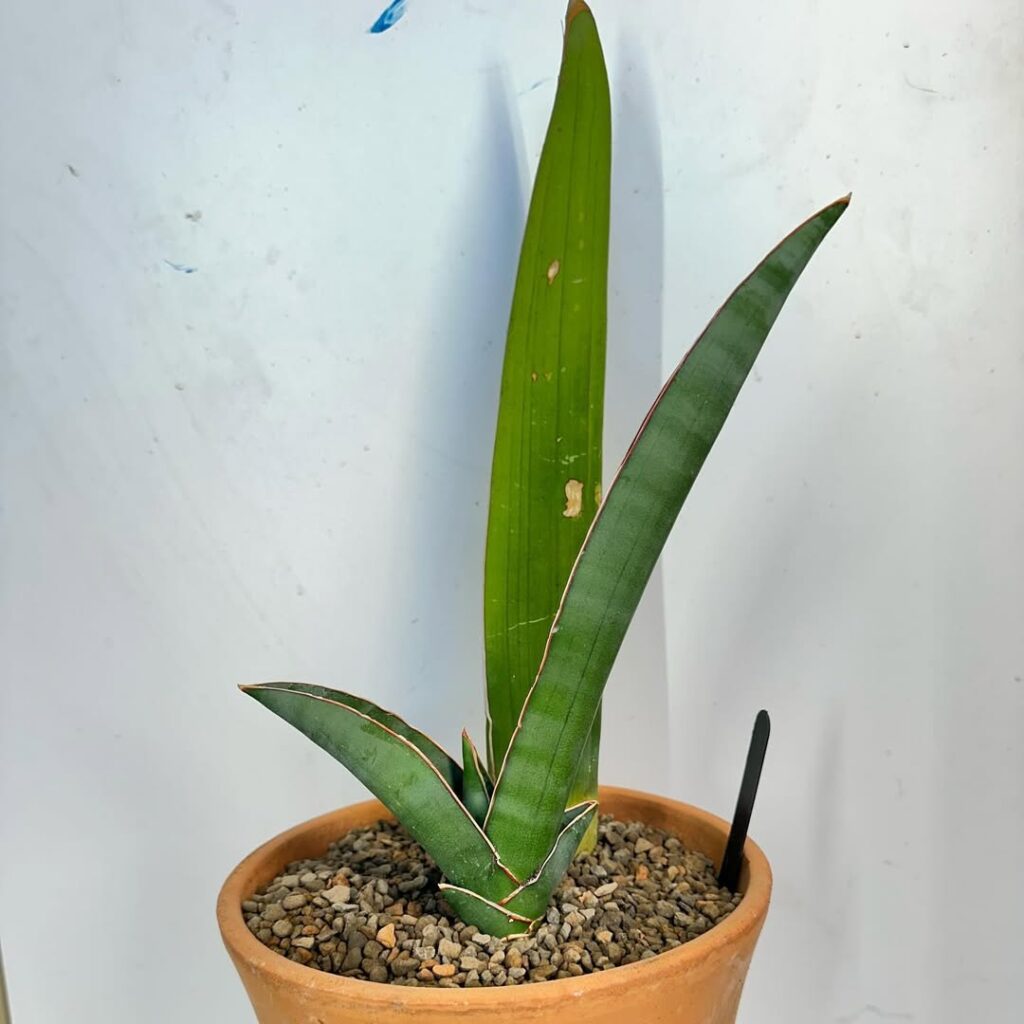
Sansevieria dhofarica, now classified as Dracaena dhofarica, is a rare, upright-growing succulent native to Oman and Yemen. It features thick, slightly curved leaves with reddish-brown edges, giving it a distinctive appearance. The foliage is deep green, sometimes displaying subtle longitudinal grooves, adding texture to its structure.
Sansevieria dhofarica is sometimes referred to as “Samurai Salaf”, highlighting its strong, resilient nature.
Sansevieria dhofarica ‘Variegata’
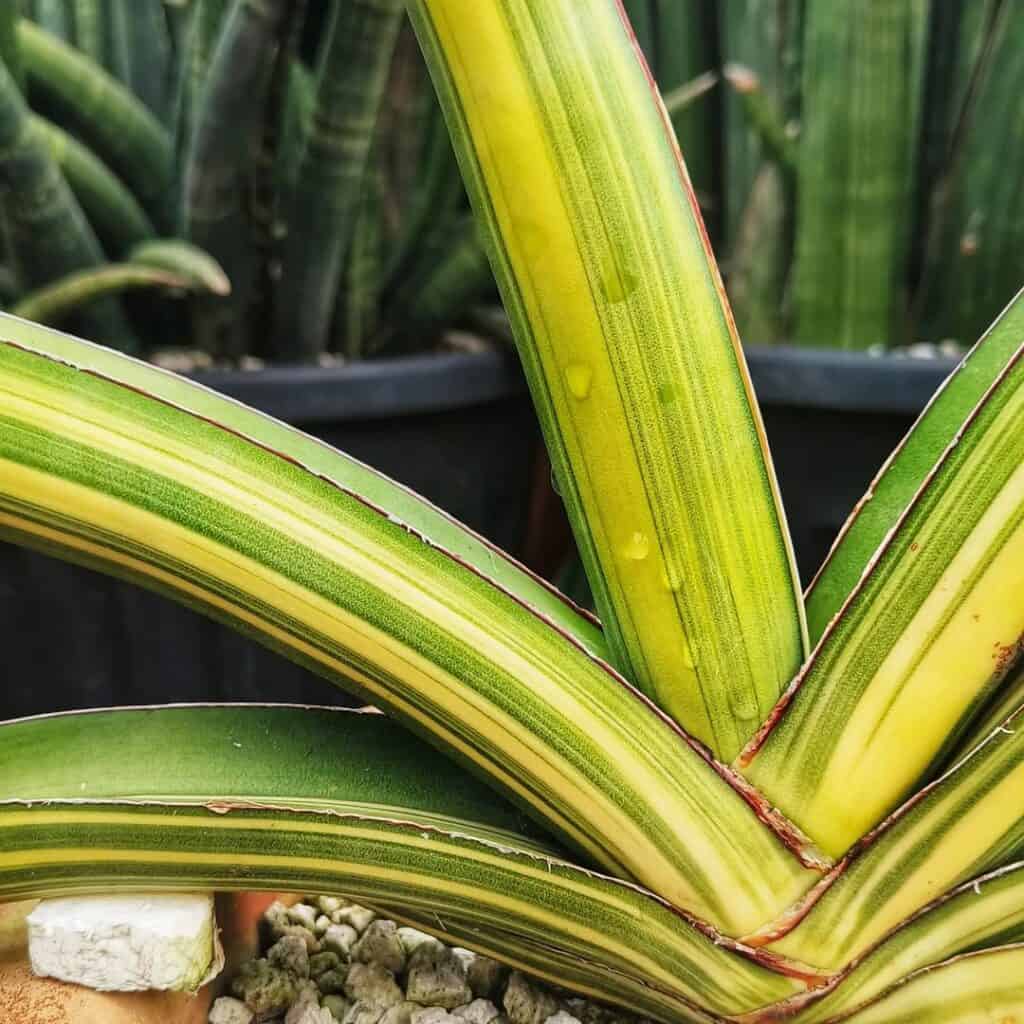
Sansevieria dooneri
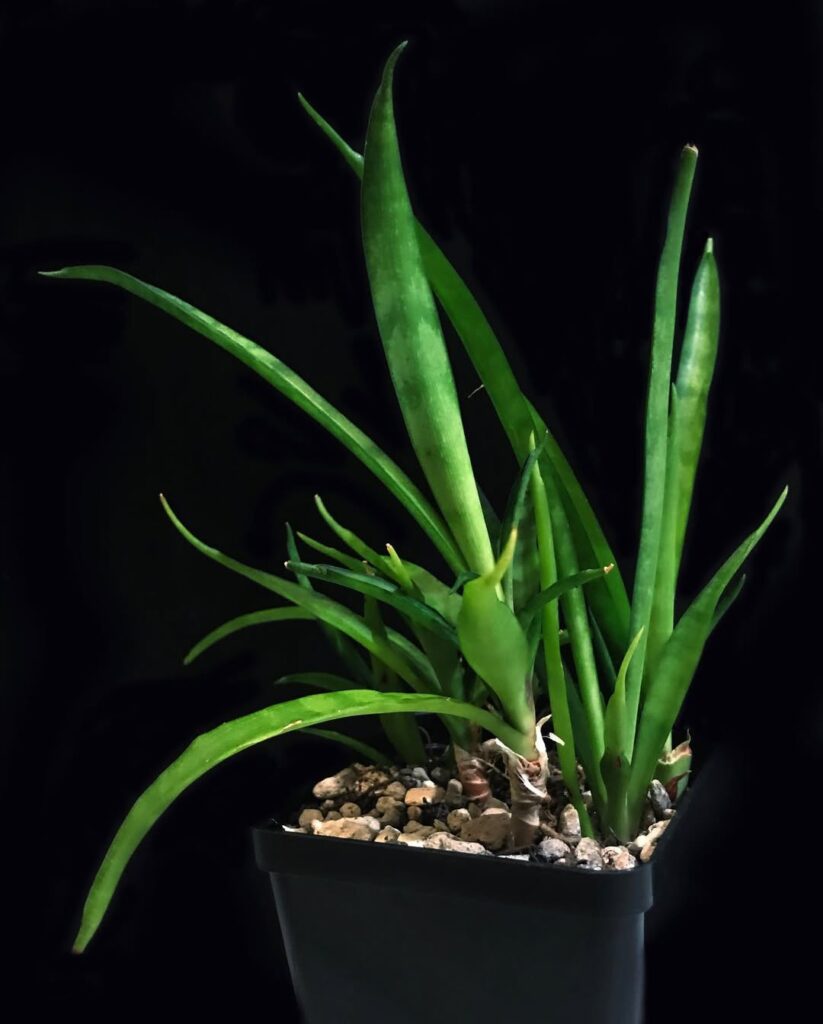
Sansevieria dooneri, now classified as Dracaena dooneri, is a compact, upright-growing succulent native to East Africa. It features long, slender, cylindrical leaves that grow in dense clusters, creating a fountain-like appearance. The foliage is dark green with light green striations, adding subtle texture to its structure.
Sansevieria dooneri is sometimes referred to as the “Kenya Hyacinth” due to its elegant, upright form.
Sansevieria downsii

Sansevieria downsii, now classified as Dracaena downsii, is a rare, upright-growing succulent native to Malawi, Mozambique, and Zambia. It features long, slender leaves that grow in rosettes, with a mid-green coloration and subtle longitudinal grooves. The foliage is recurved and spreading, with a spiny, withered apex, adding to its distinctive appearance. It is often found growing on termite mounds in dry woodland and scrub, making it a resilient and adaptable species.
Sansevieria dumetescens ‘Variegata’
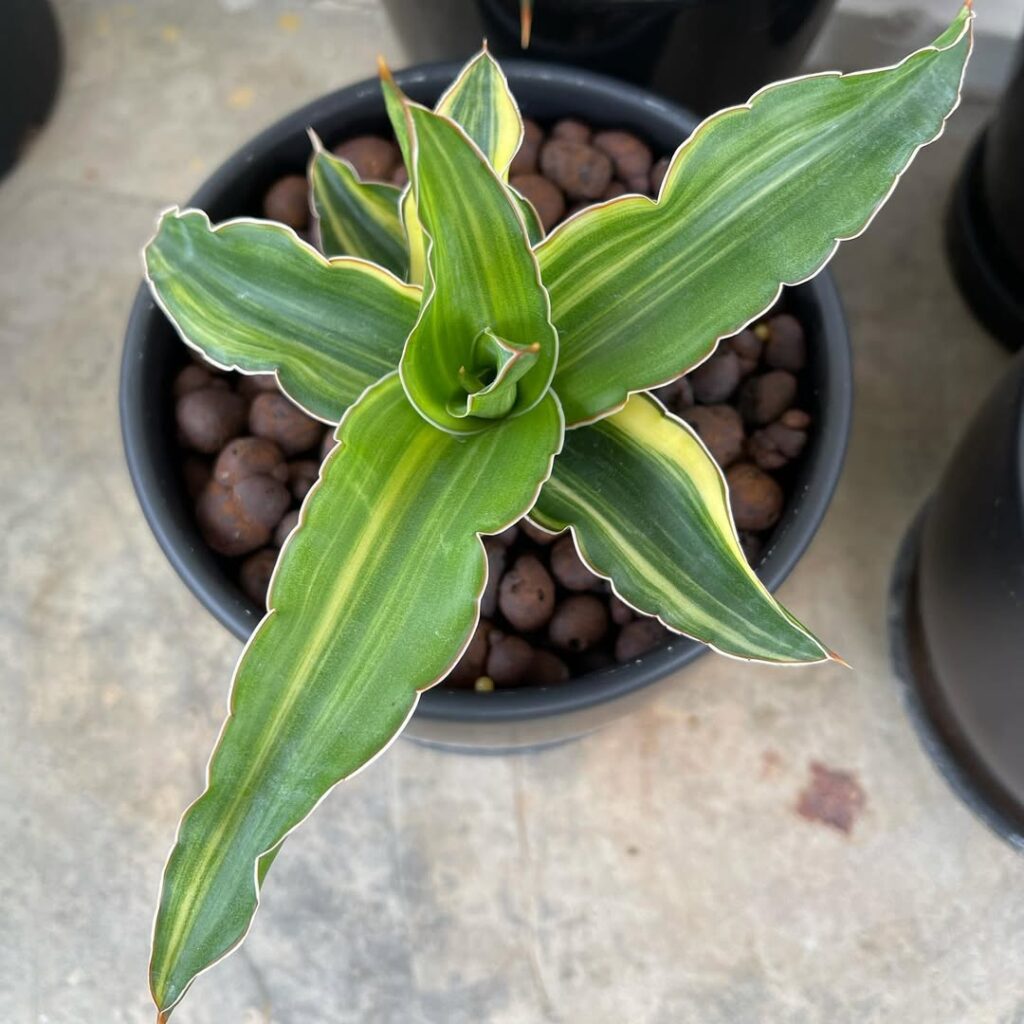
Sansevieria dumetescens ‘Variegata’ is a rare variegated cultivar of Sansevieria dumetescens, featuring long, slender, upright leaves with green tones and subtle yellow variegation. The foliage grows from a central base, forming a structured, elegant appearance.
Sansevieria ehrenbergii
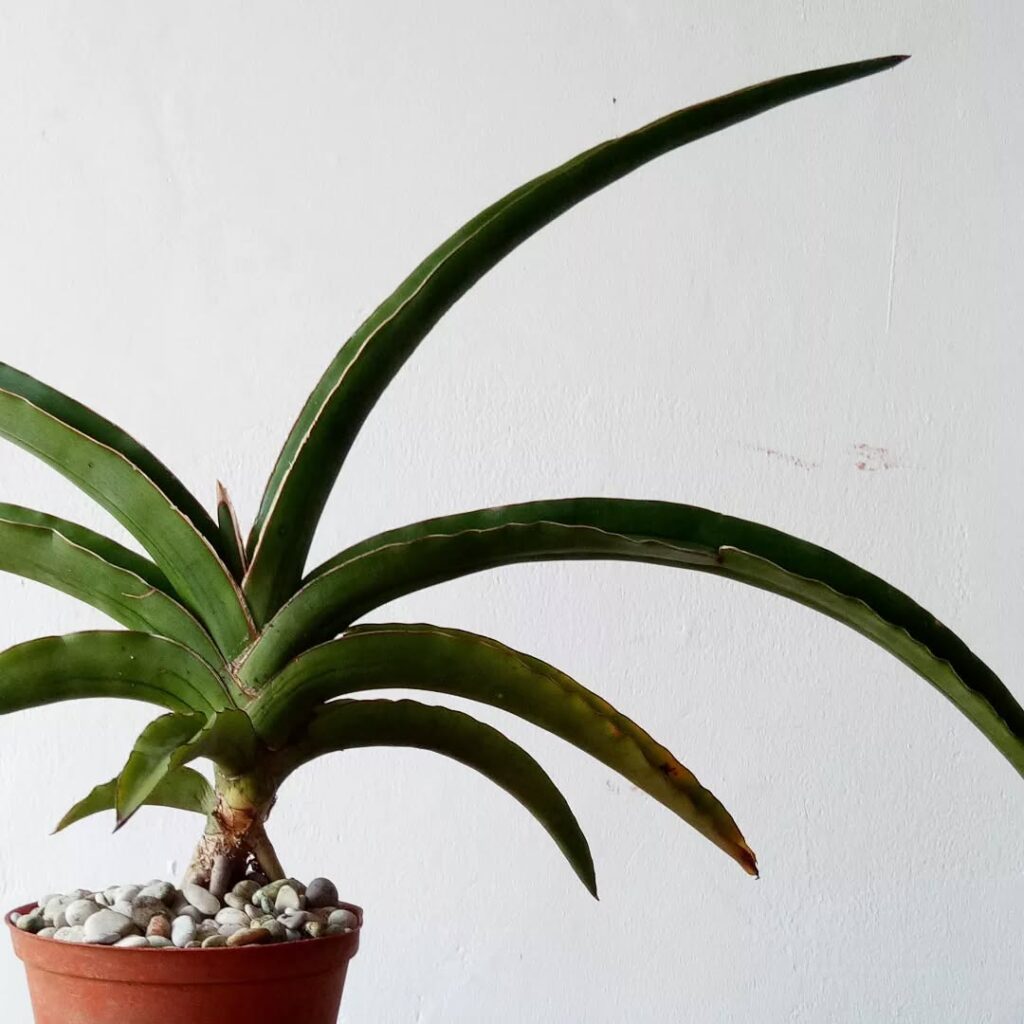
Sansevieria ehrenbergii, now classified as Dracaena hanningtonii, is a robust, upright-growing succulent native to northeastern and eastern tropical Africa and the Arabian Peninsula. It is commonly known as sword sansevieria or blue sansevieria, due to its long, blade-like leaves that grow in a distinct fan-shaped arrangement.
Sansevieria ehrenbergii ‘Banana’

Sansevieria ehrenbergii ‘Banana’ is a compact, slow-growing succulent with thick, boat-shaped leaves that curve like a banana, giving it its name. The foliage is gray-green to blue-green, with a deeply channeled upper surface, adding to its distinctive appearance.
Sansevieria ehrenbergii ‘Samurai Salaf Variegata’
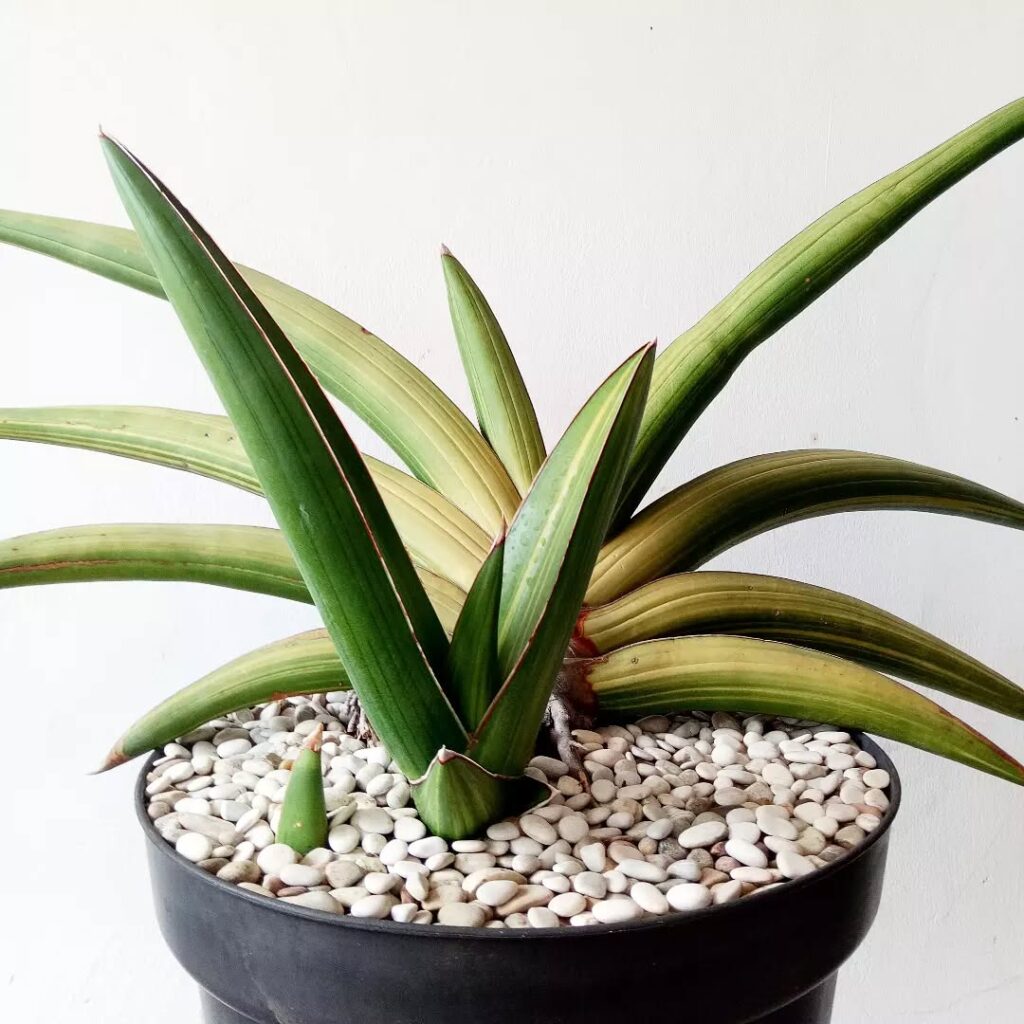
Sansevieria ehrenbergii ‘Samurai Salaf Variegata’ is a rare variegated cultivar of Sansevieria ehrenbergii, known for its thick, sword-like leaves that grow in a distinct fan-shaped arrangement. The foliage displays green tones with subtle variegation, which can become more pronounced with age.
Sansevieria eilensis
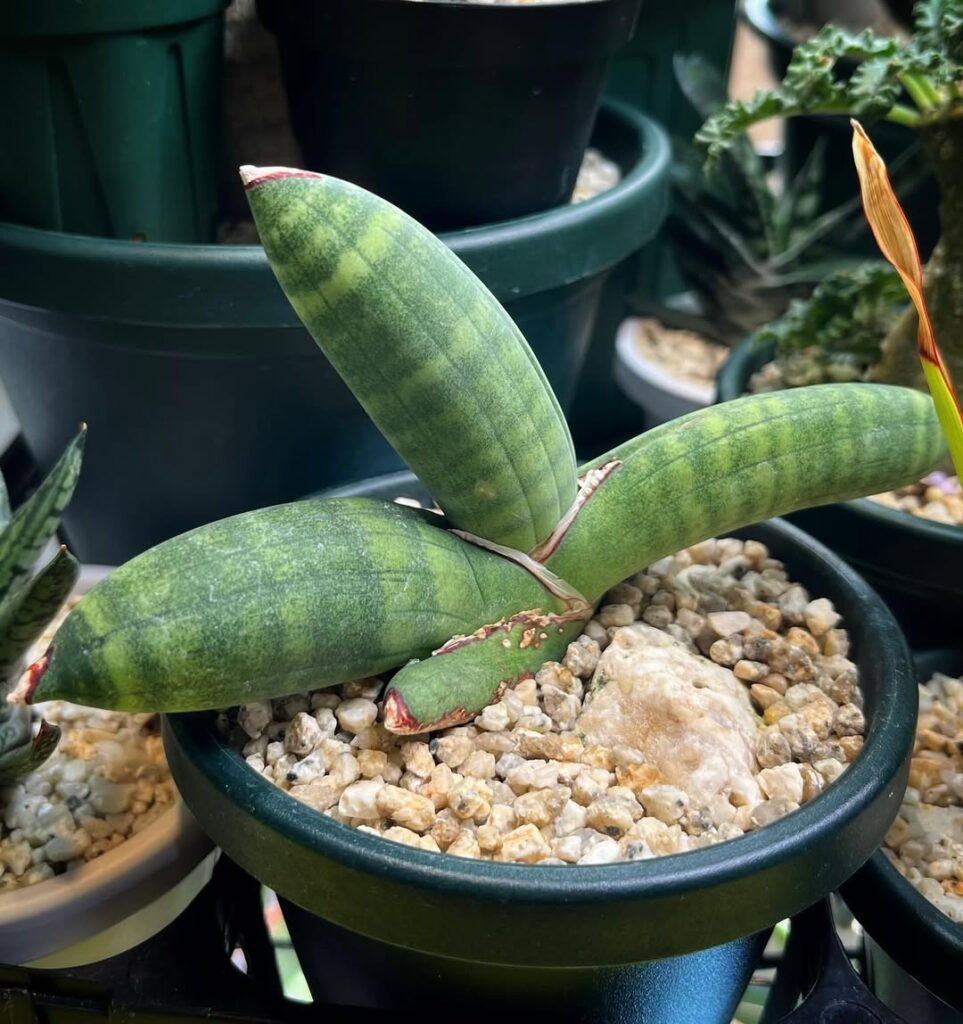
Sansevieria eilensis, now classified as Dracaena eilensis, is a rare and slow-growing species endemic to Somalia, particularly near Eyl. It is distinguished by its bluish-green, cylindrical leaves that curve downward as they mature, giving the plant a unique, sculptural appearance. Young leaves feature deep longitudinal grooves with reddish-brown margins, which gradually fold inward to form a smooth, rounded structure.
The foliage is further characterized by irregular white bands and faint green striations, creating a textured effect. This species develops through underground rhizomatous growth, producing slow offset expansion over time. Though exceptionally slow-growing, mature specimens may produce tall inflorescences with long, tubular white flowers, though flowering is rare outside its natural habitat. Due to its compact form and striking leaf structure, it remains highly sought after by collectors.
Sansevieria elliptica
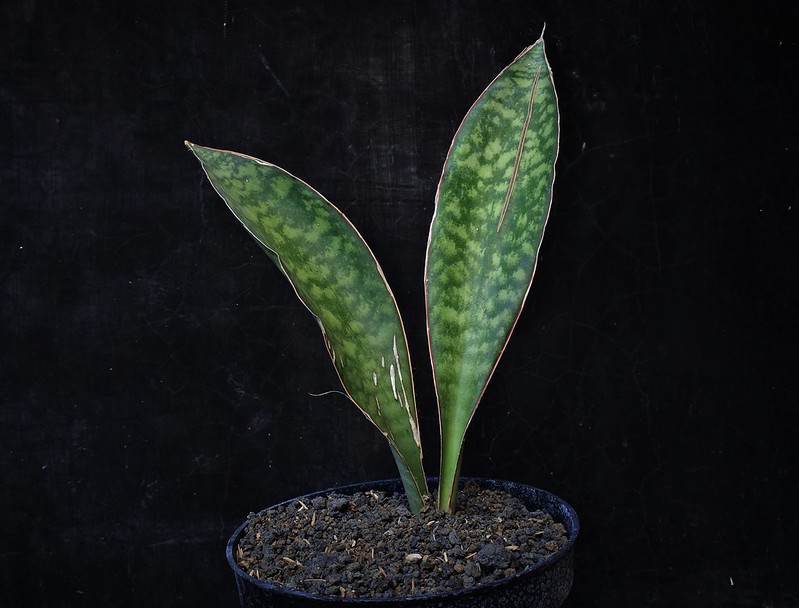
Sansevieria elliptica, now classified as Dracaena elliptica, is a stemless succulent native to Southeast Asia, particularly Thailand, Malaysia, and Indonesia. It features broad, lanceolate leaves with dark green coloration and prominent silver-gray mottling, creating a striking contrast. The foliage grows in a spreading rosette, sometimes twisting slightly, and has a reddish leaf edge that extends onto both surfaces.
This species is often confused with Sansevieria kirkii due to its stout, broad leaves with red margins, but it is distinguished by its more pronounced mottling and slightly more upright growth habit.
Sansevieria elliptica ‘Horwood’
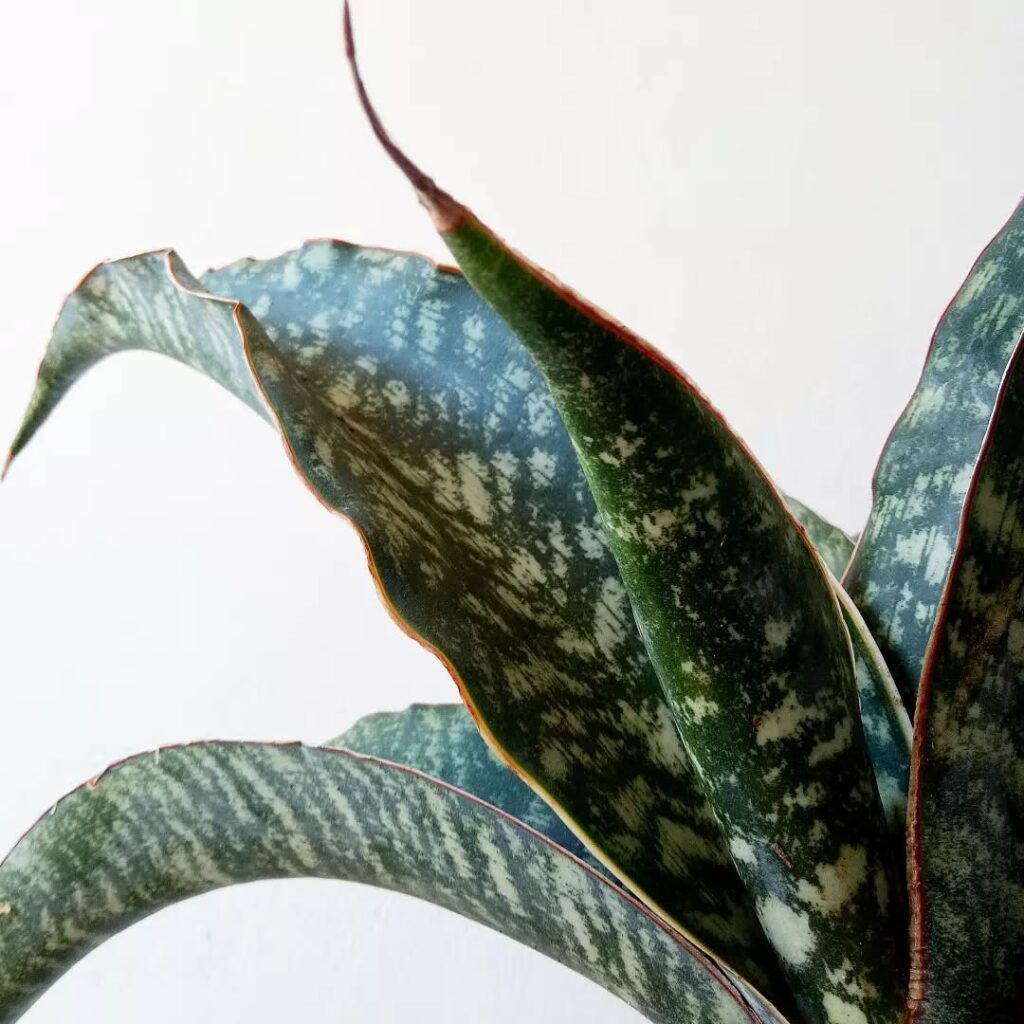
Sansevieria elliptica ‘Horwood’ is a stemless succulent with dramatic green leaves featuring grey-white mottling and a rough underside. The foliage is thick, lanceolate to oval, with a tapered tip and a reddish leaf edge extending onto both surfaces. The leaves grow in a spreading rosette, sometimes twisting slightly, adding to its distinctive look. This cultivar was named by Grigsby, based on a collection by Frank Horwood, though its exact locality remains uncertain. Identical specimens have been found in Kenya, particularly near Kibwezi and Malka Mari National Park.
Sansevieria erythraeae
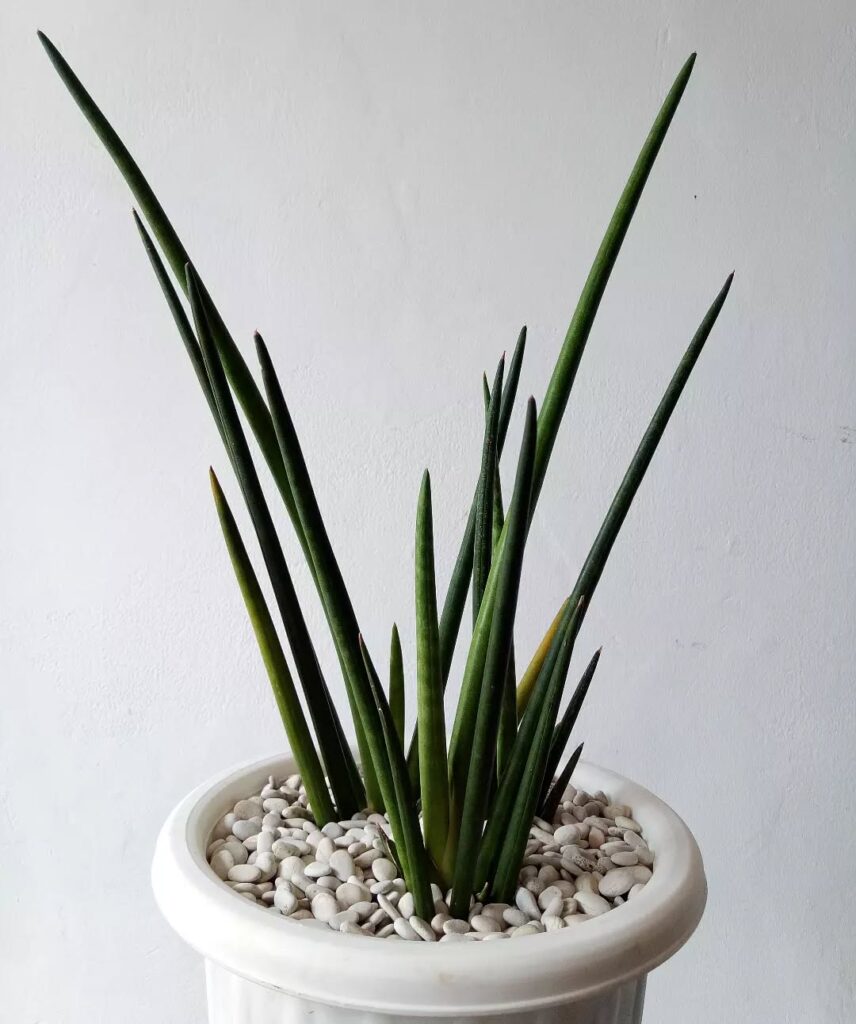
Sansevieria erythraeae, now classified as Dracaena erythraeae, is a stemless, rhizomatous succulent native to Eritrea, Ethiopia, and Sudan. Commonly known as Pencil Sansevieria, it features numerous upright, cylindrical leaves that grow in open fan-shaped rosettes. The foliage is dark green, smooth, and lacks cross-banding, but has raised longitudinal lines that add subtle texture.
Sansevieria fasciata
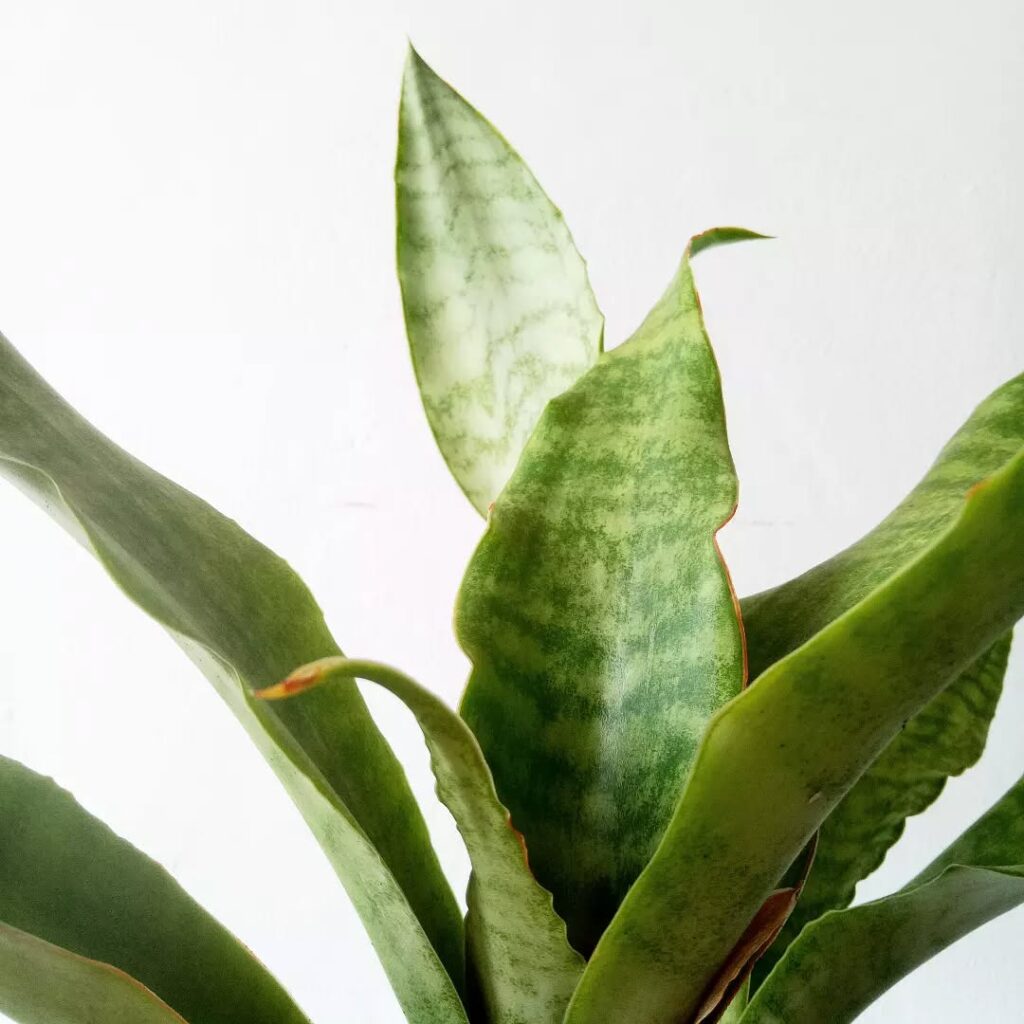
Sansevieria fasciata, now Dracaena fasciata, is a stemless succulent with a thick creeping rootstock that produces densely clustered leaf tufts. The leaves grow in pairs or small groups, with the lower portion standing upright and the upper section arching outward or drooping. Each leaf measures 15 to 33 inches in length, tapering to a small, withering tip, and transitions into a strongly concave-channeled petiole. The foliage is leathery yet flexible, with an irregular dark green zigzag pattern overlaying a pale green upper surface and a brighter whitish-green underside.
The leaf margins start green, later developing narrow whitish or reddish tones, which can decompose into fine fibers as the plant matures.
Sansevieria fasciata ‘Frozen’
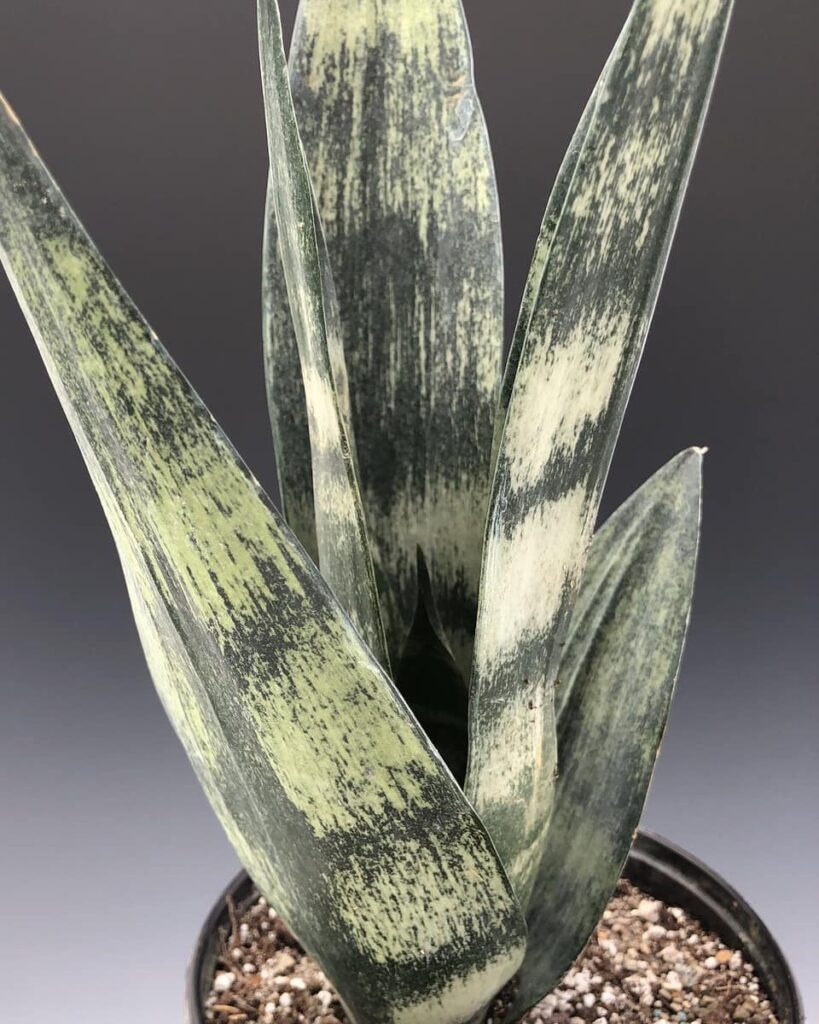
Sansevieria fasciata ‘Frozen’ is a striking cultivar known for its long, slender, upright leaves with a slightly wavy texture. The foliage is deep green, often displaying subtle variegation, making it a visually appealing addition to any collection. The leaves emerge from a central base, creating a structured, elegant form.
Sansevieria ‘Fernwood’
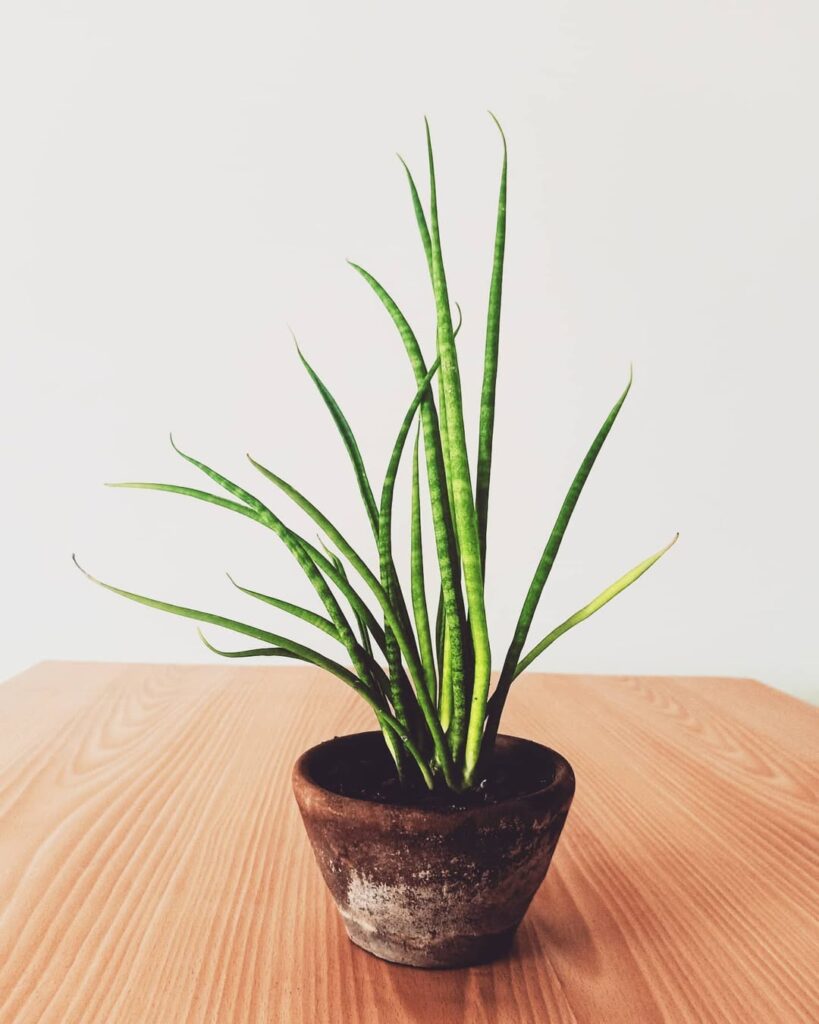
Sansevieria ‘Fernwood’ is a compact hybrid of Sansevieria suffruticosa and Sansevieria parva, developed by Rogers Weld at Fernwood Nursery in California. It features long, slender, cylindrical leaves with dark green coloration and lighter green variegation, growing in a dense, upright cluster. The foliage has a tiger-striped pattern, adding to its visual appeal.
Sansevieria fischeri
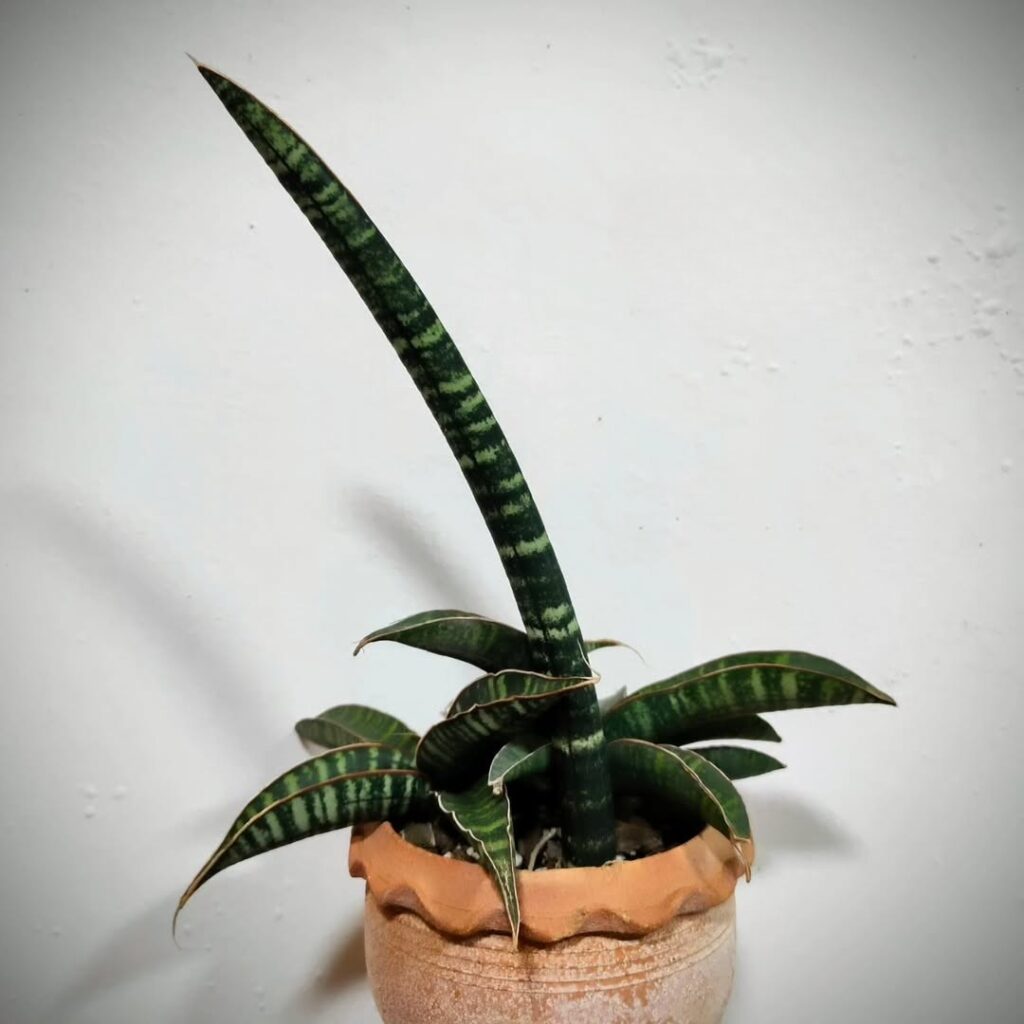
Sansevieria fischeri, now classified as Dracaena fischeri, exhibits distinct differences between its juvenile and mature forms. In its juvenile stage, the plant produces short, thick, curved leaves that emerge in a compact rosette. These leaves often display a deep central groove and papery reddish margins, giving them a textured appearance.
As the plant matures, the leaves become longer, straighter, and more spear-like, sometimes reaching up to 6 feet in height. The darker portions of the foliage become raised, adding a unique tactile quality to the surface. This transformation reflects the plant’s adaptation to its environment, allowing it to maximize water retention and structural integrity.
Sansevieria forskaoliana
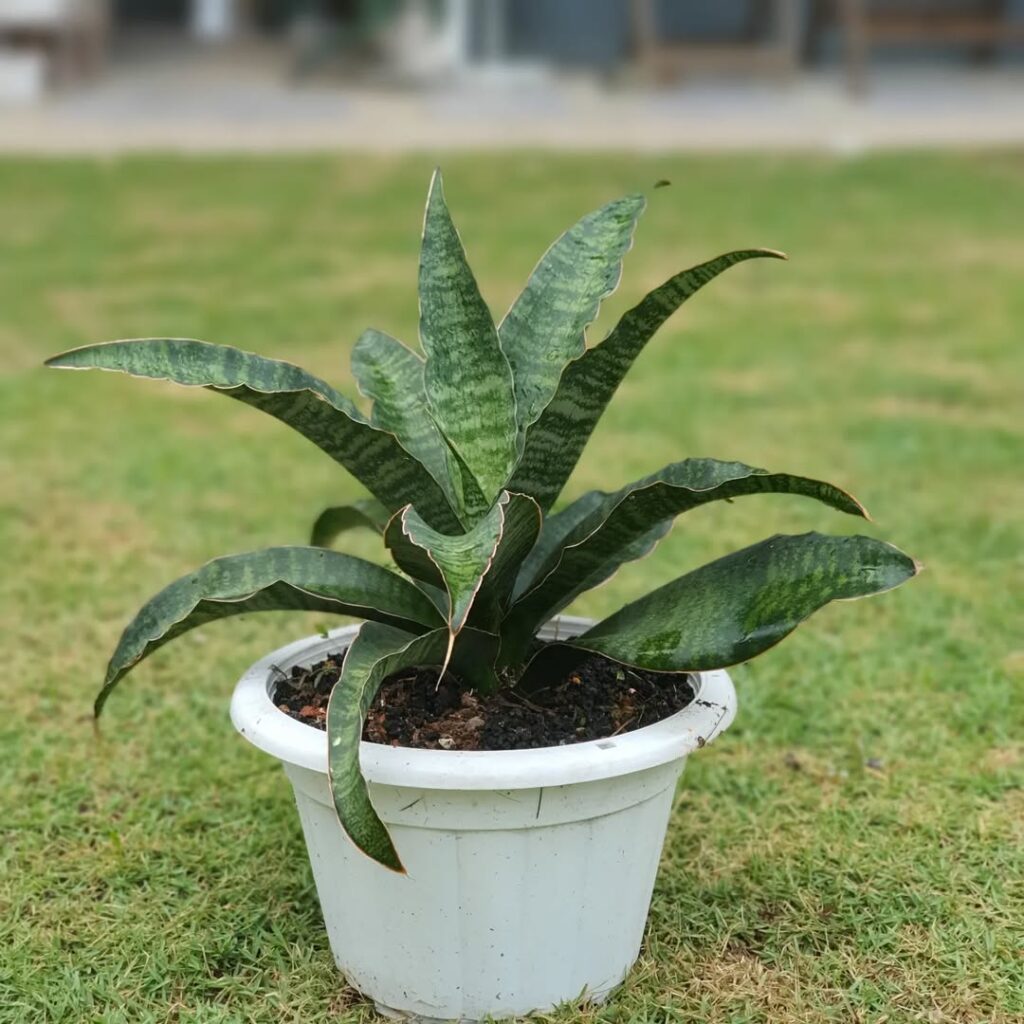
Sansevieria forskaoliana, now classified as Dracaena forskaoliana, is a stemless, evergreen perennial native to East Africa and the Arabian Peninsula. It produces clusters of rigid, upright leaves, which can grow up to 2 feet or more in length. The foliage is often variegated, displaying dark green zigzag bands on a pale green upper surface, while the underside is brighter whitish-green, with fewer, more spaced-out markings.
Sansevieria francisii

Native to Kenya, this compact variety develops a small trunk-like base, topped with marbled green leaves that taper to a point. It stays relatively small, reaching up to 1 foot tall, but offsets along runners allow for easy propagation.
Unlike some snake plants, S. francisii is highly tolerant of full blazing sun but also thrives in partially shaded conditions. Water sparingly, letting the soil fully dry between waterings to prevent rot. Keep temperatures around 68°F, but avoid anything below 59°F. A well-draining cactus or succulent soil mix ensures optimal health, and fertilizing from spring through fall supports steady growth.
Sansevieria gracillima ‘Variegata’
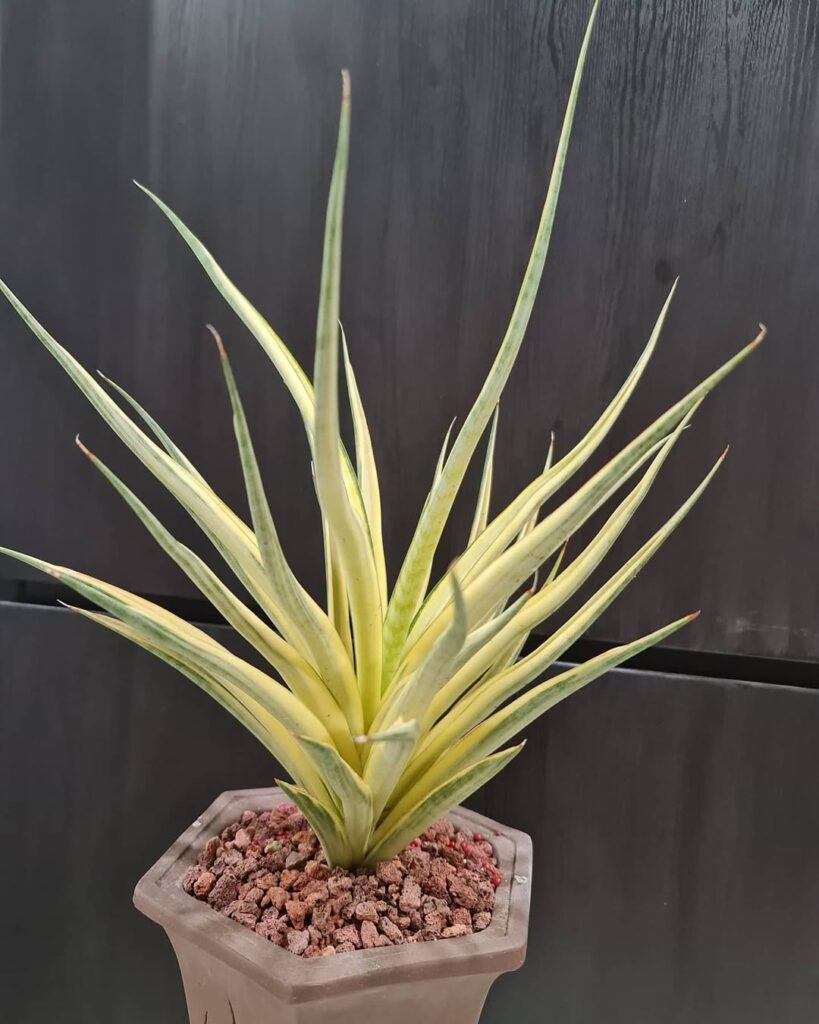
Sansevieria gracillima ‘Variegata’ is a rare variegated form of Sansevieria gracillima, admired for its long, slender, upright leaves with striking yellow variegation. The foliage is narrow and pointed, growing in a dense, vertical arrangement, making it a compact yet elegant addition to succulent collections.
Sansevieria gracilis
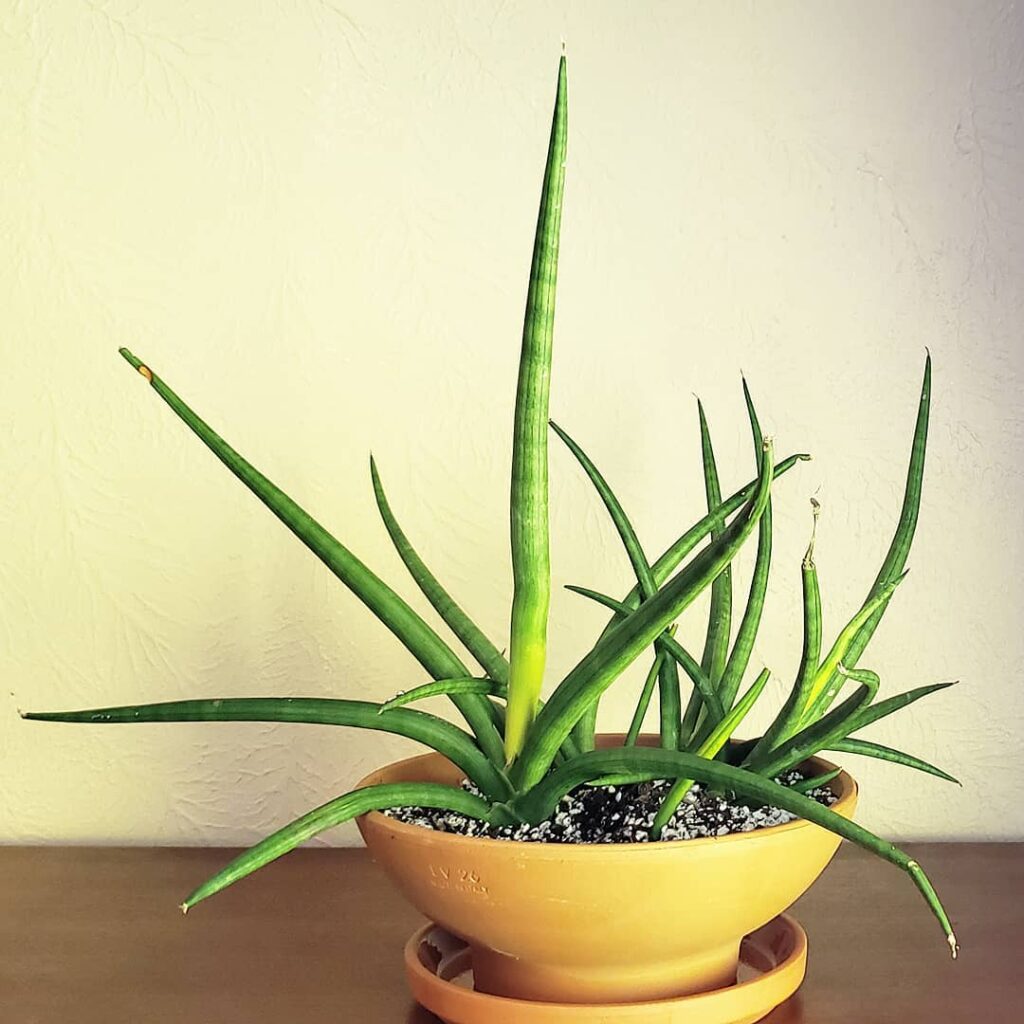
Sansevieria gracilis, now classified as Dracaena gracilis, is a slender, upright-growing succulent native to Angola and South Africa. It features narrow, sword-shaped leaves that can reach up to 18 inches in length, displaying a deep green coloration with lighter vertical stripes. The foliage grows in tight clusters, forming an elegant, structured appearance.
This species thrives in rocky, arid environments, developing a strong underground rhizome that allows it to spread gradually.
Sansevieria gracilis ‘Variegata’
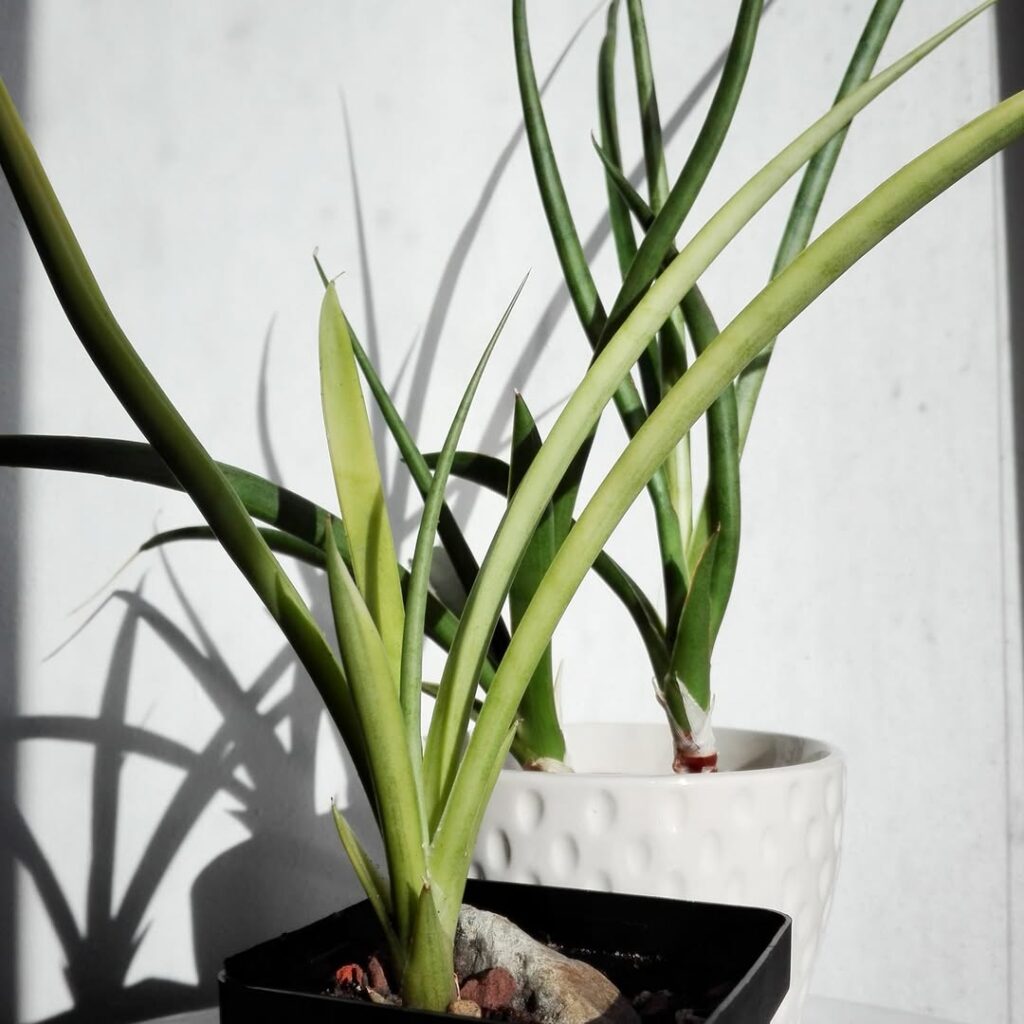
Sansevieria grandis
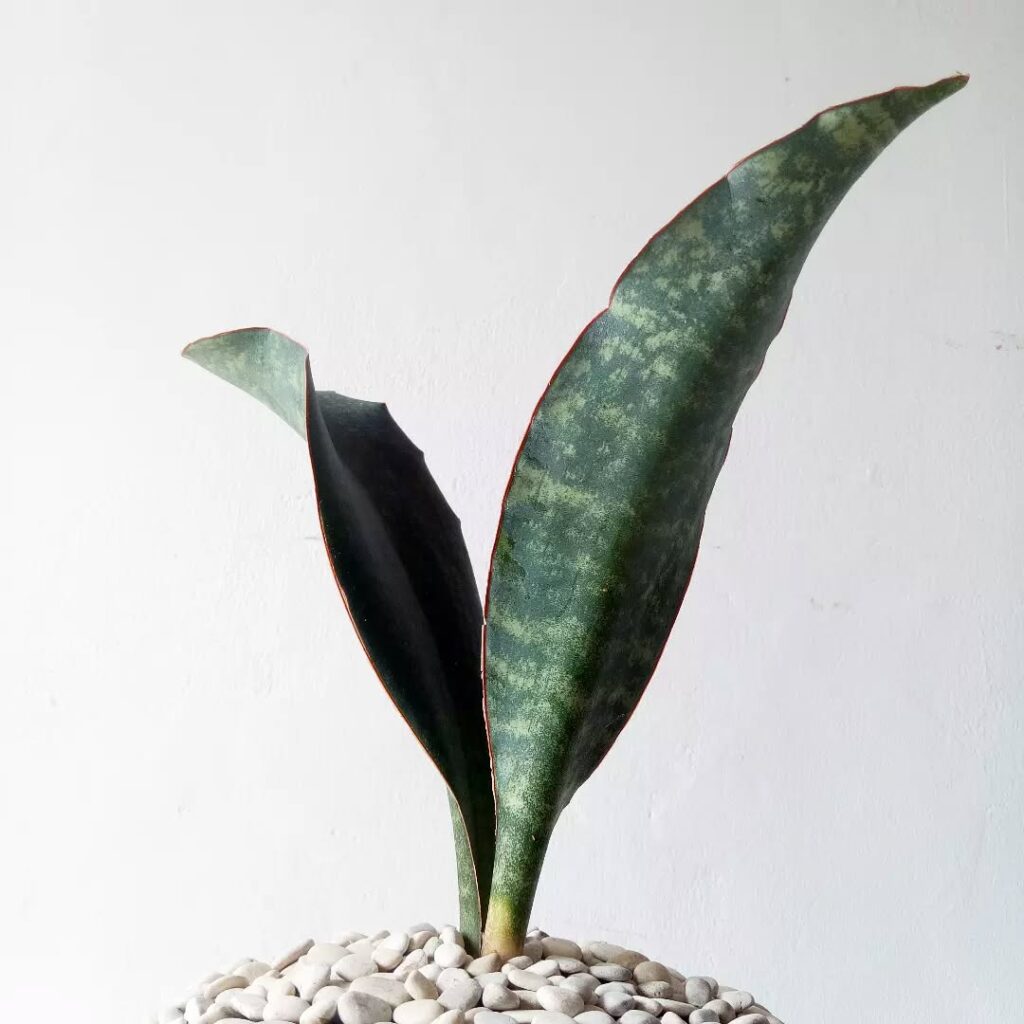
Sansevieria guineensis ‘Beauty Queen’
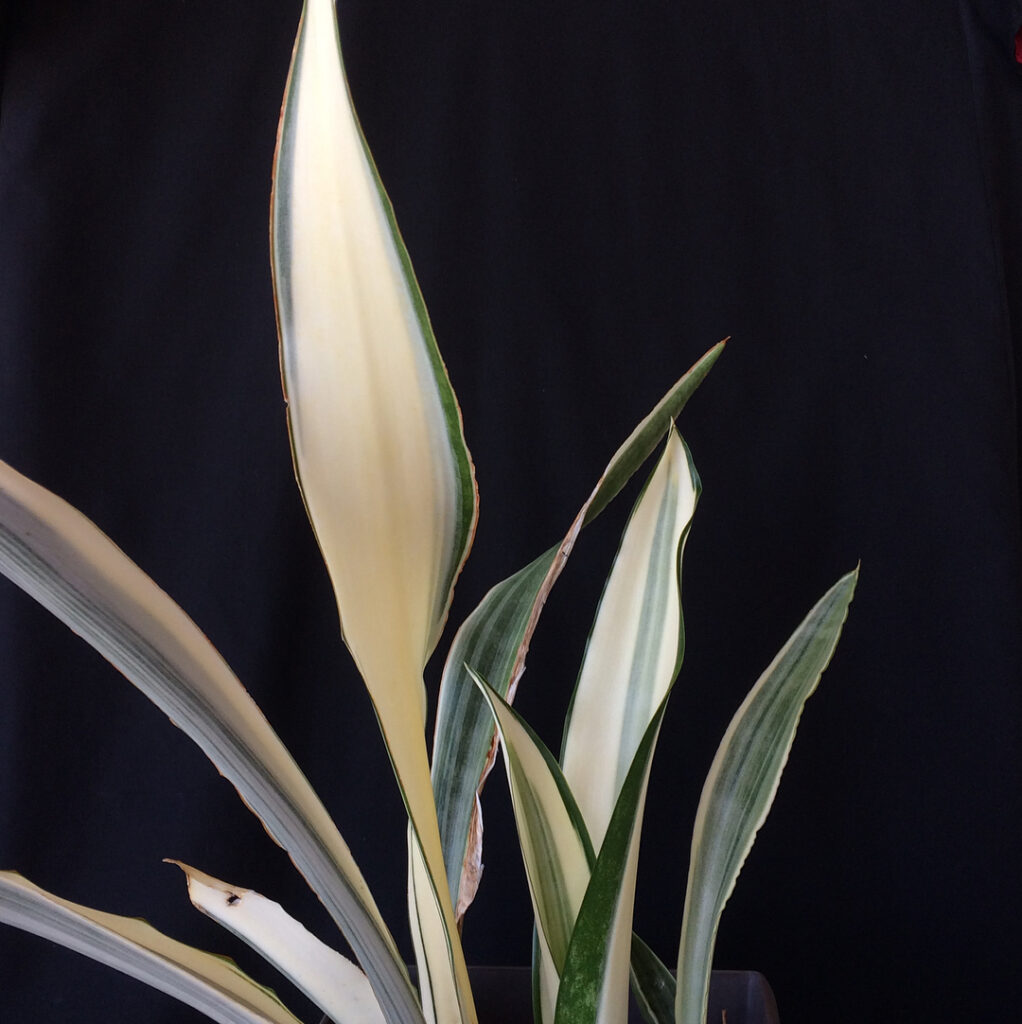
Sansevieria guineensis ‘Beauty Queen’ is a striking variegated cultivar with long, upright leaves featuring a bold contrast of creamy white and green tones. The foliage has sharp edges, giving it a structured, architectural appearance. This variety is admired for its ornamental appeal, making it a standout among snake plants.
Sansevieria hallii

Sansevieria hallii, now classified as Dracaena hallii, is a stemless, perennial succulent native to Mozambique, Zimbabwe, and northern Limpopo, South Africa. Commonly known as Baseball Bat Sansevieria, it features thick, cylindrical leaves that resemble the shape of a baseball bat. The foliage is dark grey-green, often displaying numerous longitudinal lines but lacking prominent transverse banding. Each leaf is U-shaped in cross-section, with a deep groove on the upper surface, and can grow up to 24–35 inches long and 2 inches wide.
Sansevieria hallii ‘Blue Bat’
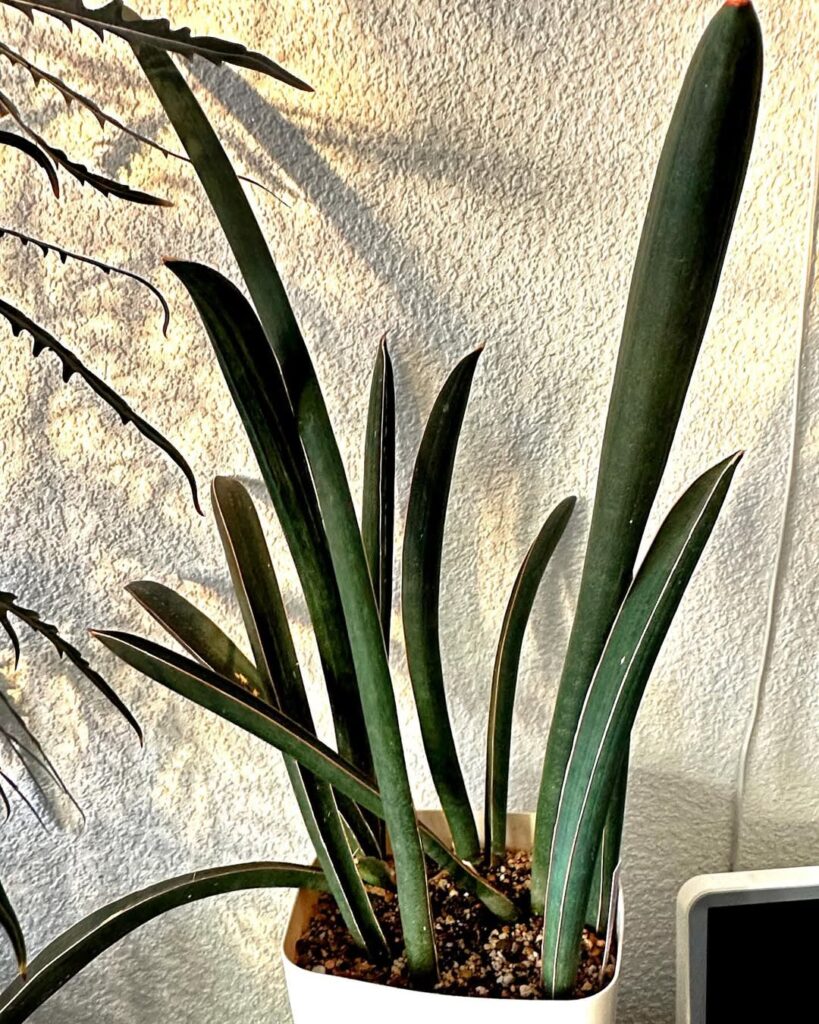
Sansevieria hallii ‘Blue Bat’ is a rare cultivar of Sansevieria hallii, distinguished by its bluish dark green foliage and coarse leaf texture on both the topside and underside. The leaves are thick, cylindrical, and maintain the deep groove along the upper surface, characteristic of the species.
Sansevieria hallii ‘Lundi Bat’
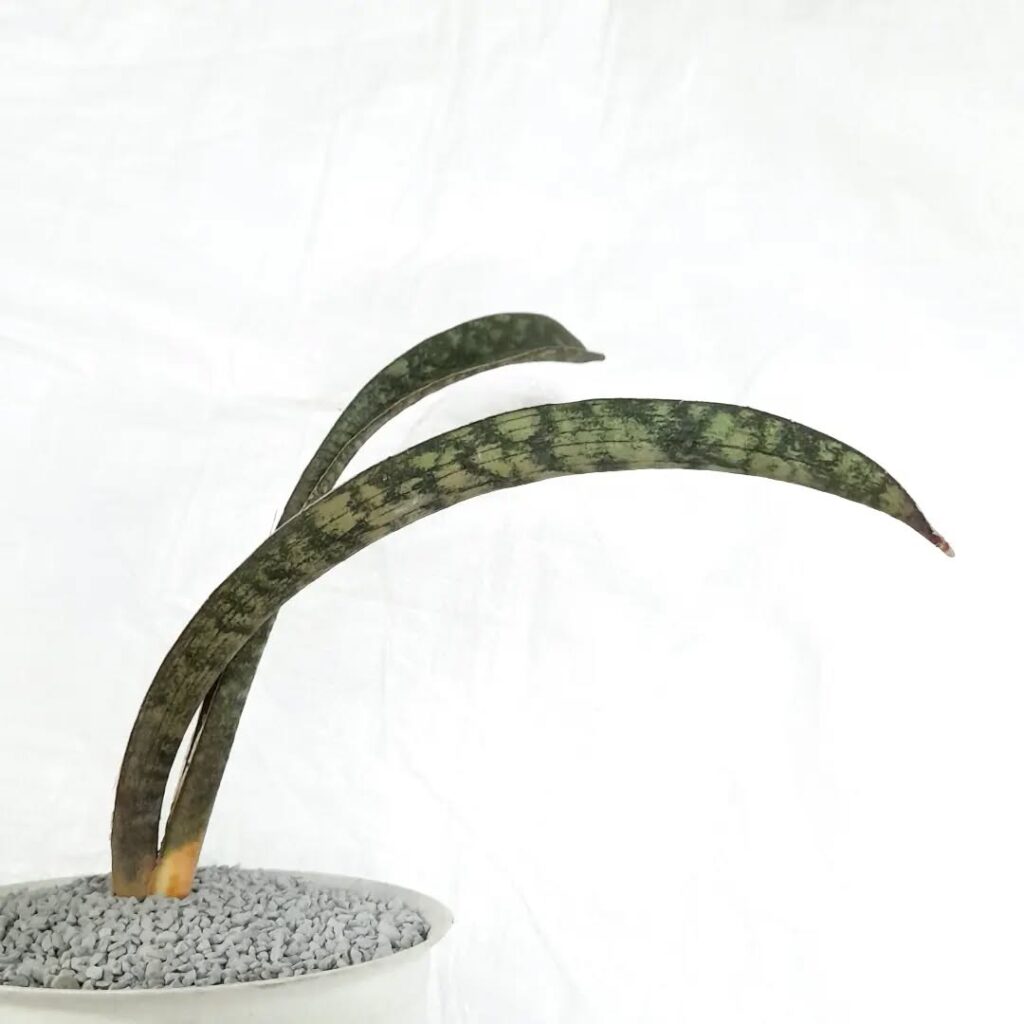
Sansevieria hallii ‘Lundi Bat’ is a rare cultivar of Sansevieria hallii, distinguished by its long, upright, slightly curved leaves with dark green coloration and lighter green variegation. The foliage features thin yellow margins, adding contrast to its structured form.
Sansevieria hallii ‘Pink Bat’
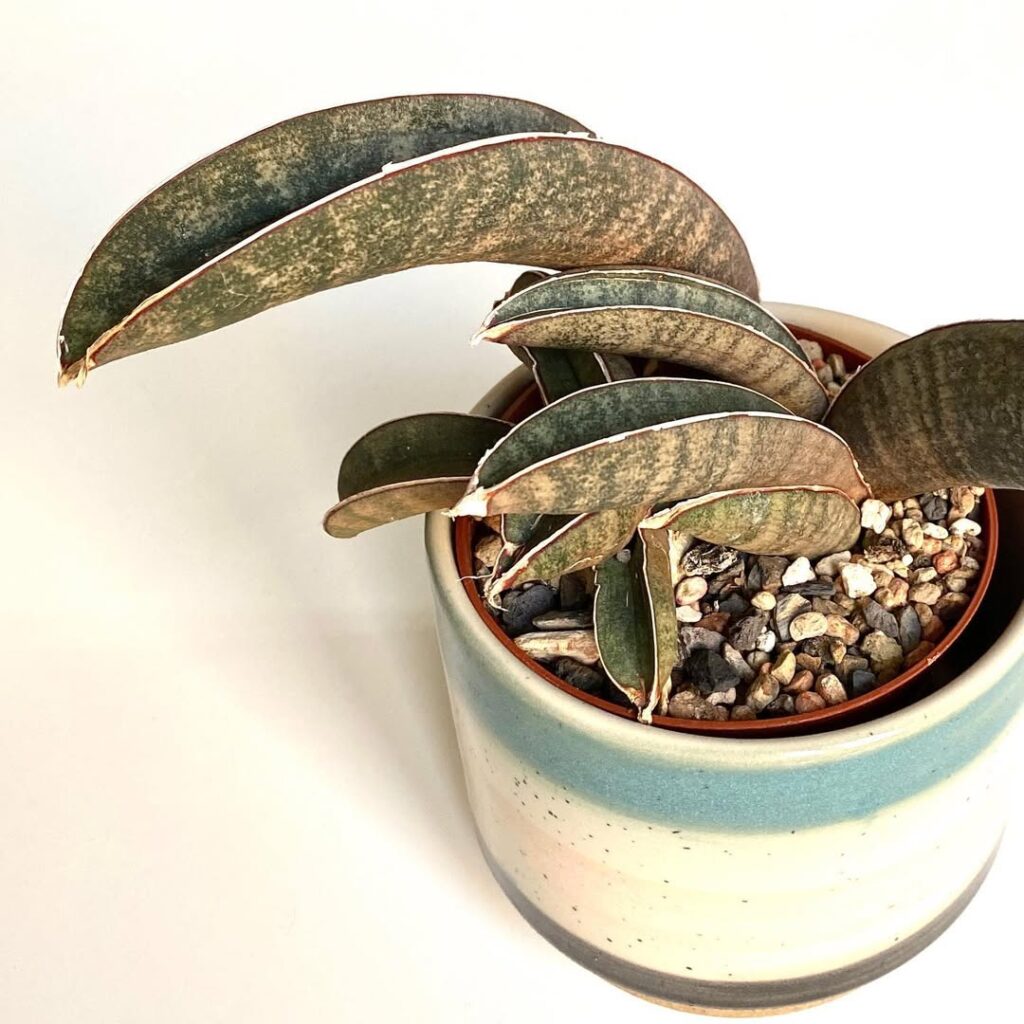
Sansevieria hallii ‘Pink Bat’ is a rare cultivar of Sansevieria hallii, distinguished by its thick, cylindrical leaves with a soft pinkish hue along the edges. The foliage maintains the deep groove along the upper surface, characteristic of the species, but with a subtle pastel tint that sets it apart from other cultivars.
Sansevieria hallii ‘Silver Bat’
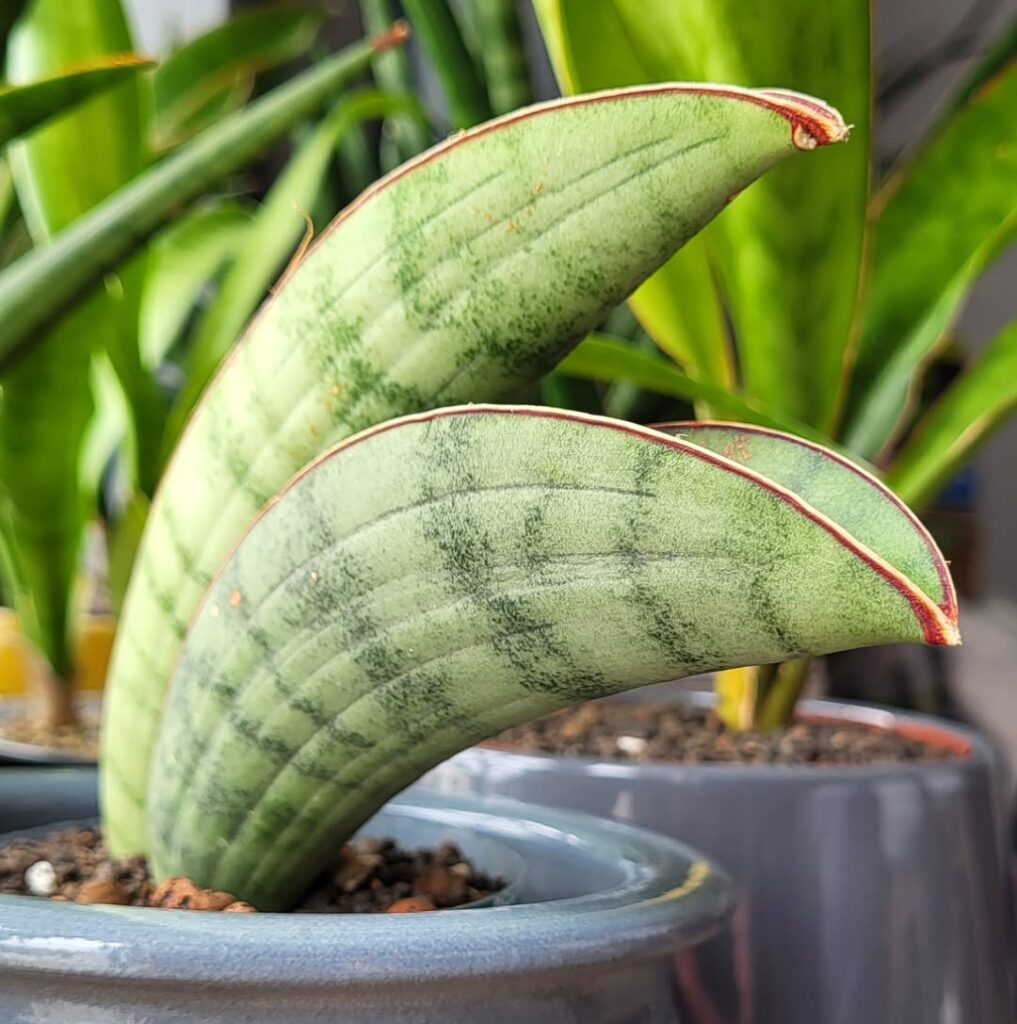
Sansevieria hallii ‘Silver Bat’ is a rare cultivar of Sansevieria hallii, admired for its silvery-green, thick, cylindrical leaves that resemble a baseball bat. The foliage features subtle dark green markings, adding depth to its unique coloration. This cultivar maintains the deep groove along the upper surface, characteristic of the species, but with a more muted, silvery tone.
Sansevieria hargeisana
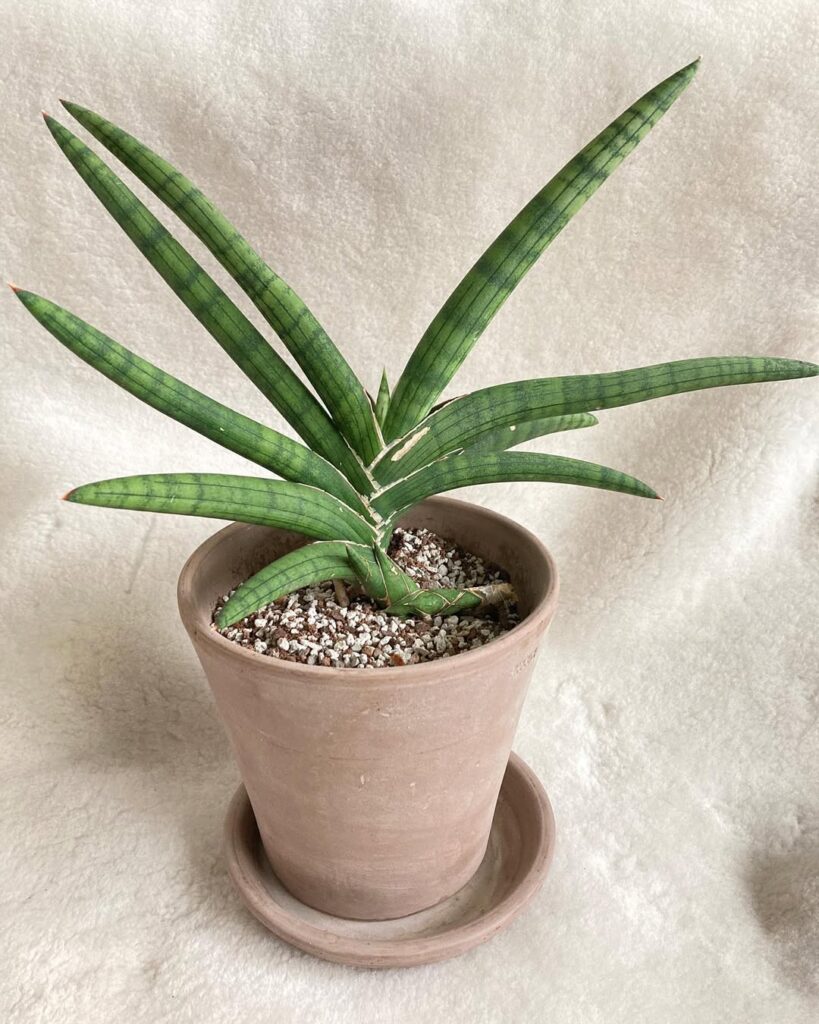
Sansevieria hargeisana, now classified as Dracaena hargeisana, is a stemless, perennial succulent native to Kenya. It features short, erect stems that branch at or above ground level, producing cylindrical leaves with a shallow channel at the base and rust-colored margins. The foliage has a slightly rough texture, with dark green cross-banding, adding to its distinctive appearance.
Sansevieria humbertiana
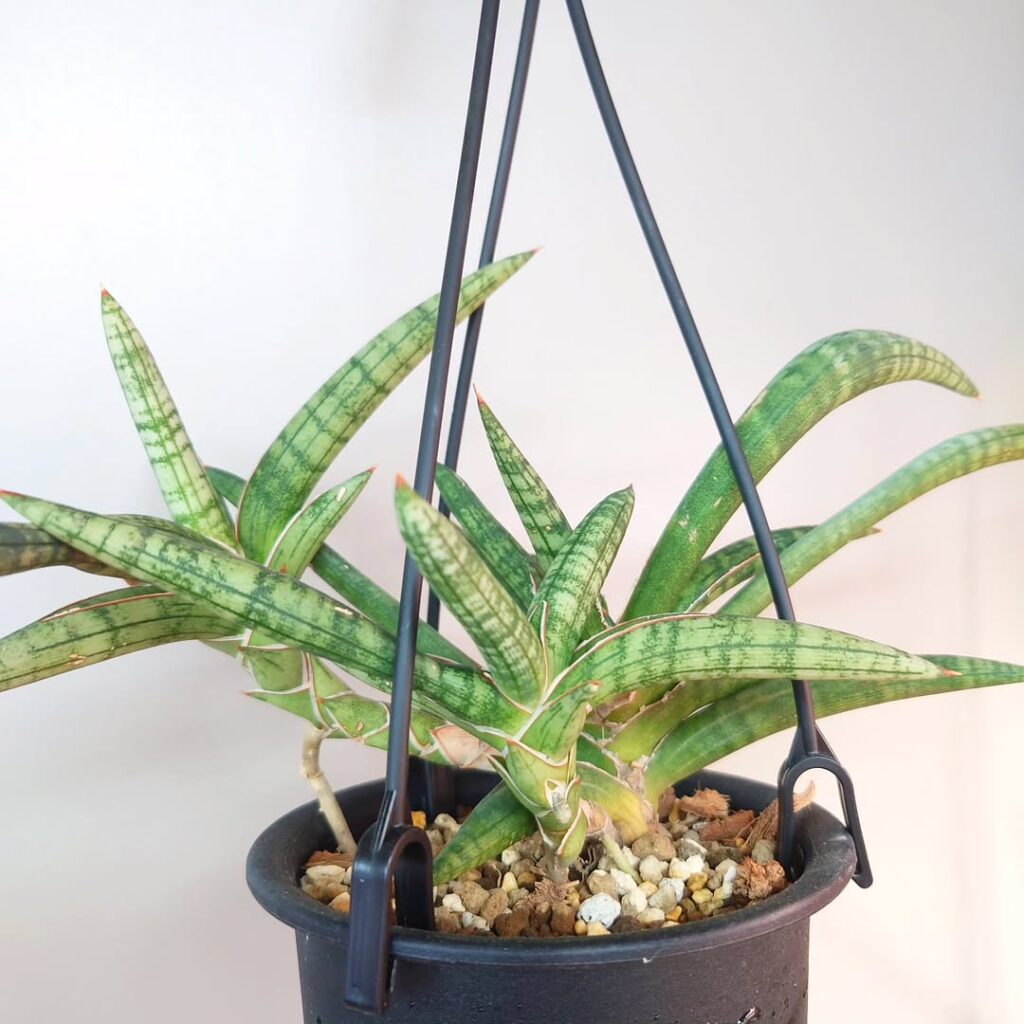
Sansevieria humbertiana, now classified as Dracaena humbertiana, is a stemless, perennial succulent native to Kenya and Tanzania. It features long, narrow, pointed leaves that can grow up to 24 inches in length, with dark green coloration and light green horizontal stripes. The foliage grows in a tight rosette, forming an elegant, structured appearance.
Sansevieria hyacinthoides
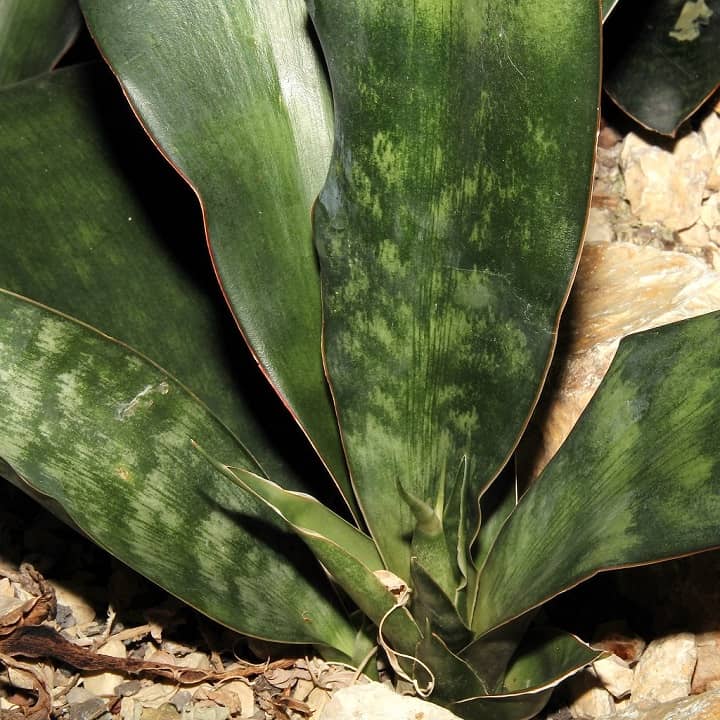
Known for its dense clusters of foliage, this species naturally thrives in shaded areas beneath trees. Its broad, medium-green leaves with darker crossbands grow in a loose rosette formation, reaching up to 4 feet long. Over time, it develops long creeping rhizomes, allowing it to spread and establish itself.
To keep Sansevieria hyacinthoides thriving, provide at least 4 hours of sunlight daily, ensuring temperatures remain between 68-86°F. A permeable, well-draining potting mix is best, and watering should be moderate, allowing some dryness between waterings to prevent excess moisture retention.
Sansevieria javanica
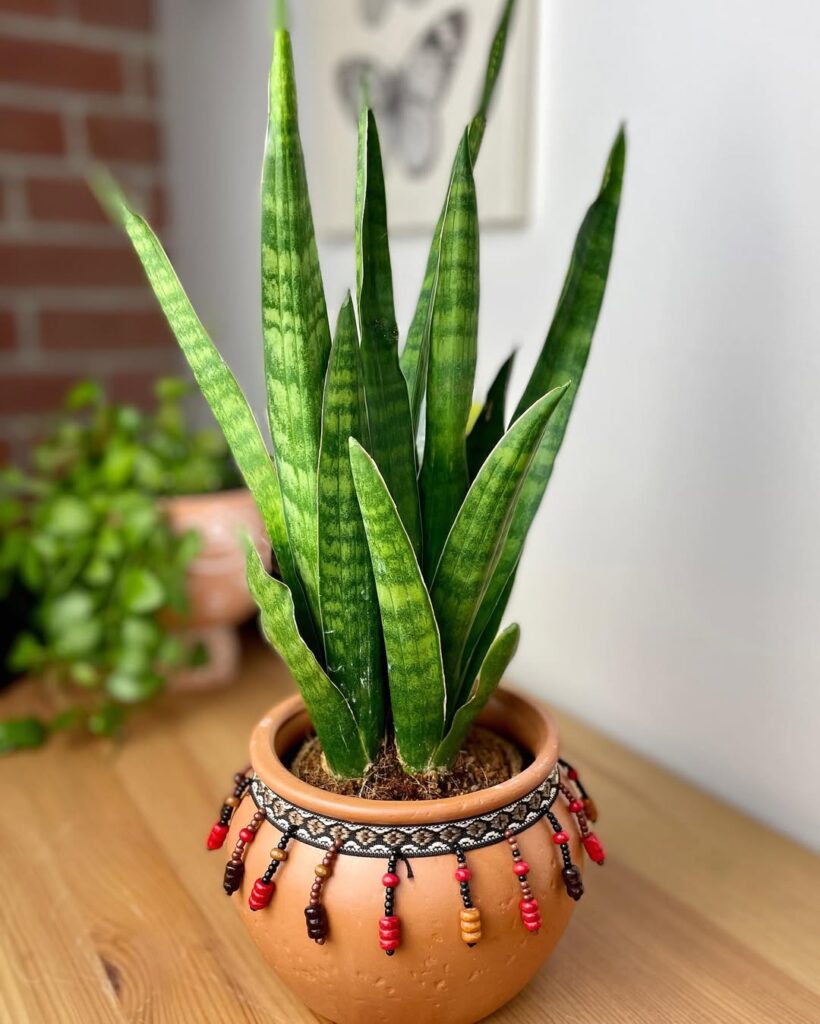
Sansevieria javanica, now classified as Dracaena javanica, is a compact, upright-growing succulent native to Indonesia and Southeast Asia. It features elongated, slightly curved leaves with light green coloration and dark green horizontal bands, creating an appealing texture. The foliage grows in dense clusters, forming a structured, elegant appearance.
Sansevieria kirkii var. kirkii
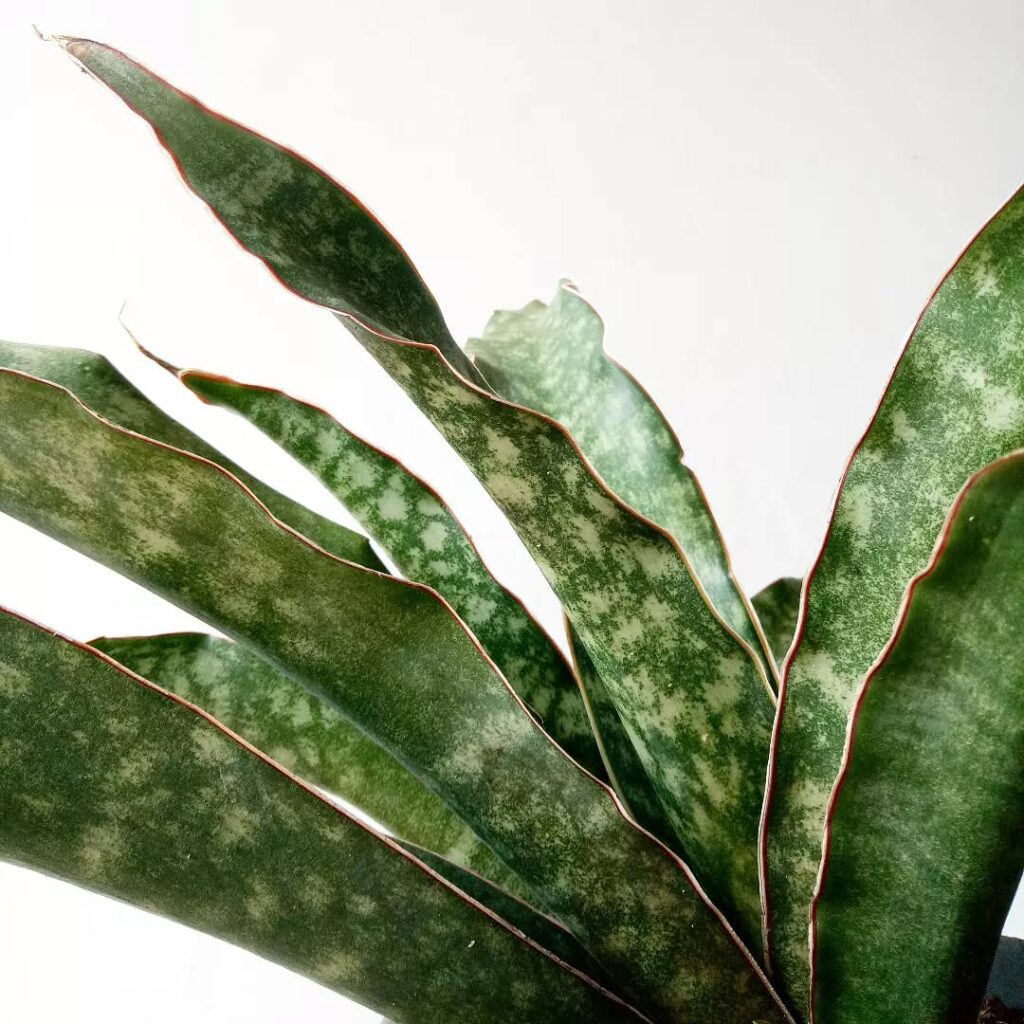
Sansevieria kirkii, now classified as Dracaena pethera, is a stemless, perennial succulent native to East Africa, particularly Tanzania, Kenya, Malawi, Mozambique, Zambia, and Zimbabwe. It is commonly known as Star Sansevieria due to its bold architectural form and mosaic-like leaf patterns. The foliage is long, lance-shaped, with wavy edges and a mix of green, gray, and white markings, creating a striking visual contrast.
Sansevieria kirkii var. pulchra
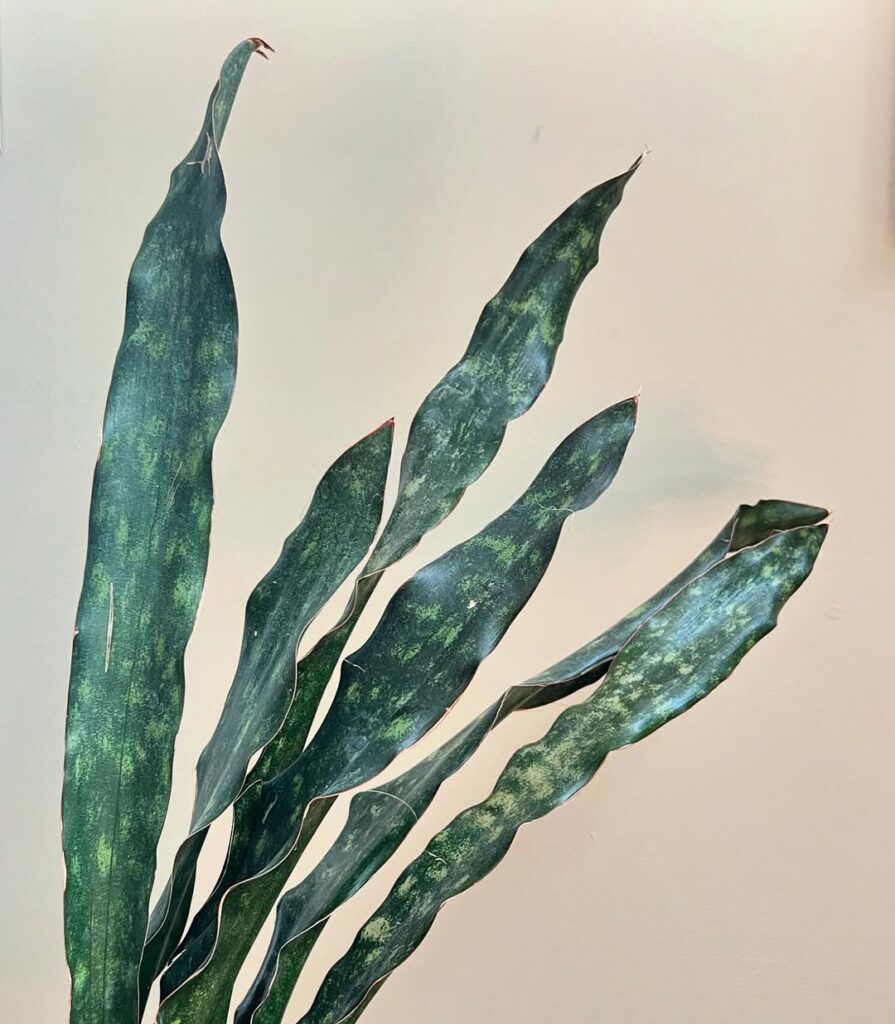
Sansevieria kirkii var. pulchra, now classified as Dracaena pethera var. pulchra, is a stemless, perennial succulent native to Tanzania, Malawi, and Zanzibar. It thrives in rocky coastal habitats, forming a dense ground cover in some areas. The leaves are long, lance-shaped, with wavy edges and a mix of green, gray, and white mottling, creating a striking visual contrast.
This variety is admired for its rigid, thick foliage, which can grow up to 18–36 inchesmet long. The margins are narrow, hardened, and reddish-brown, sometimes breaking into thread-like fibers as the plant matures. It produces greenish-white, fragrant flowers on a conical inflorescence, followed by small, orange berries.
Sansevieria kirkii var. pulchra ‘Coppertone’
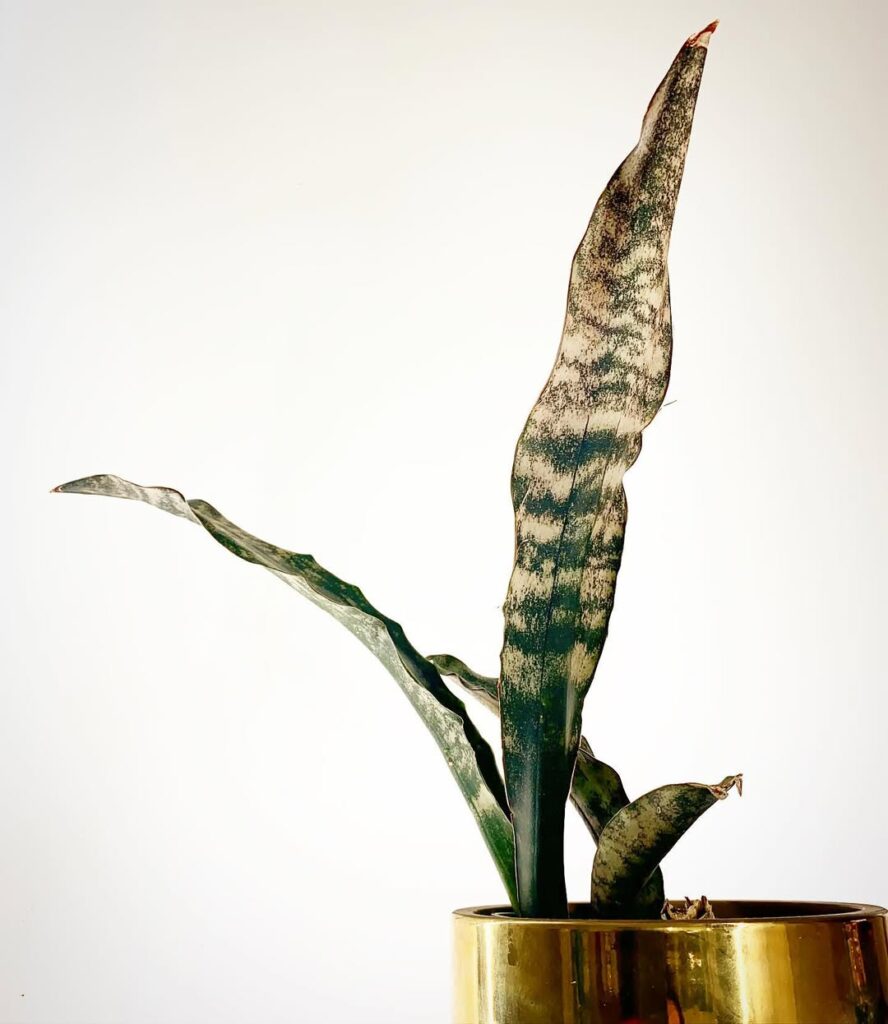
Sansevieria kirkii ‘Coppertone’, now classified as Dracaena pethera var. pulchra, is a rare cultivar known for its deep bronze, copper-toned leaves. The foliage is long, slightly wavy, and grows in a compact rosette, creating a structured yet elegant form. Bright sunlight enhances its metallic sheen, making it a visually striking addition to collections.
Sansevieria kirkii var. pulchra ‘Silver Blue’
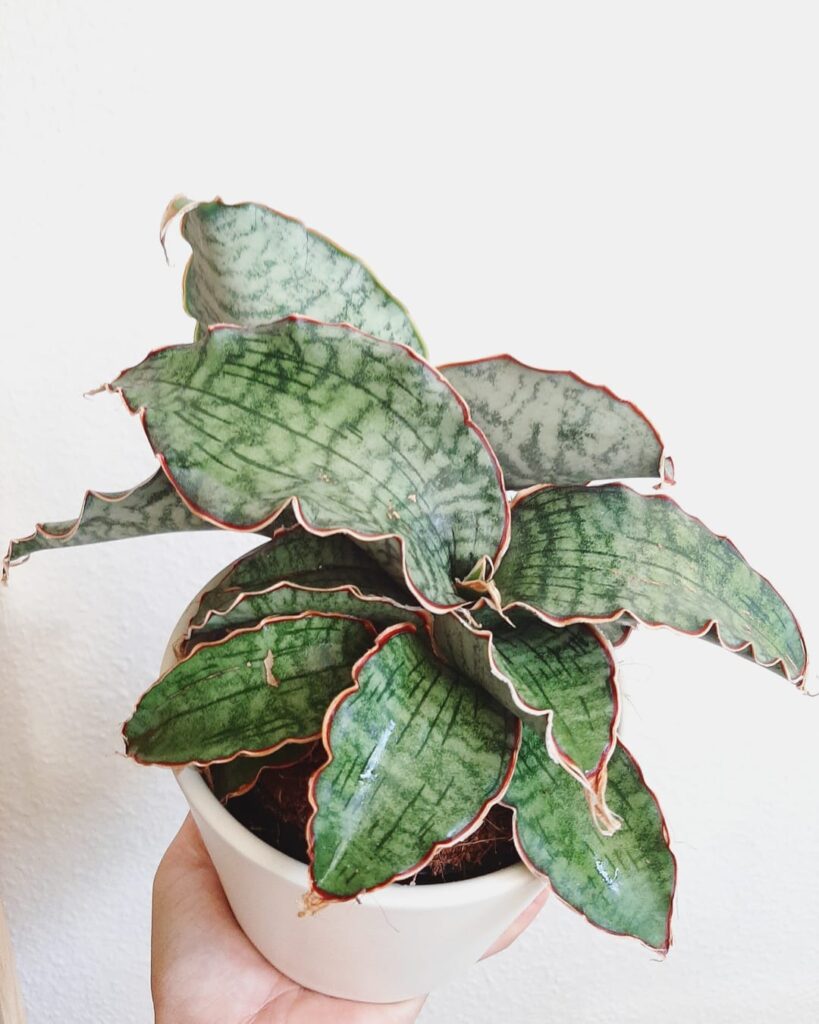
Sansevieria kirkii ‘Silver Blue’, now classified as Dracaena pethera var. pulchra, is a rare cultivar known for its thick, silvery-blue leaves with dark green mottling and longitudinal lines. The foliage is exceptionally rigid, with wavy margins edged in red-brown, sometimes breaking into thread-like fibers as the plant matures.
Sansevieria kitonga
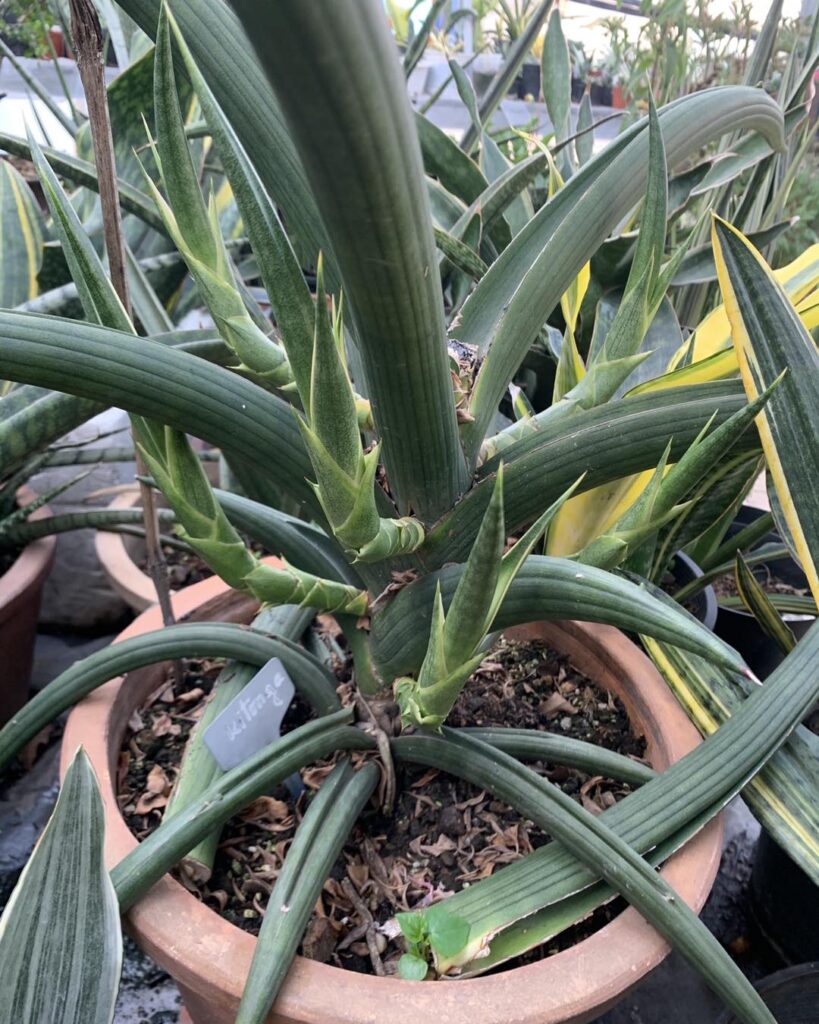
Sansevieria kitonga, now classified as Dracaena kitonga, is a rare, stemless succulent native to Kitonga Gorge, Tanzania. It features cylindrical, upright leaves with dark green coloration and lighter mottled patterns, creating a striking contrast. The leaf margins often have a reddish-brown outline, adding to its unique appearance.
This species is closely related to Sansevieria bella, downsii, and phillipsiae, sharing similar growth habits and leaf structure.
Sansevieria koko
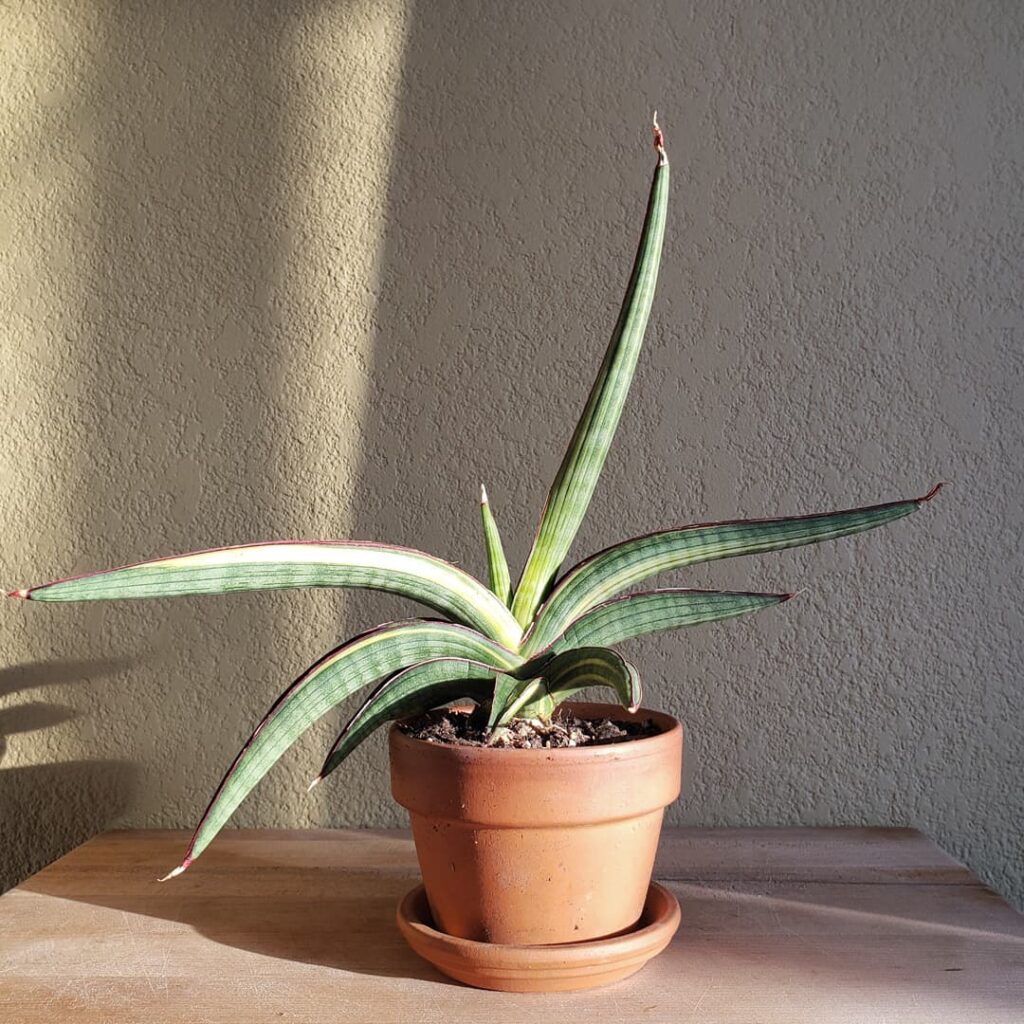
Sansevieria Koko is a compact, rare cultivar known for its yellow-green variegated leaves. The foliage grows in a tight, upright cluster, making it a visually striking addition to succulent collections. It thrives in dry conditions, requiring minimal care, and is admired for its unique coloration and structured form.
Sansevieria laevifolia
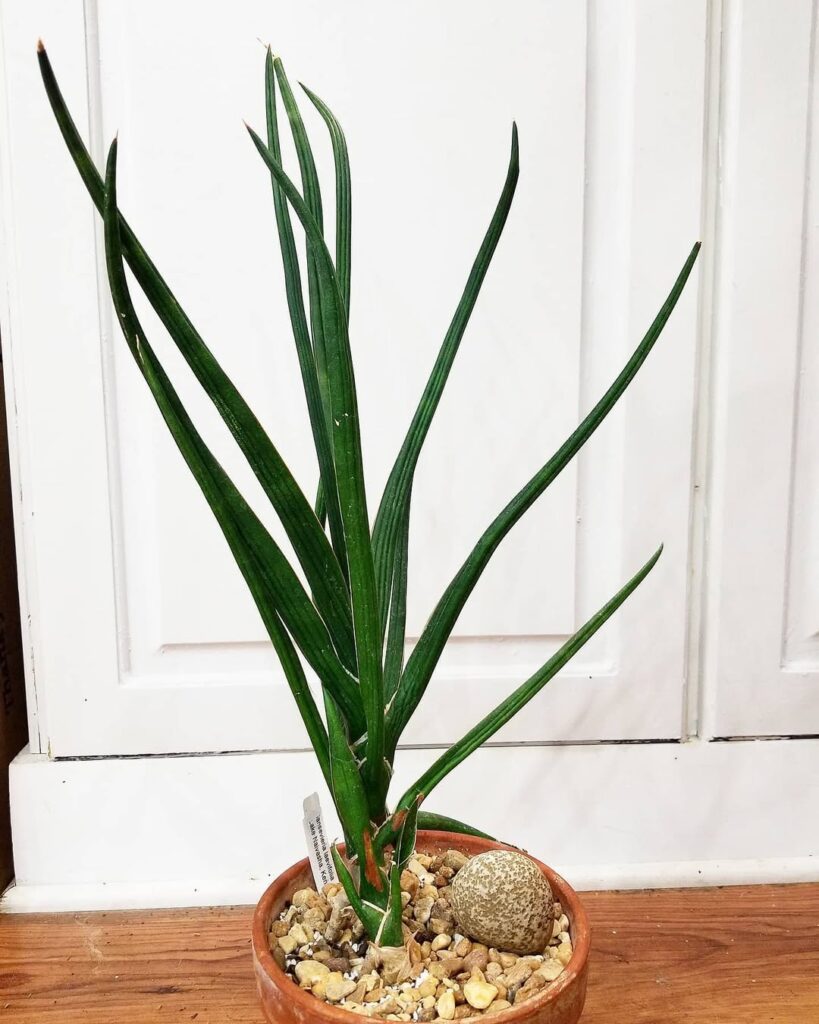
Sansevieria laevifolia, now classified as Dracaena laevifolia, is a stemless, perennial succulent native to the Rift Valley of Kenya. It features long, narrow, cylindrical leaves with deep grooves, growing in an ascending to spreading pattern. The foliage is dark green, often displaying lighter mottled markings, and has reddish edges, adding contrast to its structured form.
Sansevieria ‘Leopard Bat’
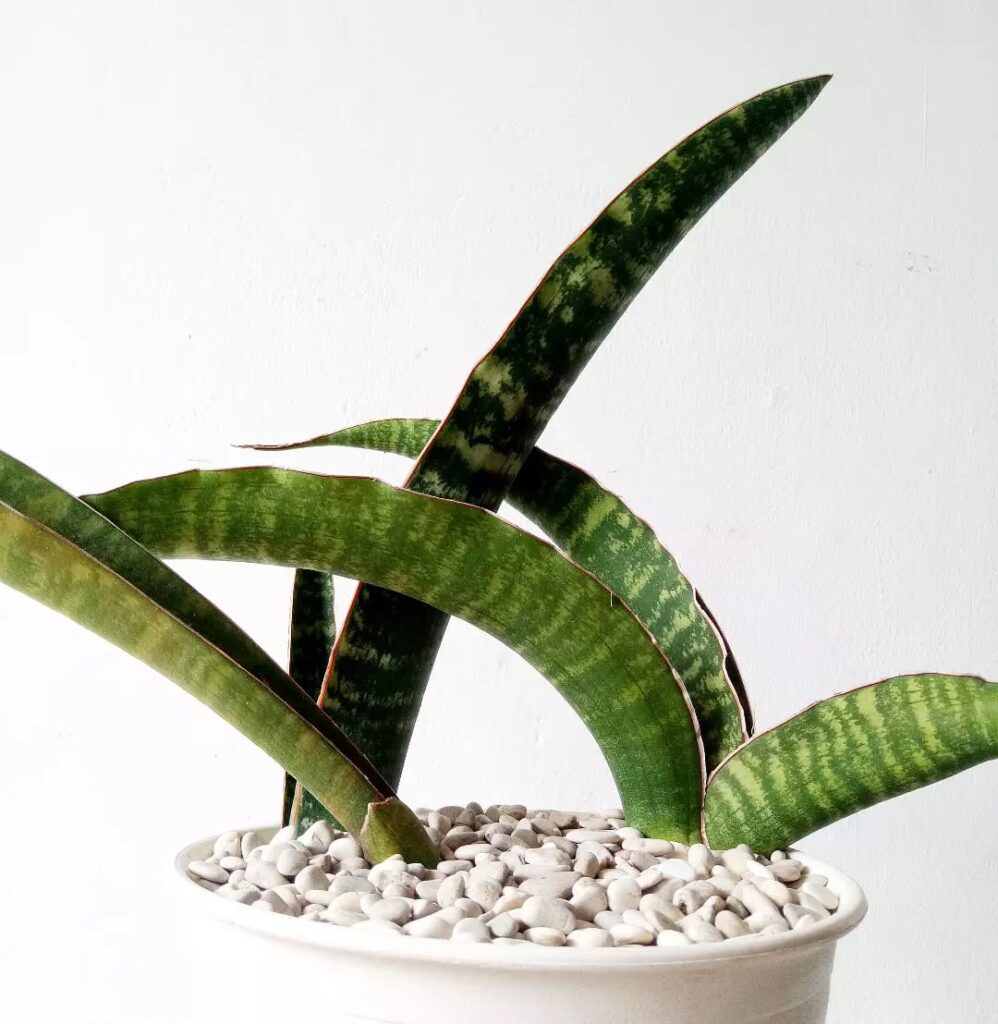
Sansevieria ‘Leopard Bat’ is a rare cultivar known for its thick, mottled leaves with green and creamy white variegation. As the plant matures, the markings deepen, creating a striking contrast. The leaves are semi-rounded, featuring a curved groove on top and light brown to tan-colored partial margins.
Sansevieria liberica
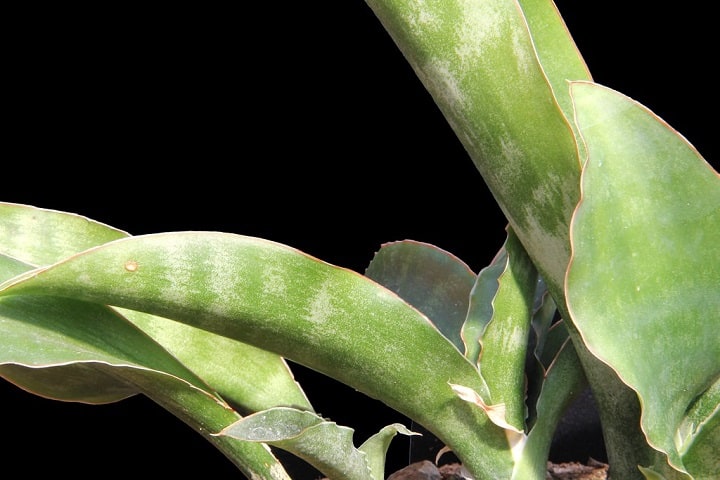
Native to the Central African Republic and West Africa, this variety produces up to six thick, lance-shaped leaves per shoot, growing in a vertical, structured formation. Each dark green leaf features pale horizontal bands and can reach up to 3 feet 7 inches tall. As the plant matures, its slightly pointed leaf tips gradually turn white, while the margins develop a reddish-brown, calloused edge.
During its bloom cycle, loose white flower clusters emerge on 2-2.6 foot stems, adding a delicate contrast to its structured foliage. S. liberica prefers shady environments and requires infrequent watering—allowing the soil to dry out thoroughly between waterings reduces the risk of root rot. Ideal temperatures range between 68-86°F, and a well-draining, slightly gritty mix provides optimal support.
Sansevieria longiflora
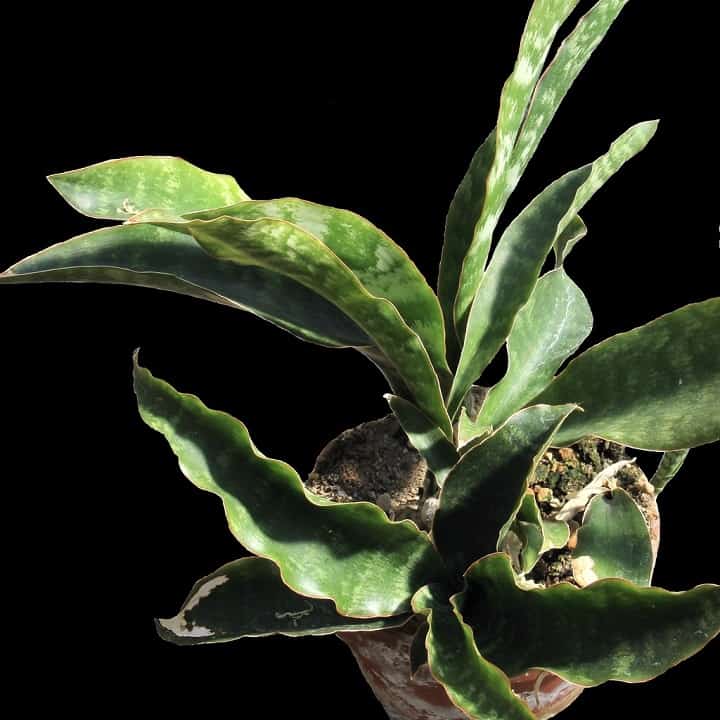
A striking variety from regions like Angola and Namibia, Sansevieria longiflora stands out with its irregularly banded or spotted dark green leaves, which have a smooth surface texture. These elongated leaves can grow up to 4 feet 11 inches long and 1.2-3.5 inches wide, offering a dramatic presence in any plant collection.
Leaf margins are calloused, with coloration shifting between reddish-brown and yellow, while the tips are adorned with small brown spines (0.1-0.2 inches long). White panicle-shaped flowers appear during its flowering cycle, adding to its distinctive charm. Grow in sunny or shaded areas, ensuring moderate watering with a slight drying period between waterings. Keep temperatures between 68-86°F, and use a sandy, well-draining potting mix to support healthy growth.
Sansevieria ‘Malawi’
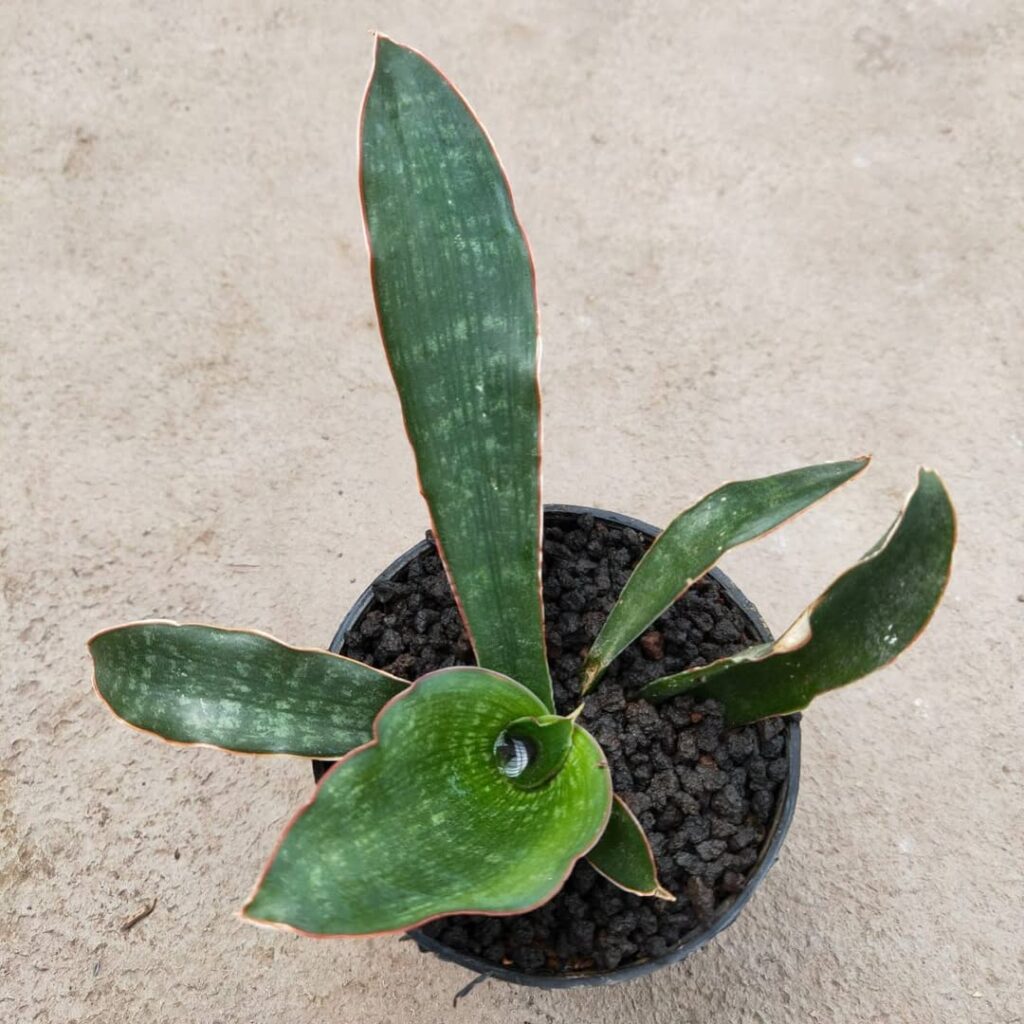
Sansevieria ‘Malawi’, now classified as Dracaena malawiana, is a rare species native to Malawi, originally collected at Kapichira Falls. It was first described by B. Juan Chahinian as Sansevieria formosa in 2012 but later renamed to Dracaena malawiana in 2018. This species features long, narrow, mottled green leaves with lighter green spots and reddish-brown margins, creating a striking contrast.
Sansevieria ‘Malawi Bat’
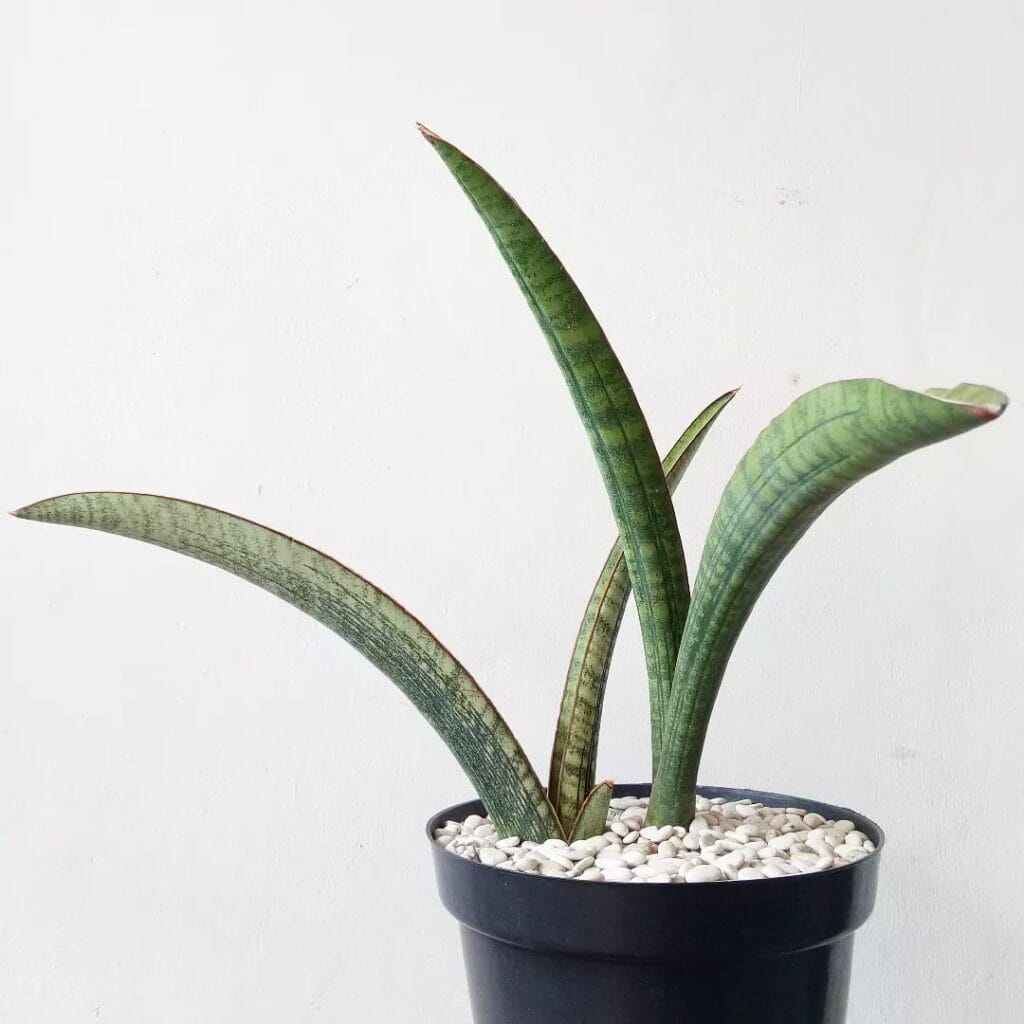
Sansevieria ‘Malawi Bat’, also known as Sansevieria sinus-simiorum, is a rare, herbaceous perennial succulent native to Malawi. It is distinguished by its thick, cylindrical leaves with a massive “D” section, making it one of the largest “bat” Sansevierias. The foliage is dark green to brownish-grey, with impressed black-green longitudinal lines running along both the top and underside of the leaves. The leaf channel is less pronounced than in other “bat” Sansevierias, and the edges are smoother, except at the leaf tip.
Sansevieria ‘Malawi Midnight’
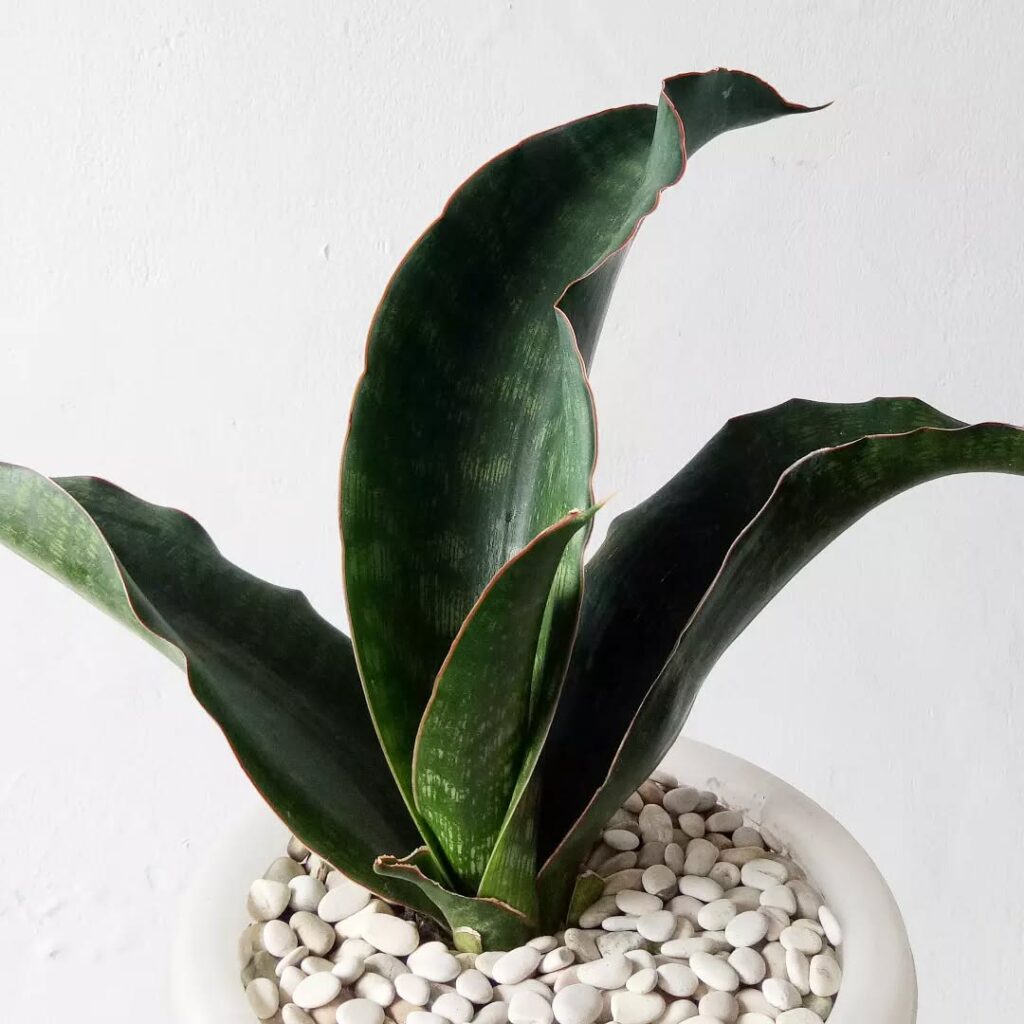
Sansevieria ‘Malawi Midnight’ is a rare, dark-leaved cultivar of Sansevieria, originally collected near Monkey Bay, Malawi. It is distinguished by its black-green foliage, which appears almost midnight-dark under certain lighting conditions. The leaves are thick, upright, and slightly curved, with reddish-brown margins, adding contrast to its structured form.
Sansevieria masoniana
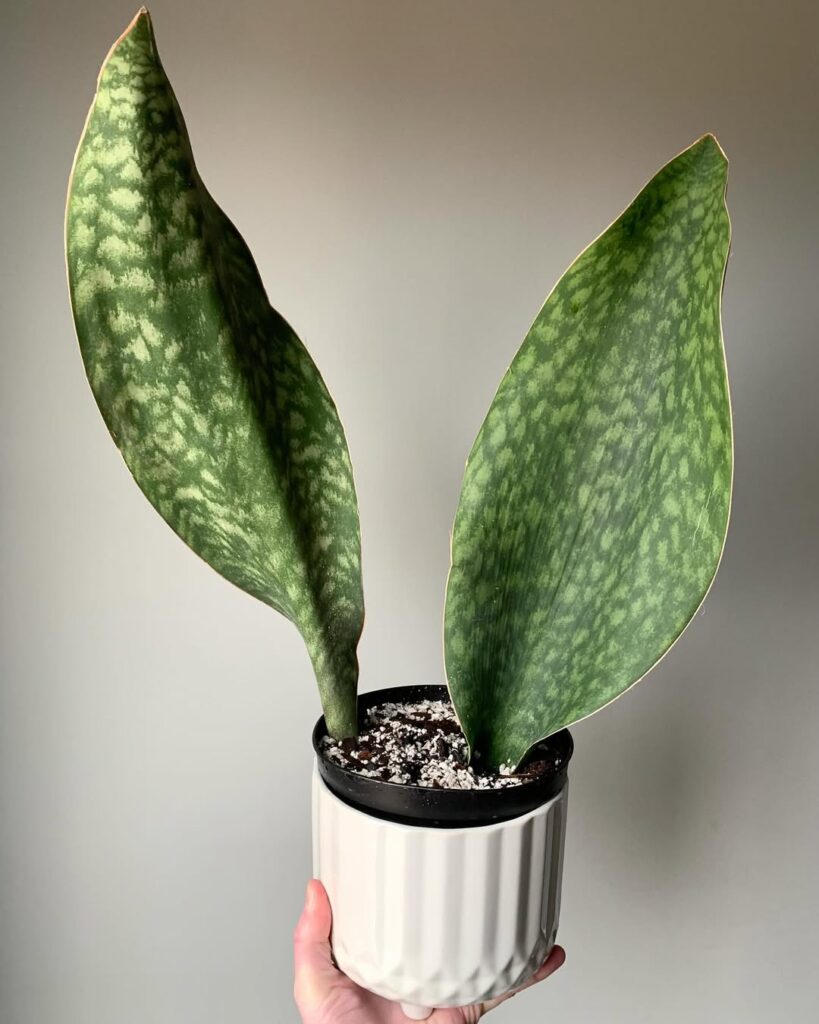
Sansevieria masoniana, now classified as Dracaena masoniana, is a semi-succulent, stemless perennial native to central Africa, originally collected in the Democratic Republic of the Congo. It is commonly known as Whale Fin or Mason’s Congo due to its broad, paddle-shaped leaves, which can grow up to 4 feet long and 10 inches wide.
The foliage is dark green with smudged light green spots, and the plant develops a unique purple-banded basal sheath below the soil level.
Sansevieria masoniana ‘Variegata’
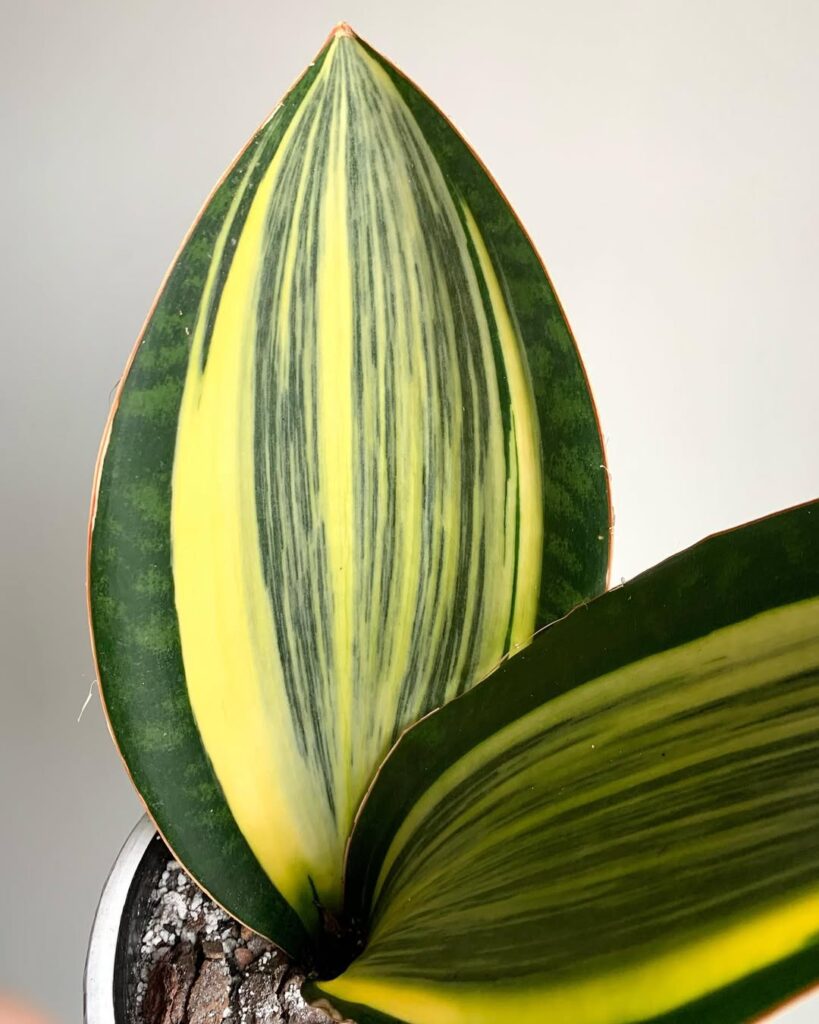
Sansevieria metallica
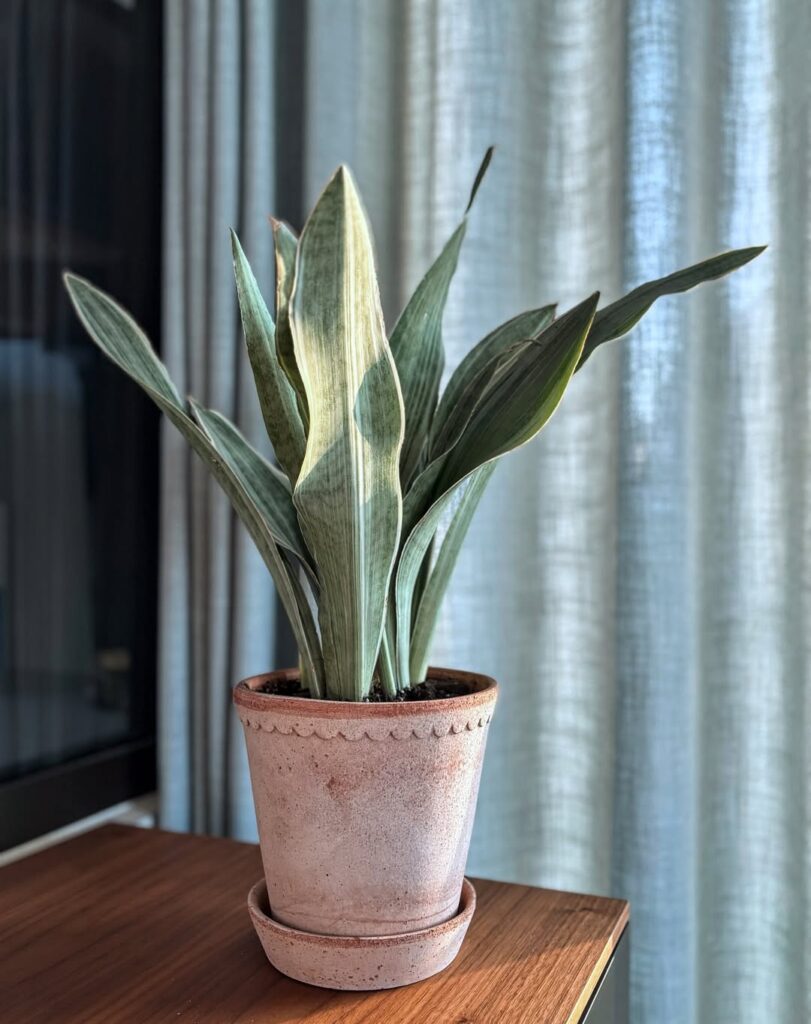
Sansevieria metallica, now classified as Dracaena metallica, is a rare, stemless succulent known for its silvery-green, metallic sheen on its long, sword-shaped leaves. The foliage features fine grayish vertical striping, giving it a distinct shimmering effect when exposed to light.
This species is native to tropical Africa, where it thrives in dry, rocky environments. It is a slow-growing, drought-tolerant plant, making it ideal for low-maintenance indoor gardening. Mature plants can reach 2–3 feet in height, producing greenish-white, fragrant flowers on tall stalks.
Sansevieria metallica ‘Variegata’
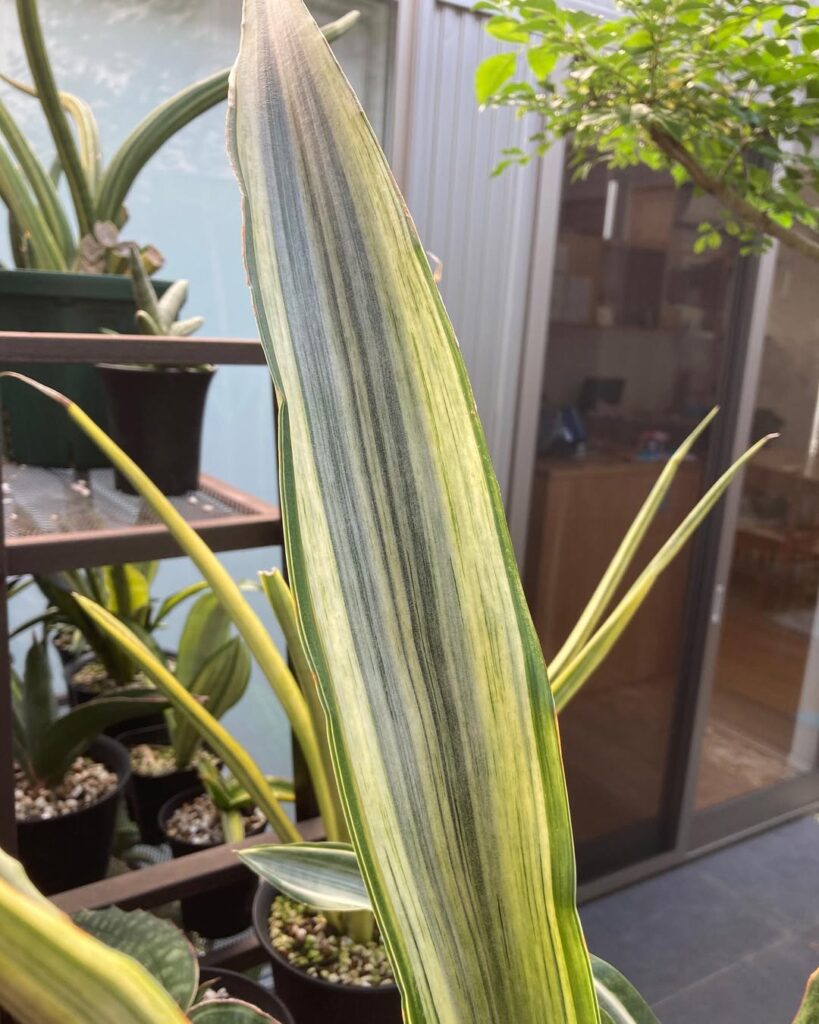
Sansevieria nilotica
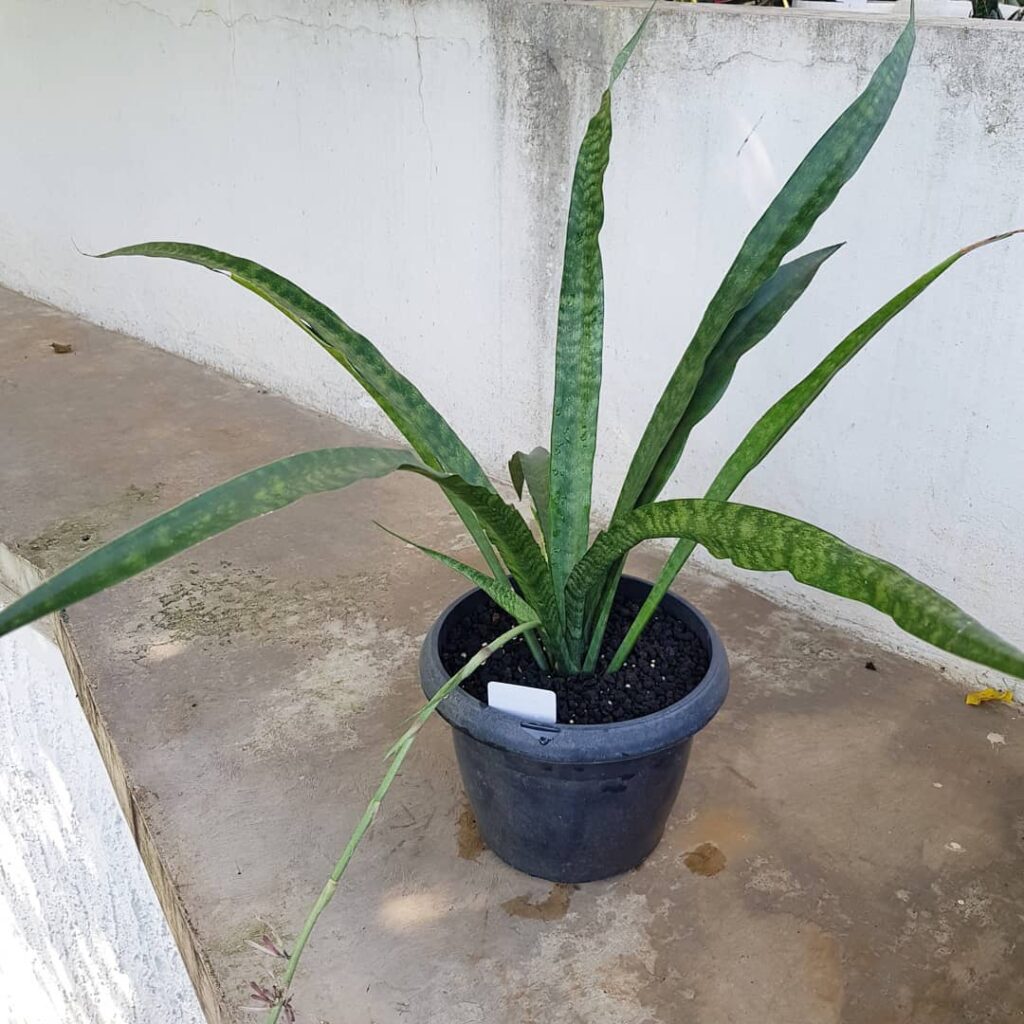
Sansevieria nilotica, now classified as Dracaena nilotica, is a stemless, perennial succulent native to Sudan, Kenya, Tanzania, and Ethiopia. It is commonly known as the Nile River Snake Plant or Blue Sansevieria, due to its bluish-green, cylindrical leaves with dark green stripes. The foliage grows in dense clusters, forming an elegant, structured appearance.
Sansevieria nitida
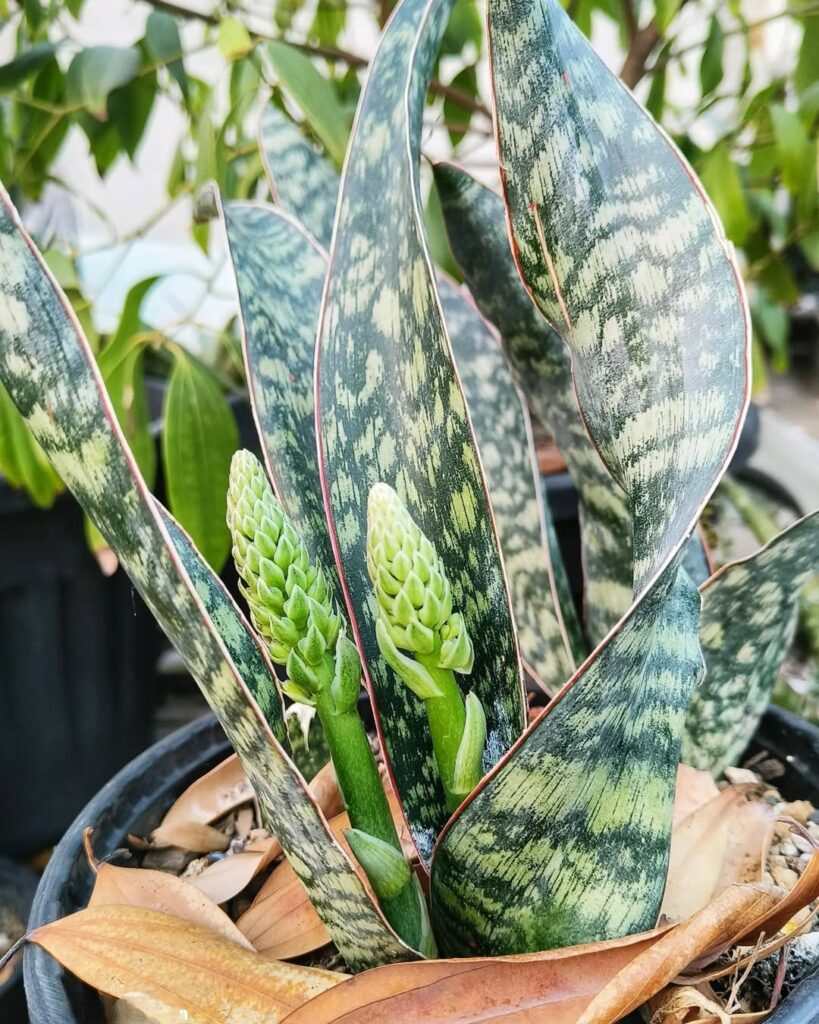
Sansevieria nitida, now classified as Dracaena nitida, is a stemless, perennial succulent native to Kenya. It features erect-spreading, lanceolate leaves with dense lighter gray-green blotches and cross-banding. The foliage is smooth and shiny on the upper surface, while the underside is rough and dull, creating a striking contrast.
Sansevieria parva
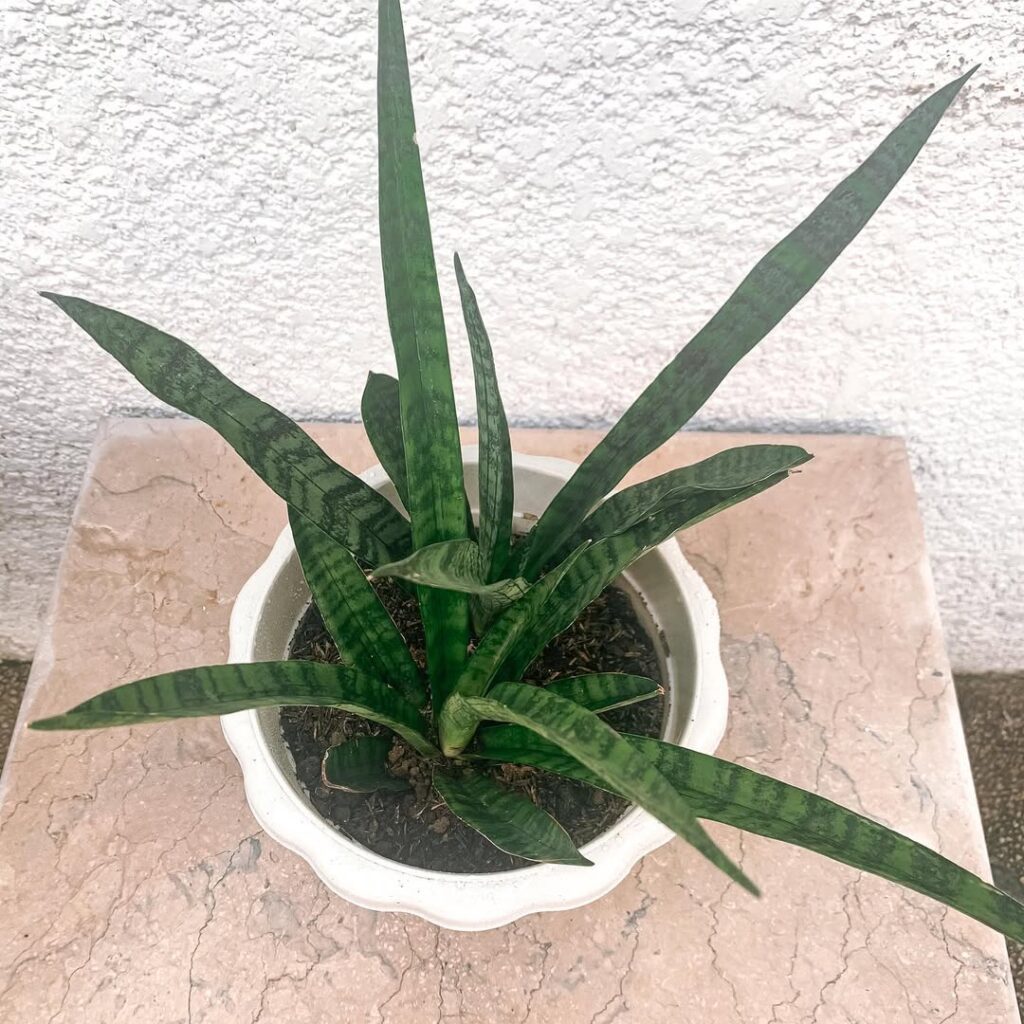
Relatively small for a Sansevieria, S. parva features linear to lance-shaped dark green leaves loosely arranged in a rosette pattern. Its foliage is marked with horizontal bands, adding subtle texture. This species produces showy white to pink flowers, making it an attractive addition to indoor spaces.
Native to Kenya, Uganda, and Rwanda, S. parva is easy to care for with the right conditions. Provide bright light from a sunny or partially shaded window. It thrives in temperatures between 68-86°F. Use a well-draining, slightly gritty potting mix and water sparingly, allowing the soil to dry between waterings to prevent root issues.
Sansevieria parva ‘Variegata’
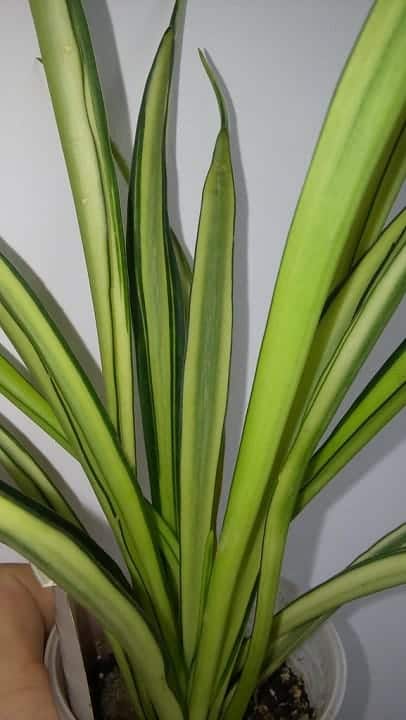
Sansevieria patens
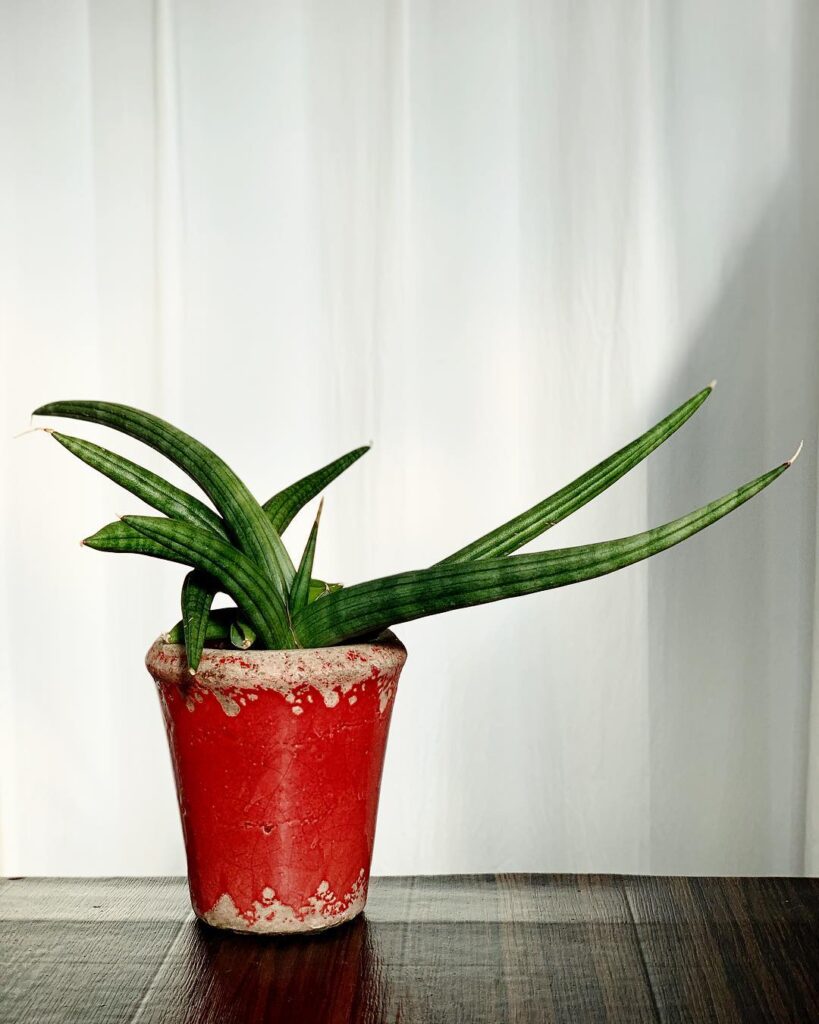
Sansevieria patens, now classified as Dracaena patens, is a stemless, perennial succulent native to Kenya. It is known for its long, cylindrical leaves that grow in a rosette pattern, often spreading in different directions, giving it an octopus-like appearance. The foliage is dark green with lighter mottled markings, and the leaf tips tend to have a whitish hue.
Sansevieria patens ‘Variegata’
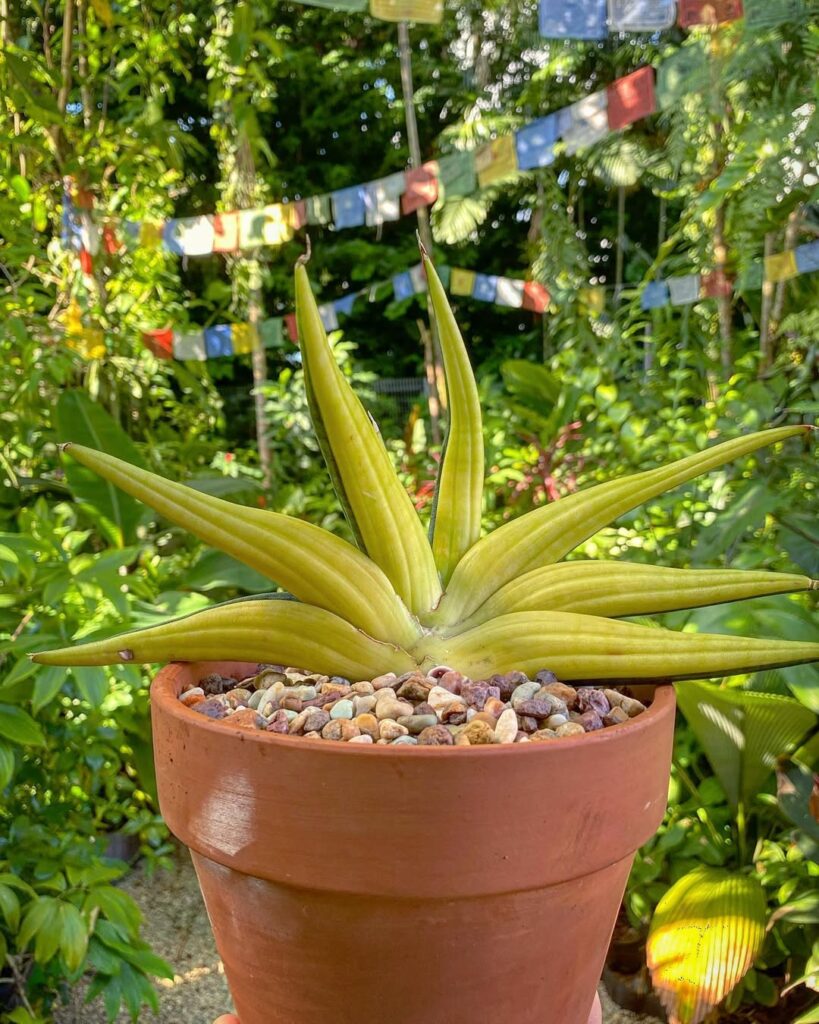
Sansevieria pearsonii
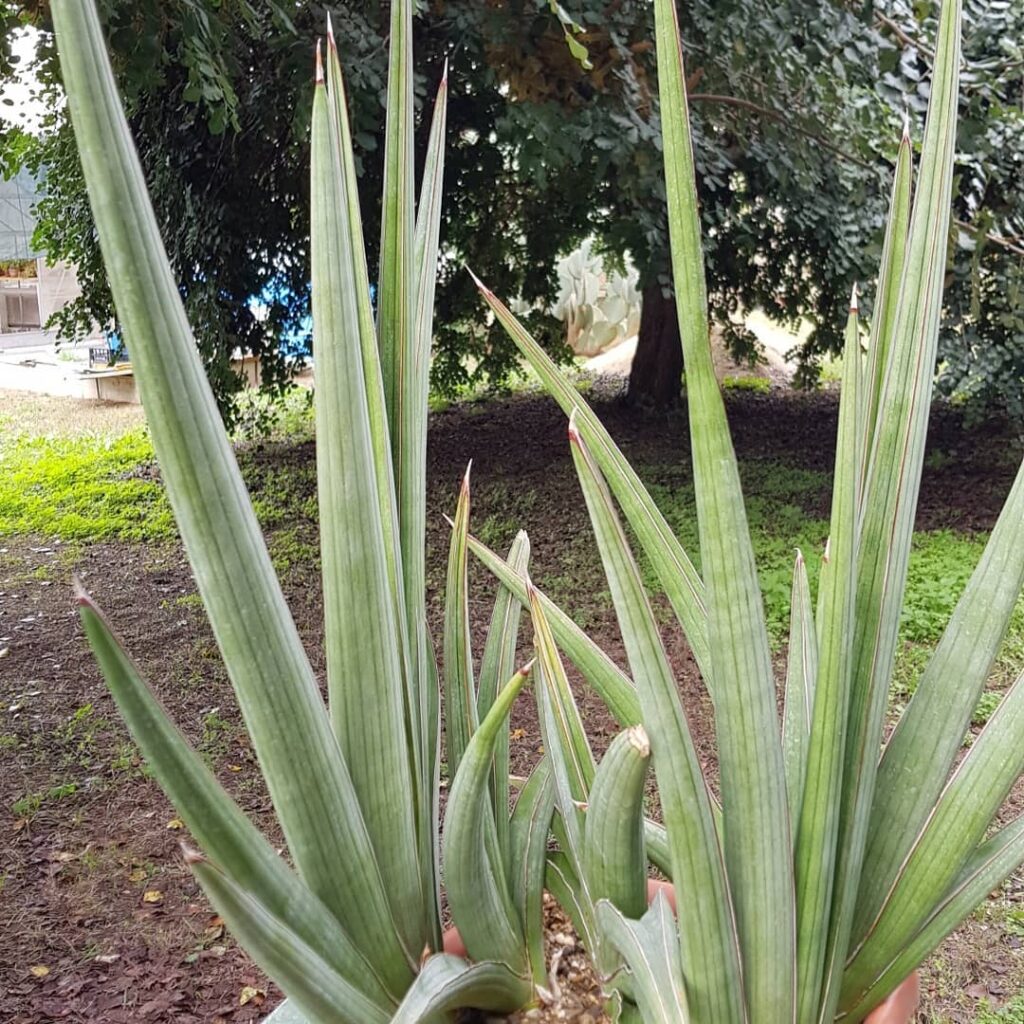
Sansevieria pearsonii, now classified as Dracaena pearsonii, is a stemless, fibrous perennial succulent native to South Africa, Swaziland, Namibia, and tropical Africa up to southern Tanzania. It is commonly known as Gemsbok Horn or Spiky Mother-in-Law’s Tongue, due to its rigid, sharply pointed, cylindrical leaves that grow in dense, upright clusters.
The foliage is dark green to bluish-green, with faint banding and numerous interrupted darker lines. Each leaf has a narrow groove on the inside, tapering to a very acute, rigid, whitish point. Mature plants produce white or pink-tinged flowers on tall, spike-like racemes, followed by small, orange berries
Sansevieria pedicellata
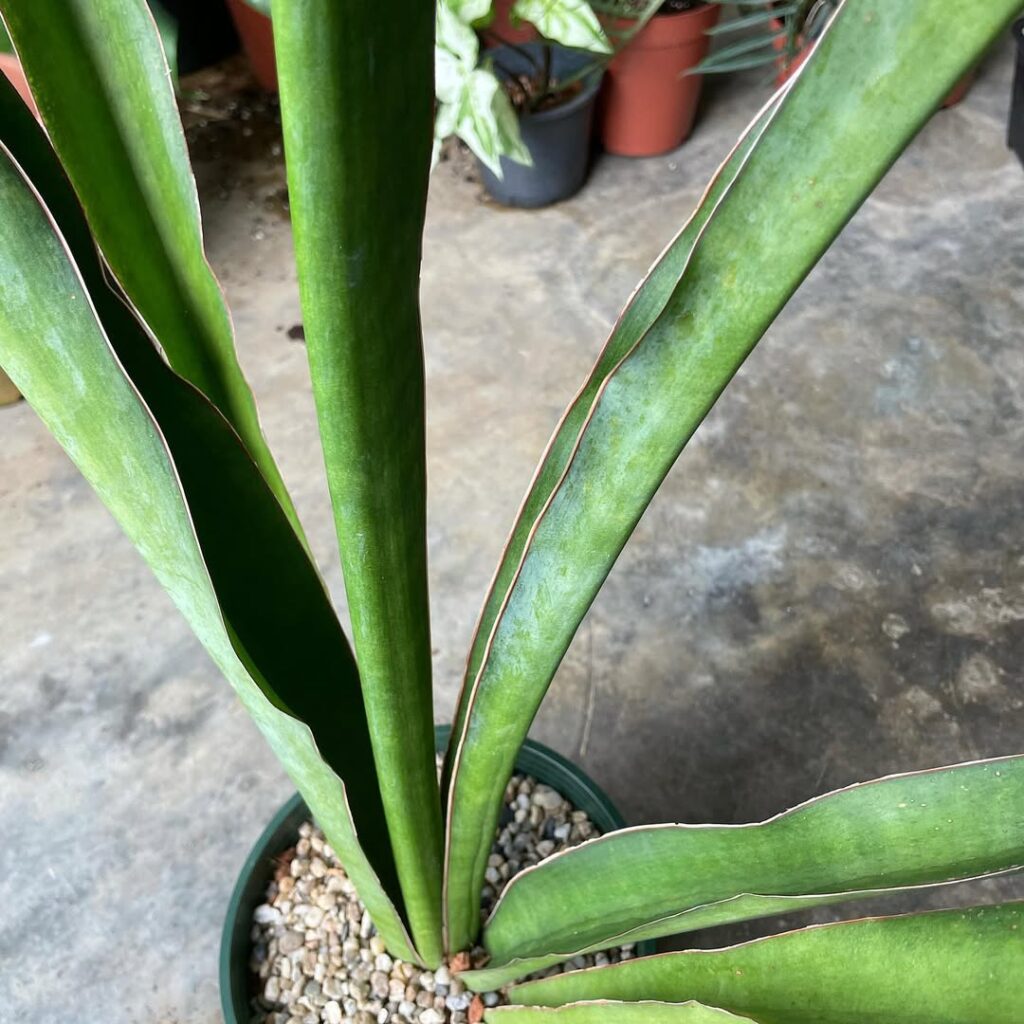
Sansevieria pedicellata, now classified as Dracaena pedicellata, is a stemless, evergreen succulent native to Mozambique and eastern Zimbabwe, thriving in moist evergreen forests and rocky streamside habitats, where it forms large clusters. It features long, narrow leaves with mottled green coloration and reddish edges, growing in dense clumps supported by rhizomatous roots, allowing gradual spread.
Mature plants produce sweetly scented flowers, followed by small, orange berries, and are valued for medicinal properties, traditionally used to treat gonorrhea, scrotal elephantiasis, and infant infections. Despite local harvesting, it remains classified as Least Concern on the IUCN Red List, with stable populations.
Sansevieria perrotii

Sansevieria perrotii, now classified as Dracaena perrotii, is a rare, stemless succulent native to the Democratic Republic of Congo, Uganda, and Zambia. It is commonly known as Perrot’s Snake Plant or Congo Sansevieria, admired for its rosette-shaped growth pattern and unique foliage.
The leaves are stiff, succulent, and green, with faint light green spots. Unlike other Sansevieria species, its foliage has a curved growth pattern, forming a dense, fountain-like cluster. Mature plants produce pale green flowers with a light fragrance, adding to their ornamental appeal.
Sansevieria pfisterii
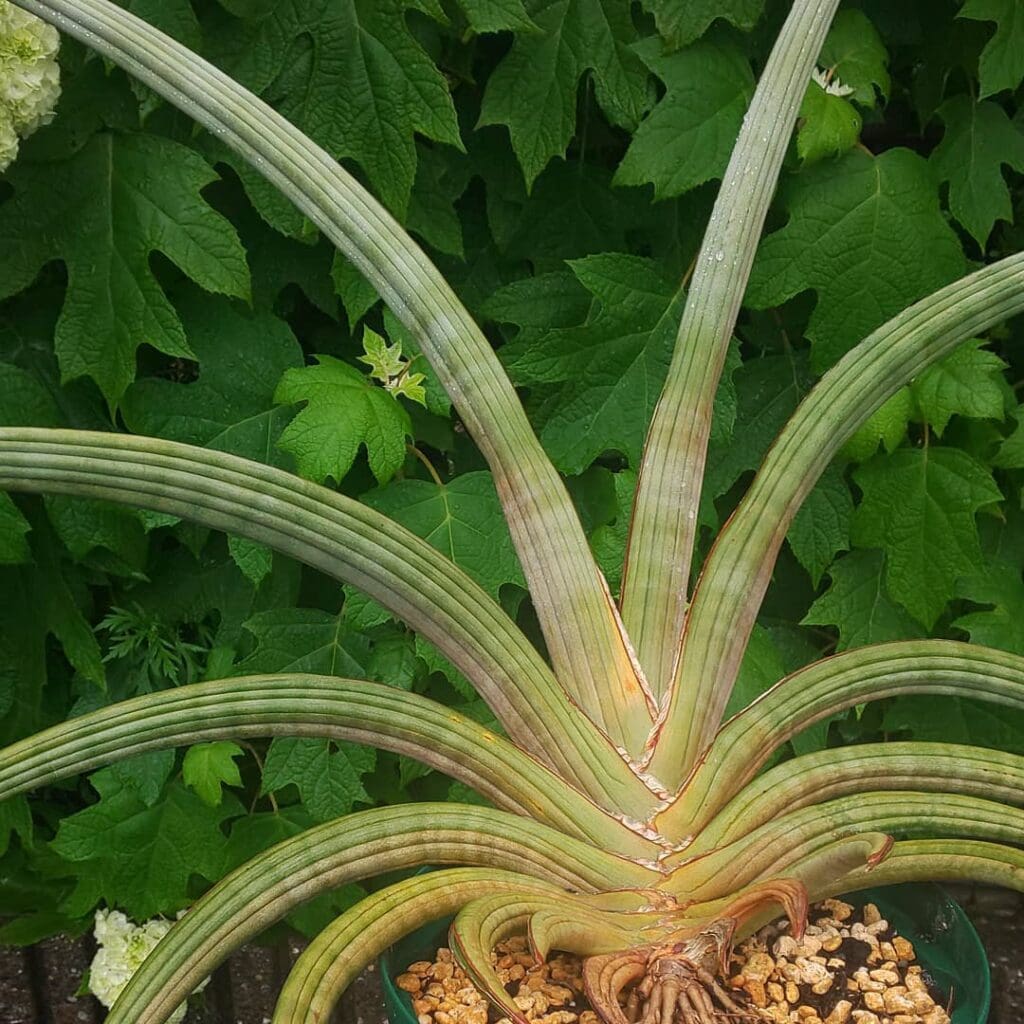
Sansevieria pfisterii, now classified as Dracaena pfisterii, is a rare, stemless succulent known for its thick, upright leaves with dark green coloration and lighter mottled patterns. The foliage has reddish-brown margins, adding contrast to its structured form.
Sansevieria phillipsiae
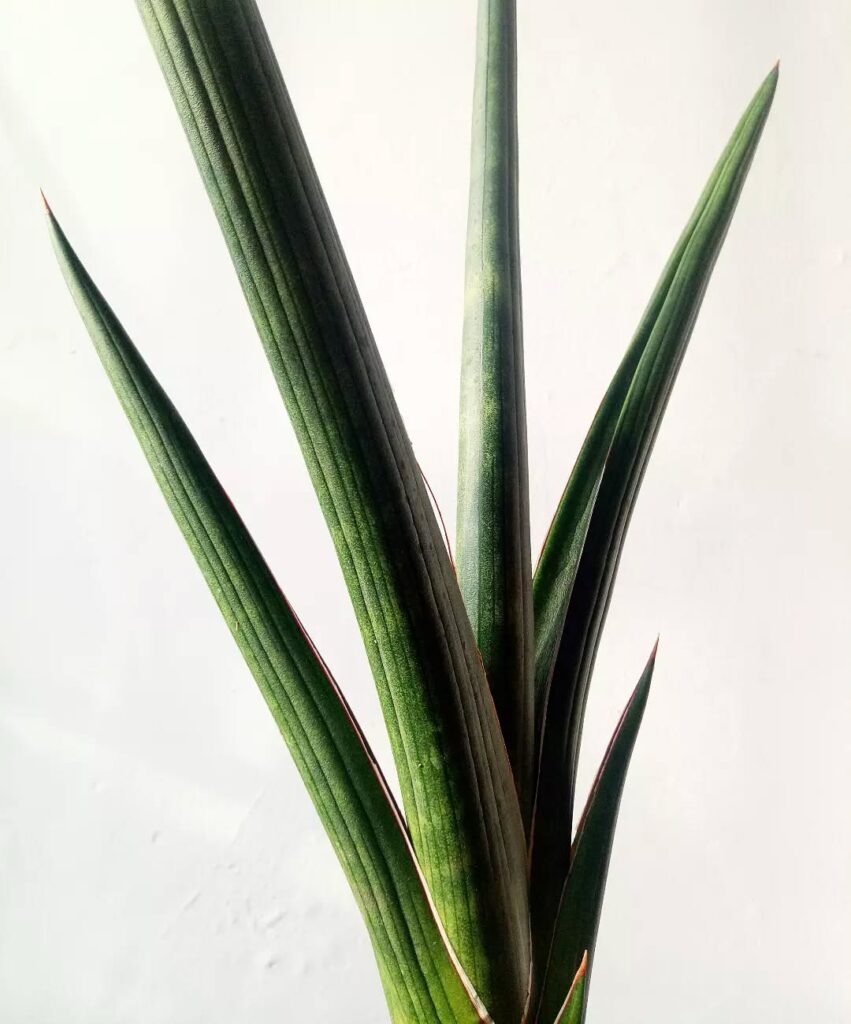
Sansevieria phillipsiae, now classified as Dracaena phillipsiae, is a stemless, perennial succulent native to East Africa, particularly Ethiopia, Kenya, and Somalia. It features long, narrow, cylindrical leaves with deep grooves, growing in an ascending to spreading pattern. The foliage is dark green, often displaying lighter mottled markings, and has reddish edges, adding contrast to its structured form.
Sansevieria pinguicula
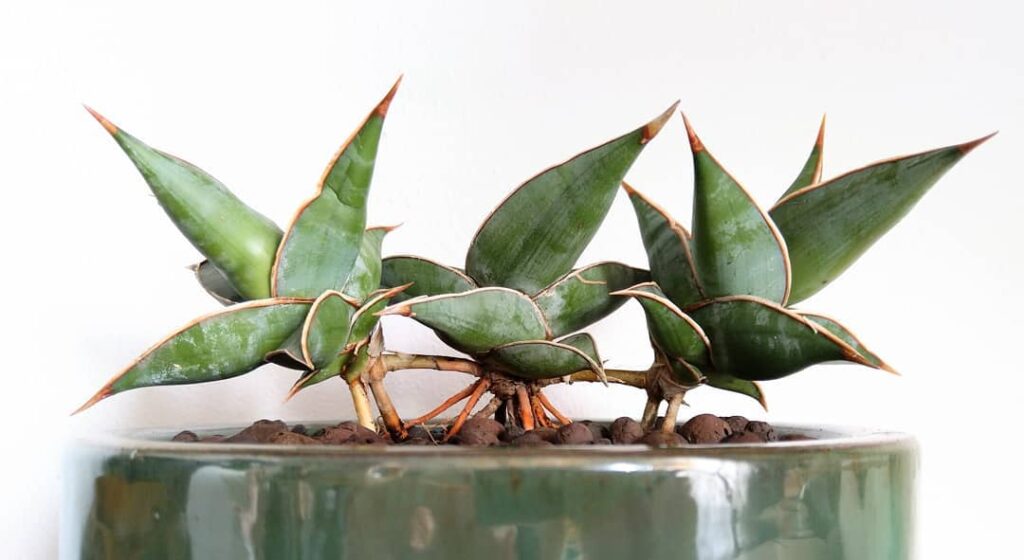
Sansevieria pinguicula, now classified as Dracaena pinguicula, is a rare, stemless succulent native to Kenya, particularly the Bura area near Garissa. It is commonly known as the Walking Sansevieria due to its unique aerial stolons, which produce stilt-like roots, making the plant appear as if it is “walking” away from its parent.
The leaves are thick, fleshy, and bluish-green, covered in a waxy cuticle with deep longitudinal grooves that develop in dry conditions. The margins are reddish-brown, leading to a sharp spine at the tip. Unlike most Sansevieria species, it does not grow from underground rhizomes but instead spreads via above-ground stolons, forming new plantlets.
Sansevieria pinguicula ‘Variegata’
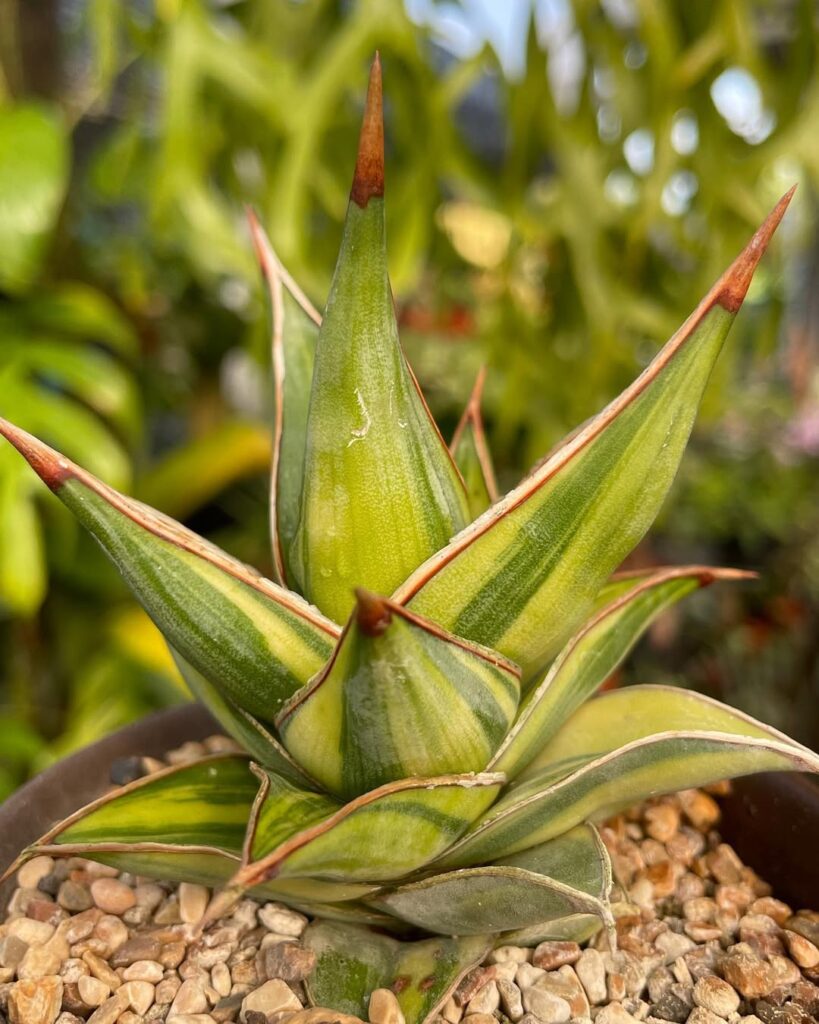
Sansevieria powellii
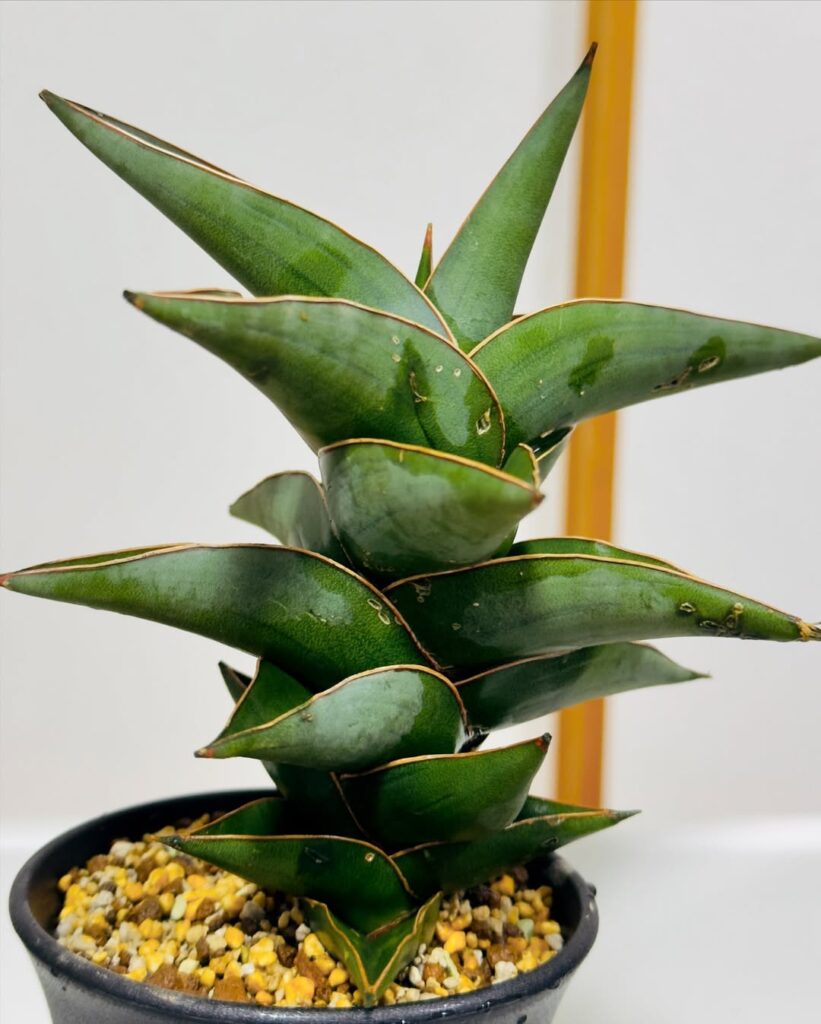
Sansevieria powellii, now classified as Dracaena powellii, is a rare, stemless succulent native to Zimbabwe and tropical West Africa. It is commonly known as Powell’s Snake Plant or Tall Zebra Snake Plant, admired for its long, slender leaves that grow in a graceful fan pattern. The foliage features distinctive pale green bands, creating a mesmerizing zebra-like effect
Sansevieria powysii
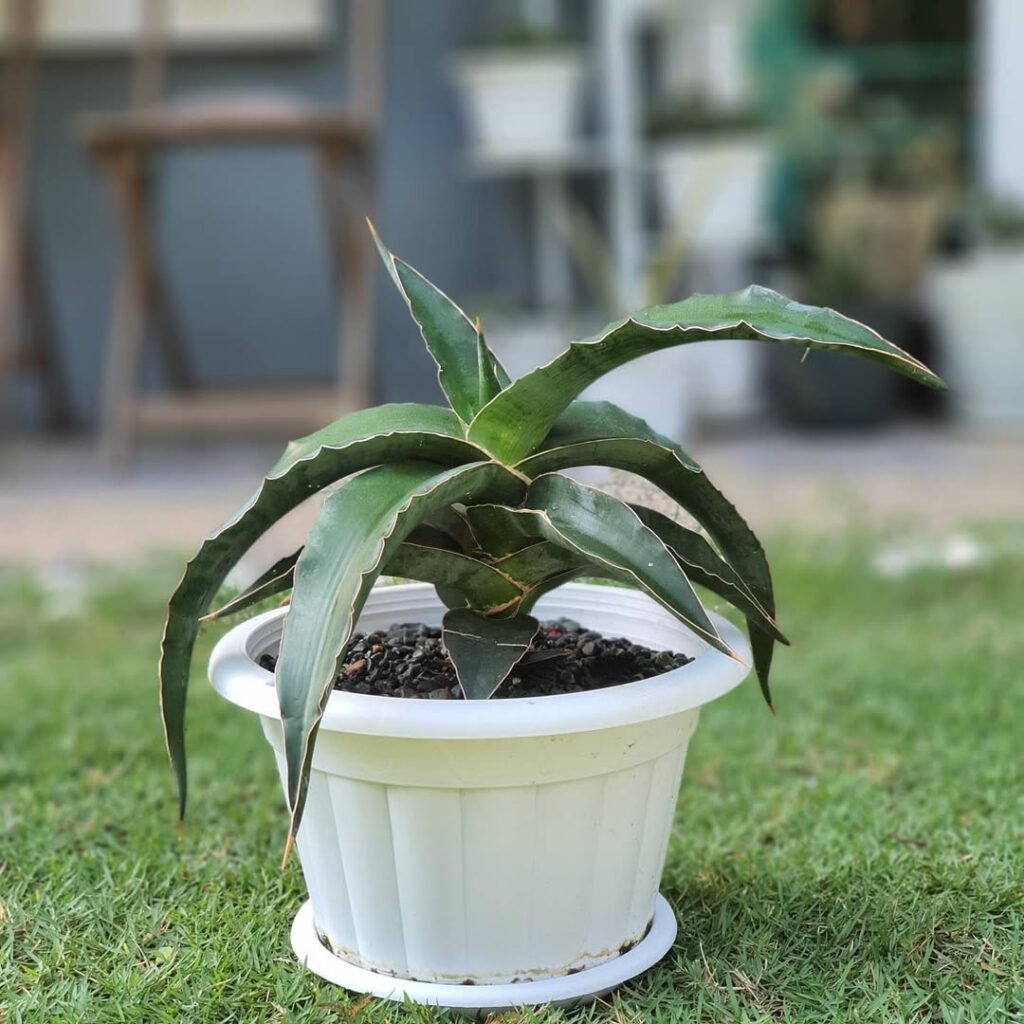
Sansevieria powysii, now classified as Dracaena powysii, is a rare, caulescent succulent native to Kenya, particularly Kiwaiyu Island. It is distinguished by its thick, upright leaves, which are dark green with faint mottled markings and have reddish-brown margins. The foliage grows in a spiral arrangement, forming a dense, structured appearance.
This species thrives in dry, rocky environments, developing strong underground rhizomes for drought resistance. It produces greenish-white flowers on large panicle-like inflorescences, making it visually distinct from other Sansevieria species.
Sansevieria raffillii
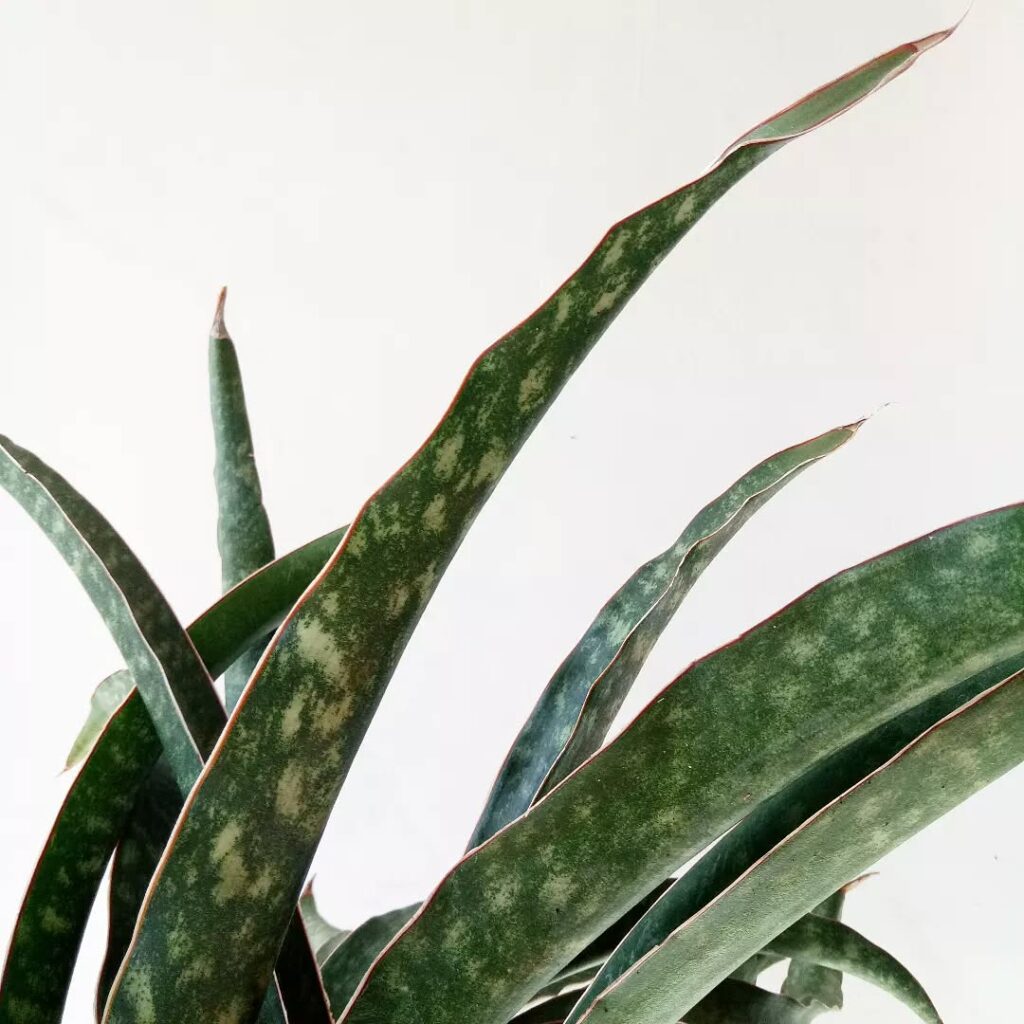
Native to Kenya and Somalia, Sansevieria raffillii is a tall, upright variety that can reach up to 4 feet 11 inches in height. Its smooth, lanceolate leaves emerge with green and yellow spots or banding near the base, though this pattern may fade over time. The reddish-brown calloused margins provide an attractive contrast, giving the plant a distinctive look.
When flowering, S. raffillii produces greenish-white inflorescences in the form of panicle clusters standing between 2 feet 11 inches and 3 feet 11 inches tall. It prefers shady areas away from direct sun, making it well-suited for filtered light indoors. Water sparingly, ensuring the soil dries out somewhat between waterings. A loose, well-draining sandy potting mix helps maintain its health, with ideal temperatures ranging from 68-77°F.
Sansevieria raffillii var. glauca
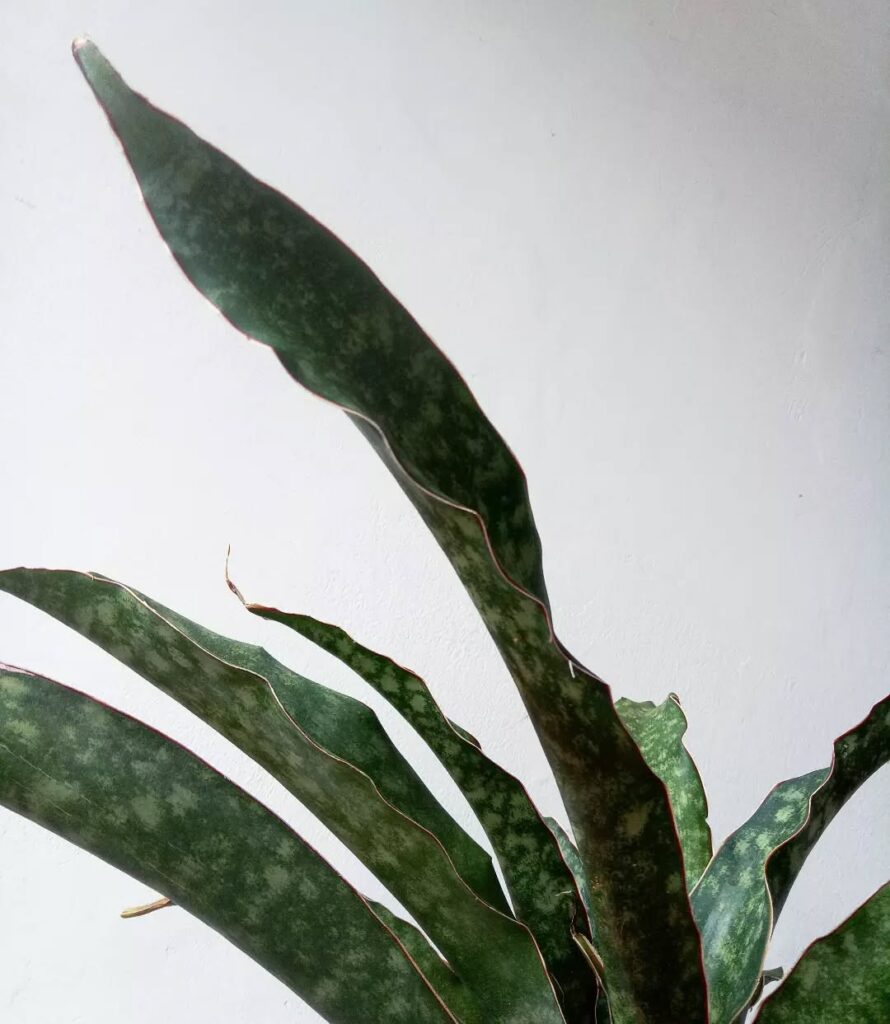
Compared to the type species, Dracaena raffillii, the var. glauca form exhibits more pronounced bluish-green coloration.
Sansevieria robusta
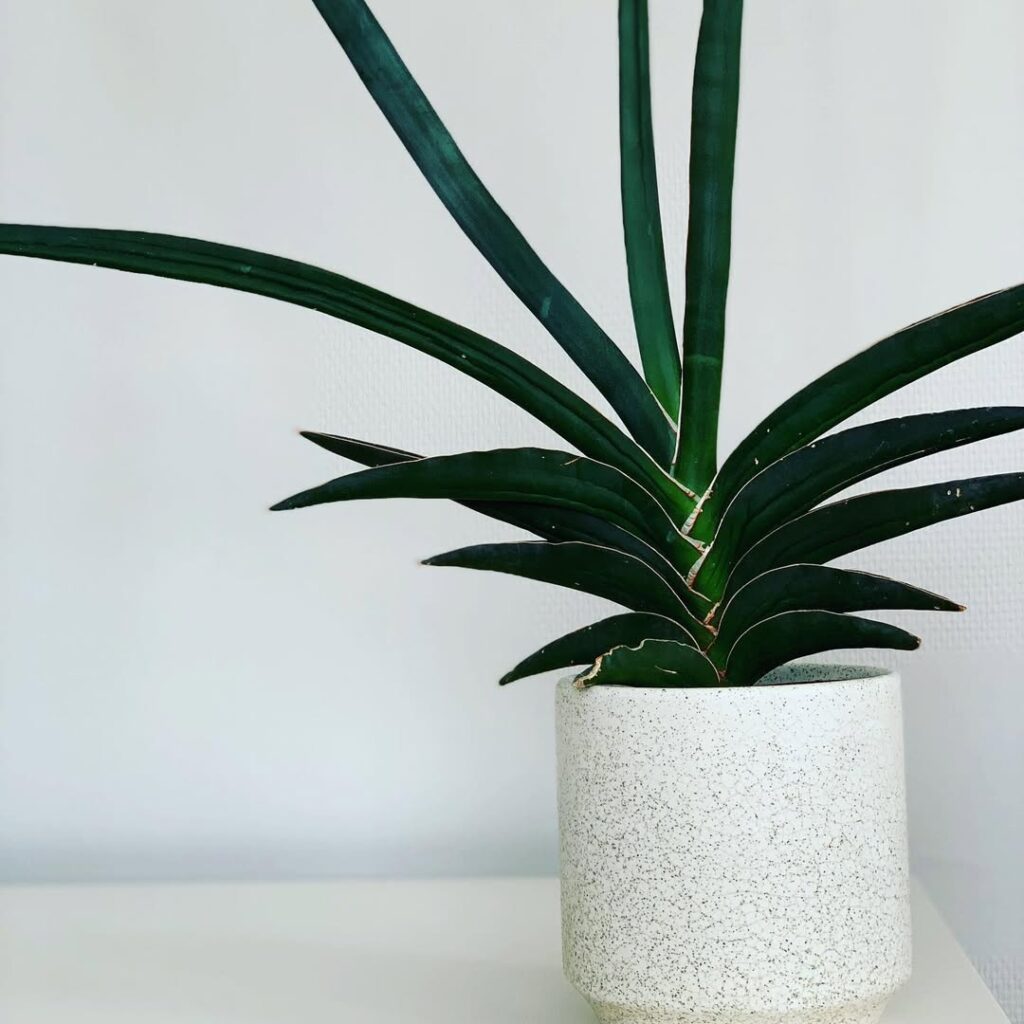
Sansevieria robusta, now classified as Dracaena robusta, is a robust, slow-growing succulent with thick, sword-like leaves arranged in an upright, loosely clustered rosette. The foliage is deep green with faint silvery striations, occasionally displaying subtle mottling depending on growing conditions. Leaf margins are smooth and slightly reddish-brown, while leaf tips taper to a sharp point, contributing to its striking architectural presence.
Sansevieria rorida
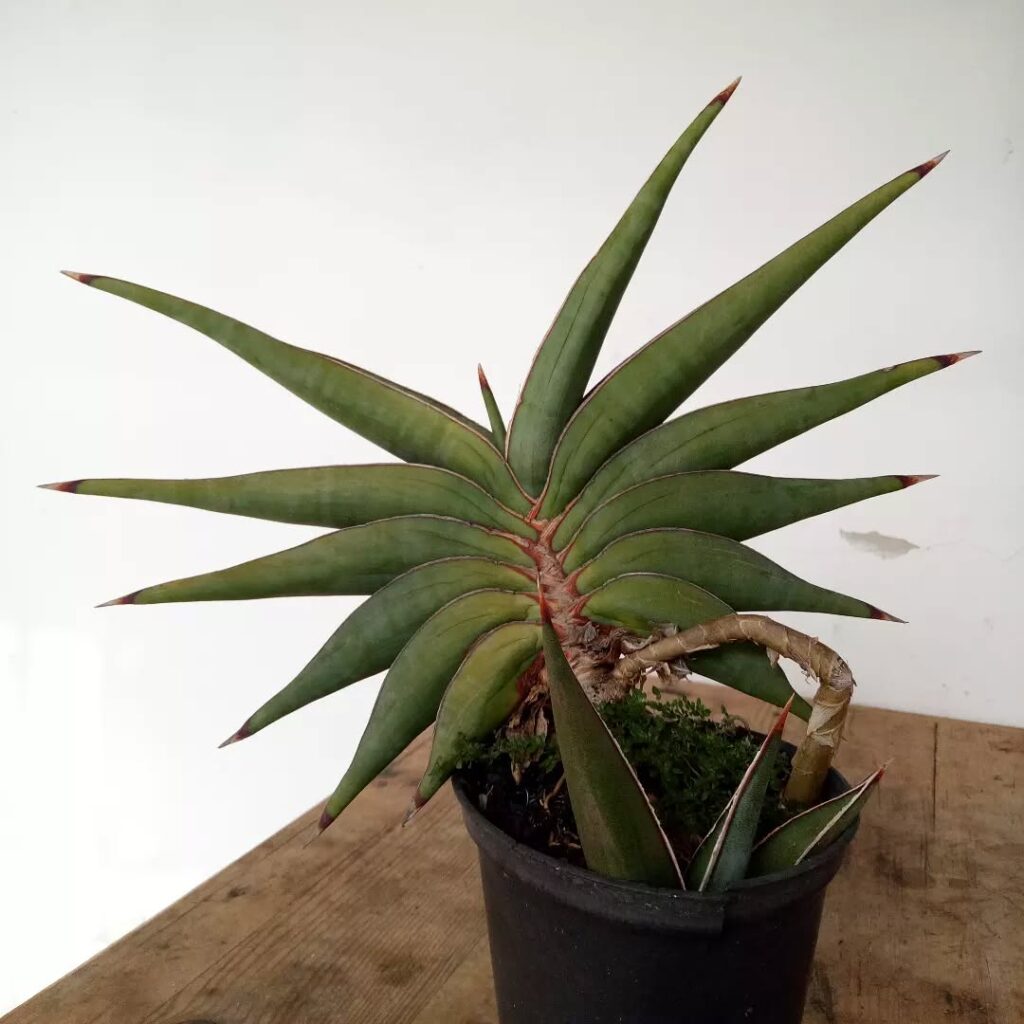
Sansevieria rorida, now classified as Dracaena hanningtonii, is a rare, stem-forming succulent native to northeastern and eastern tropical Africa, including Djibouti, Eritrea, Ethiopia, Kenya, Somalia, Sudan, and Tanzania, as well as the Arabian Peninsula. It is commonly known as Blue Sansevieria, Sword Sansevieria, or East African Wild Sisal, admired for its rigid, upright leaves that grow in two opposite rows, forming a sparse fan shape.
The foliage is dark green, with a grooved channel on the inner side, and can reach up to 5 feet in length. Unlike most Sansevieria species, Dracaena hanningtonii develops a short stem, making it distinct from stemless species like D. patens or D. pearsonii. It offsets via rhizomes, forming tight, dense clusters over time.
Sansevieria roxburghiana
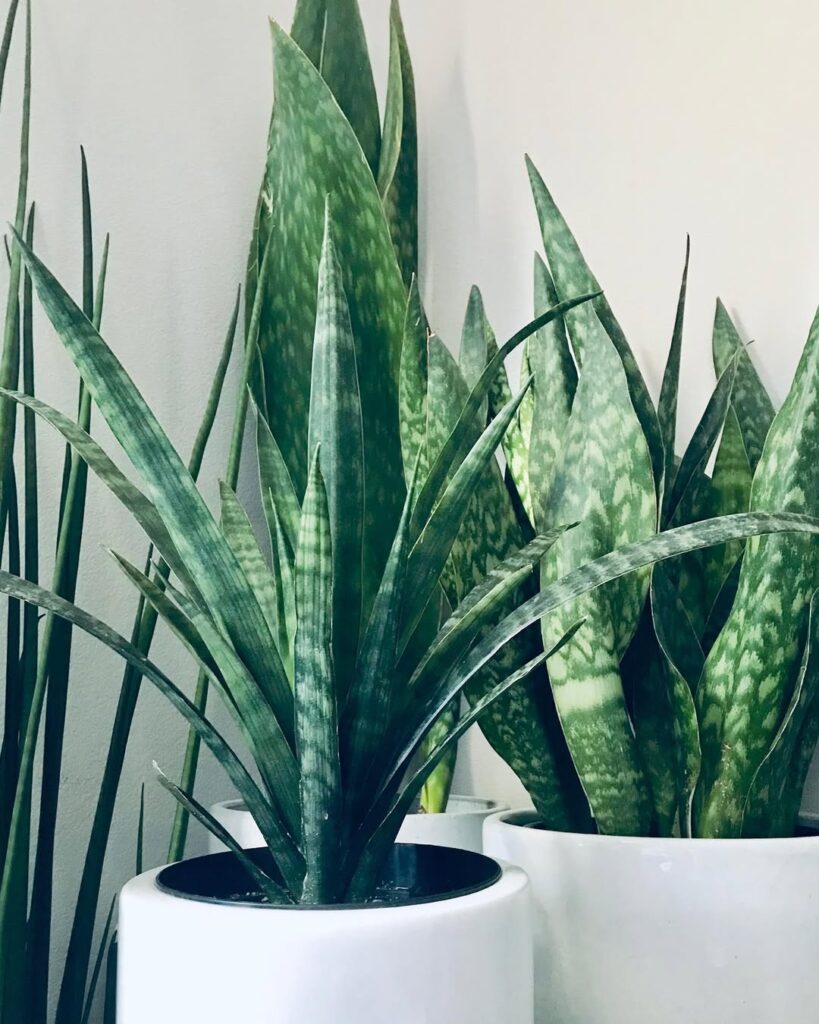
Sansevieria roxburghiana, now classified as Dracaena roxburghiana, is a stemless, evergreen succulent native to India and Sri Lanka. It is commonly known as Indian Bowstring Hemp due to its fibrous leaves, which have historically been used for making bowstrings and ropes.
The plant features long, sword-shaped leaves with dark green coloration and transverse lighter bands, creating a striped effect. The foliage is deeply concave, with smooth margins that become whitish with age.
Sansevieria sambiranensis
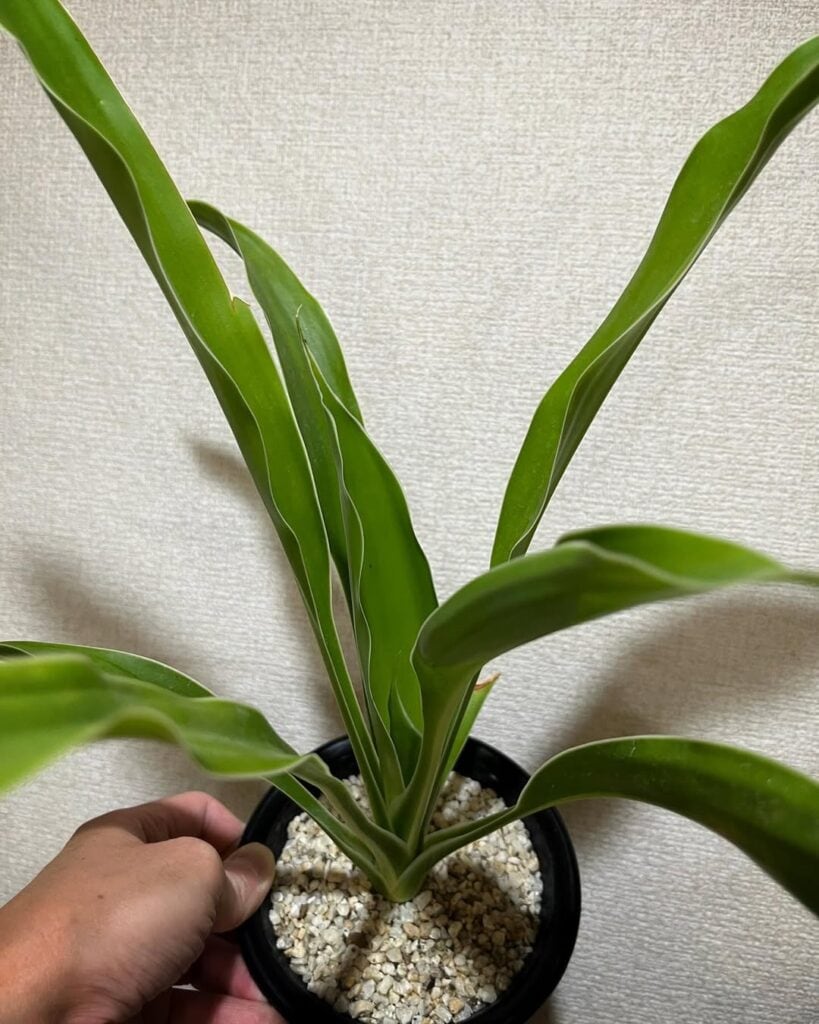
Sansevieria sambiranensis, now classified as Dracaena sambiranensis, is a rare, stemless succulent native to Madagascar. It is distinguished by its soft, floppy leaves with white margins, giving it a delicate, tropical appearance. Unlike most Sansevieria species, it produces red flowers in summer, making it one of the few red-flowering varieties.
Sansevieria scimitariformis
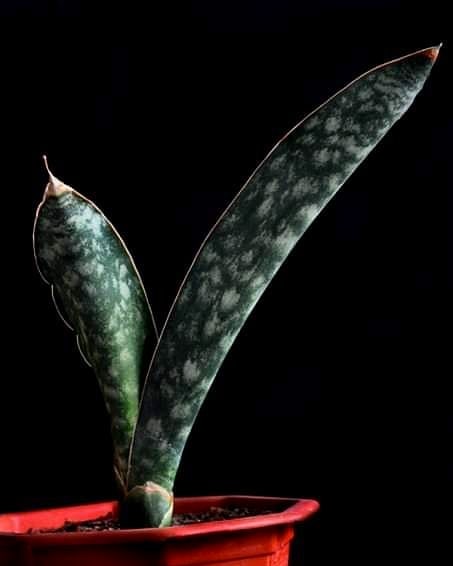
Sansevieria scimitariformis, now classified as Dracaena scimitariformis, is a rare, stemless succulent native to Somalia. It is distinguished by its long, sword-like leaves that grow in a rosette pattern, with a slightly curved shape resembling a scimitar. The foliage is dark green with lighter mottled markings, and the leaf margins are smooth and slightly reddish-brown.
Sansevieria senegambica
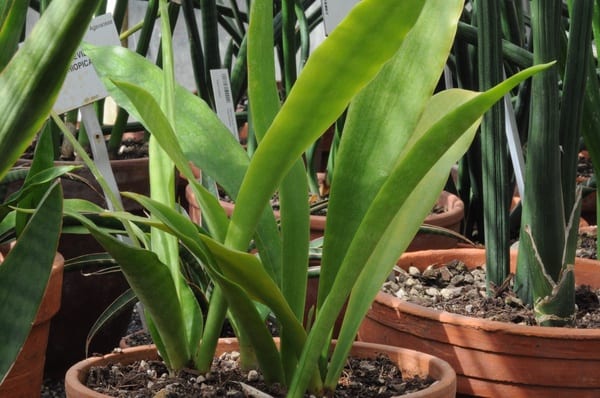
A native of West Africa, Sansevieria senegambica develops a rosette shape with up to four loosely arching, dark green leaves tapering to a fine point. The leaf tops feature subtle horizontal bands, while the undersides display more pronounced banding in a lighter green shade. The leaves extend between 1 foot 4 inches and 2 feet 4 inches long, bordered by green margins.
Its white panicle flower clusters emerge on stems between 1 foot and 1 foot 8 inches tall, often carrying a purplish flush when exposed to sunlight. Like most Sansevieria varieties, it thrives in bright, indirect light or filtered shade. Water sparingly, using a loose, fast-draining potting mix to avoid excess moisture buildup. Keeping temperatures around 68°F ensures healthy growth.
Sansevieria sinus simiorum
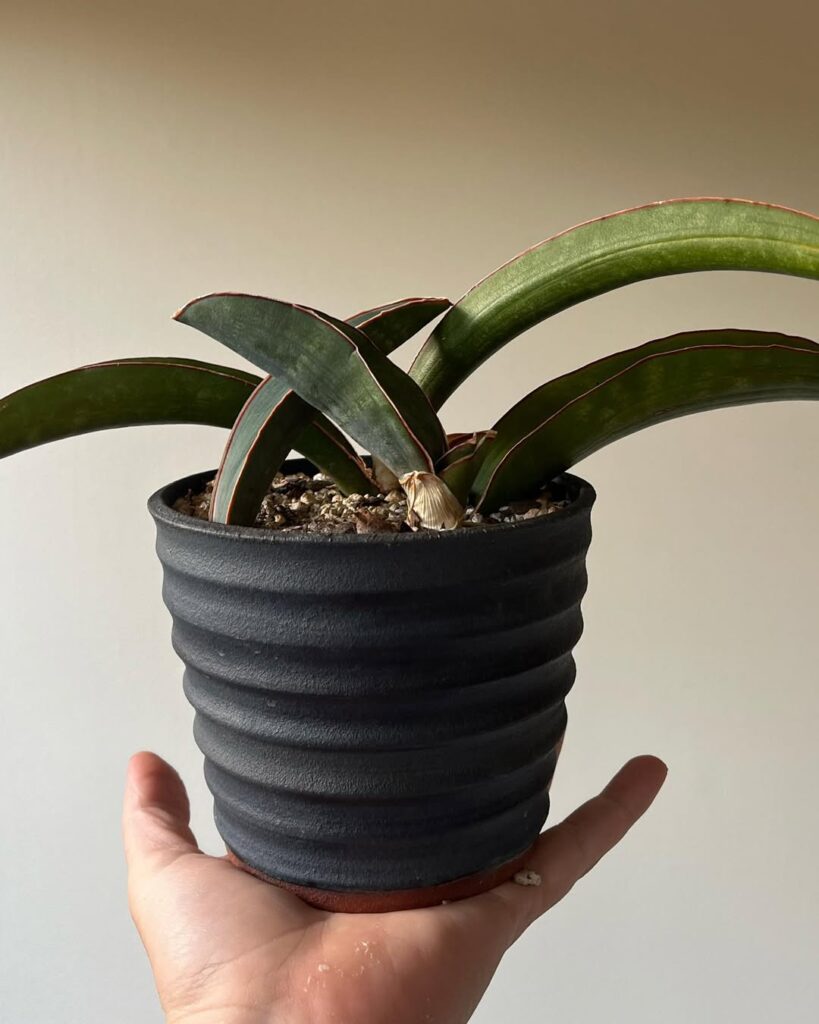
Sansevieria sinus simiorum, now classified as Dracaena sinus simiorum, is a rare, cylindrical-leaved succulent native to Malawi, particularly near Monkey Bay. It is commonly known as Malawi Bat or Super Bat, due to its thick, spear-like leaves with a massive “D” section, making it one of the largest of the “bat” Sansevierias.
The juvenile form features shorter, more compact leaves with less pronounced longitudinal grooves compared to mature specimens. As it grows, the foliage becomes longer, more recurved, and develops impressed black-green lines running along the leaf surface. Unlike other “bat” Sansevierias, its edges are less sharp, except at the leaf tip.
Sansevieria stuckyi

Sansevieria stuckyi, now classified as Dracaena stuckyi, is a tall, cylindrical-leaved succulent native to Mozambique, Tanzania, and southern Kenya. It is commonly known as Elephant Tusk Sansevieria due to its rigid, upright leaves, which can grow up to 7 feet in height. The foliage is dark green with faint pale marbling, featuring a shallow groove on the inner side.
Sansevieria subspicata

Originating from Mozambique, S. subspicata features arching, lanceolate leaves with a green to slightly blue tint, growing between 8-24 inches (up to 2 feet) long. The foliage bends gently backward from an upright habit, with green margins that age to white over time, adding a striking contrast.
When in bloom, greenish-white panicle flowers emerge on 12-16 inch spikes (up to 1 foot 4 inches tall). This variety thrives in sun to partial shade, requiring the soil to dry completely between waterings to prevent excess moisture buildup. A slightly sandy, loose, well-draining mix works best, and maintaining temperatures between 68-77°F ensures optimal growth.
Sansevieria ‘Sudwala Caves’
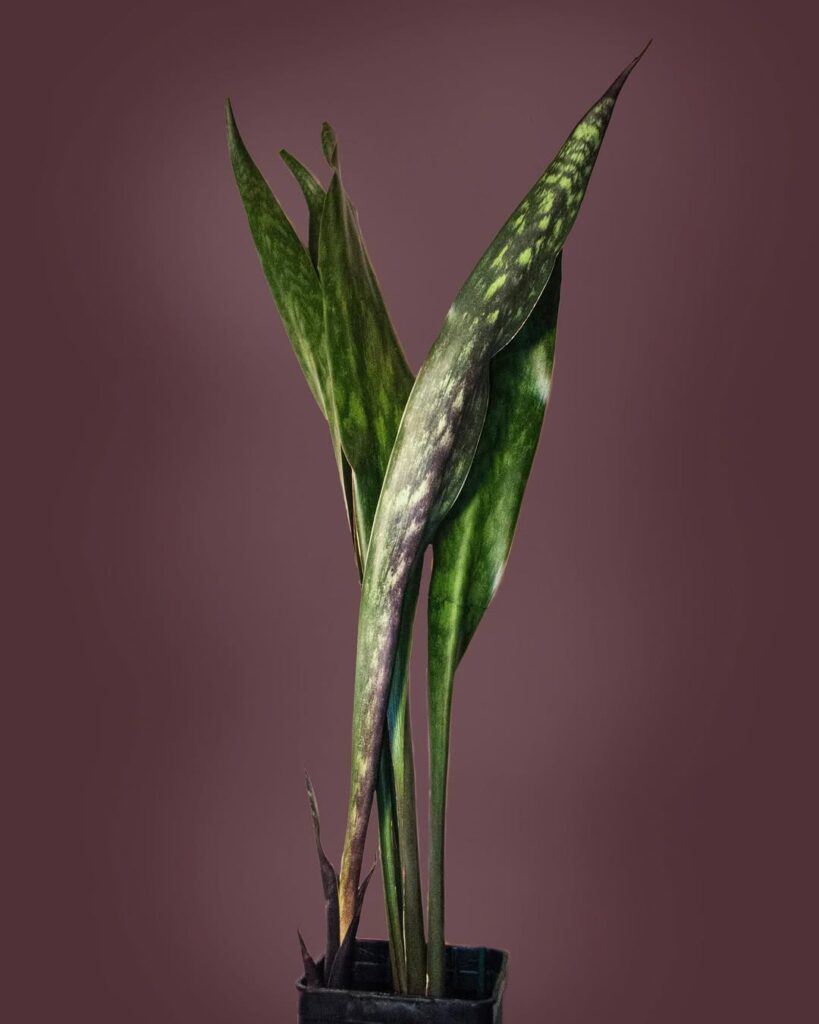
Sansevieria ‘Sudwala Caves’ is a rare, variegated cultivar admired for its compact, upright growth and striking foliage patterns. The leaves are thick, sword-like, and dark green, often featuring creamy-yellow variegation along the edges. This cultivar is highly sought after for its structured, elegant form, making it a favorite among collectors.
Sansevieria suffruticosa

Sansevieria suffruticosa, now classified as Dracaena suffruticosa, is a stem-forming succulent native to eastern Africa, ranging from Ethiopia to Malawi. It features thick, spine-tipped leaves that grow in rosettes or spiral distichous arrangements, creating a structured, architectural form. The foliage is elliptical in cross-section, rather than fully cylindrical, and varies from pale to dark green, depending on sun exposure.
Sansevieria suffruticosa ‘Blue Clone’
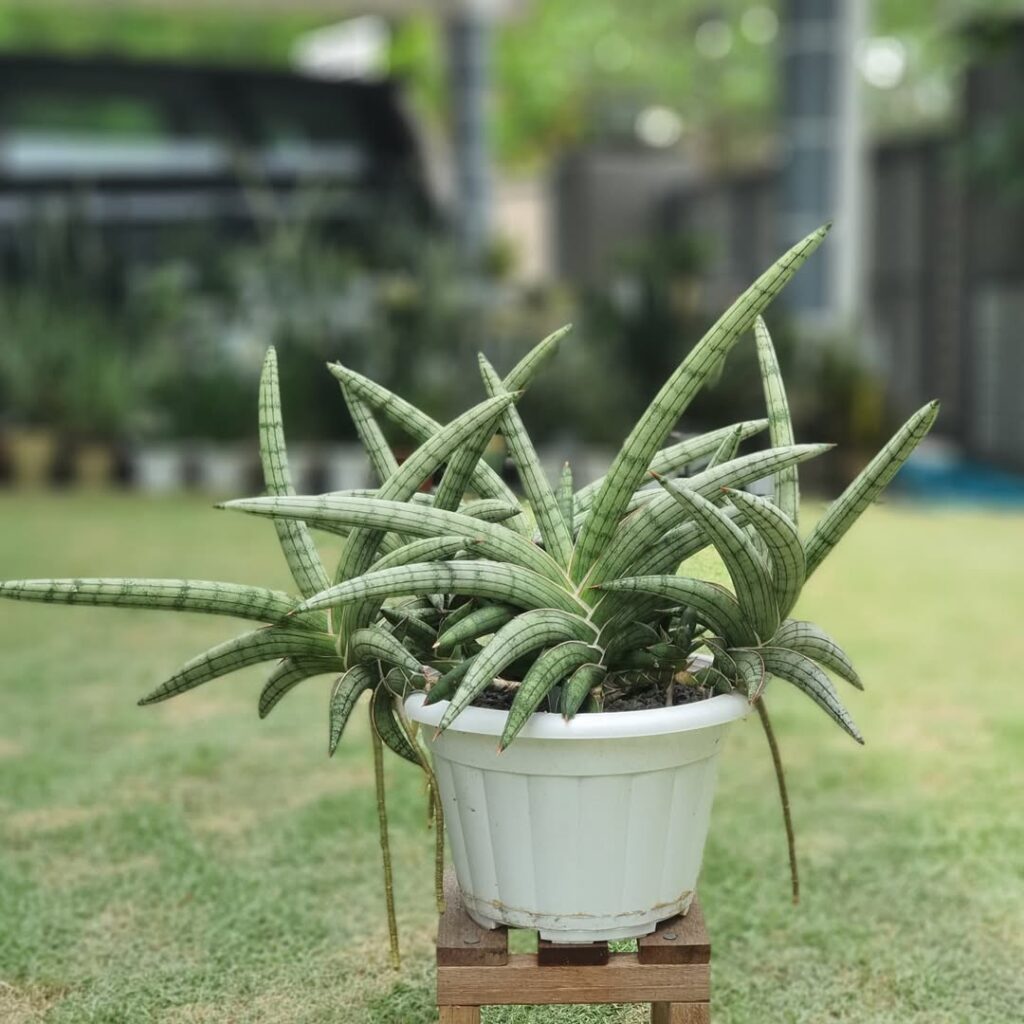
Sansevieria suffruticosa ‘Blue Clone,’ now classified as Dracaena suffruticosa ‘Blue Clone,’ is a rare, cylindrical-leaved cultivar admired for its bluish-green foliage and compact, upright growth. It features long, slender, pointed leaves that radiate in a rosette pattern, creating a structured, architectural form. The bluish tint is more pronounced compared to the standard Dracaena suffruticosa, making it a sought-after collector’s plant.
Sansevieria suffruticosa ‘Frosty Spears’
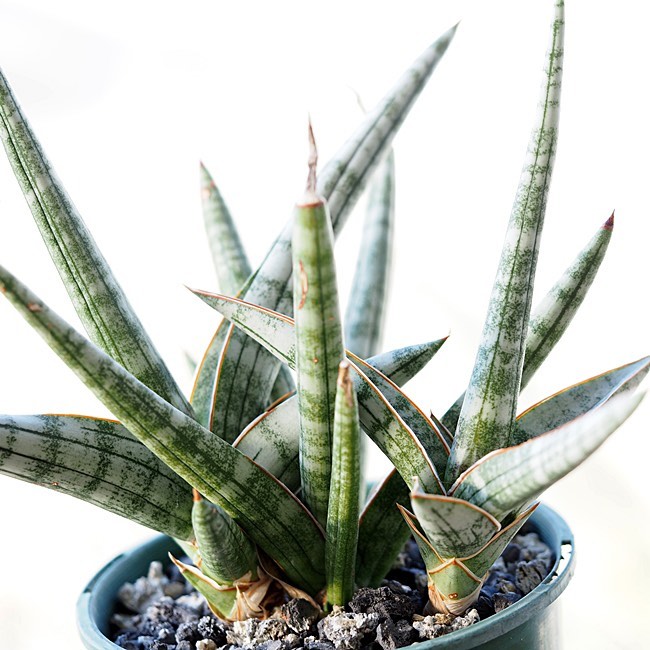
Sansevieria suffruticosa ‘Frosty Spears,’ now classified as Dracaena suffruticosa ‘Frosty Spears,’ is a rare, slow-growing succulent admired for its silvery-white juvenile leaves that gradually darken to pale blue-green with horizontal banding. The foliage is stiff, cylindrical, and sharply pointed, forming open rosettes that expand via aerial stolons.
Sansevieria thyrsiflora
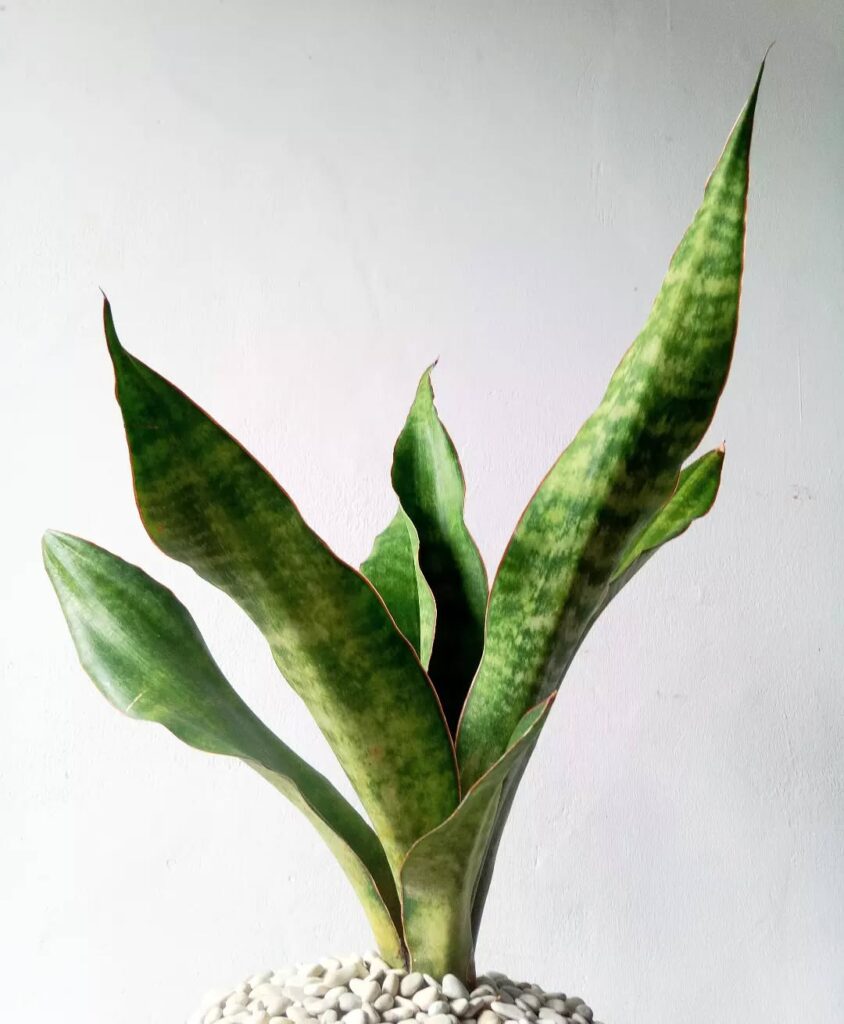
Sansevieria thyrsiflora, now classified as Dracaena hyacinthoides, is a stemless, evergreen succulent native to southern Africa. It is commonly known as Mother-in-Law’s Tongue or Sword Sansevieria, admired for its tall, upright leaves that grow in a fan-like arrangement. The foliage is dark green with vertical white banding, creating a striking contrast. Mature plants can reach up to 5 feet (1.5 meters) in height and produce greenish-white flowers on tall inflorescences.
Sansevieria trifasciata
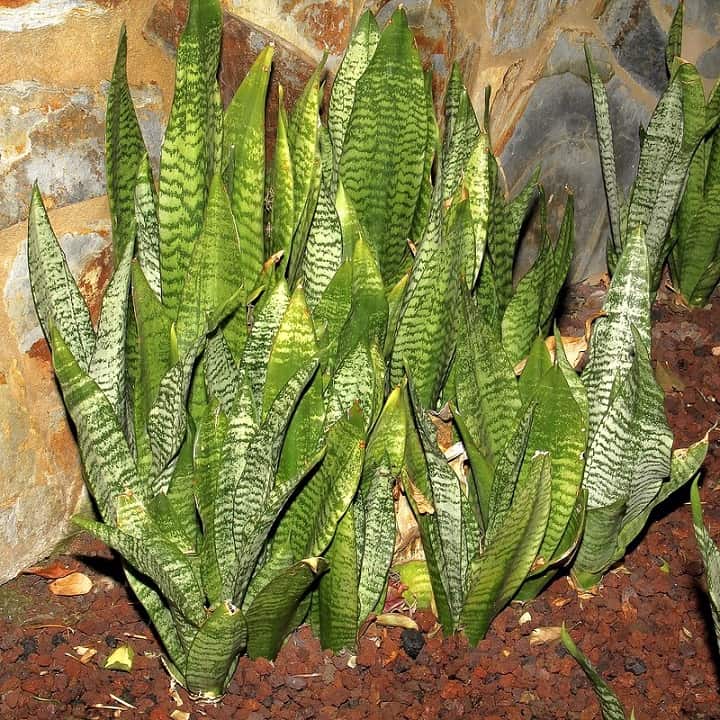
Perhaps the most recognized of all Sansevieria, S. trifasciata is native to tropical West Africa and commonly known as snake plant or mother-in-law’s tongue. Its thick, linear-lanceolate leaves, adorned with horizontal banding, grow between 16-24 inches (up to 2 feet) tall from creeping rhizomes.
To maintain its striking appearance, provide bright, indirect light and let the soil dry between waterings. A loamy, well-draining mix with sandy amendments works best, along with seasonal fertilization from spring to fall.
Sansevieria trifasciata ‘Abrorian Sword’
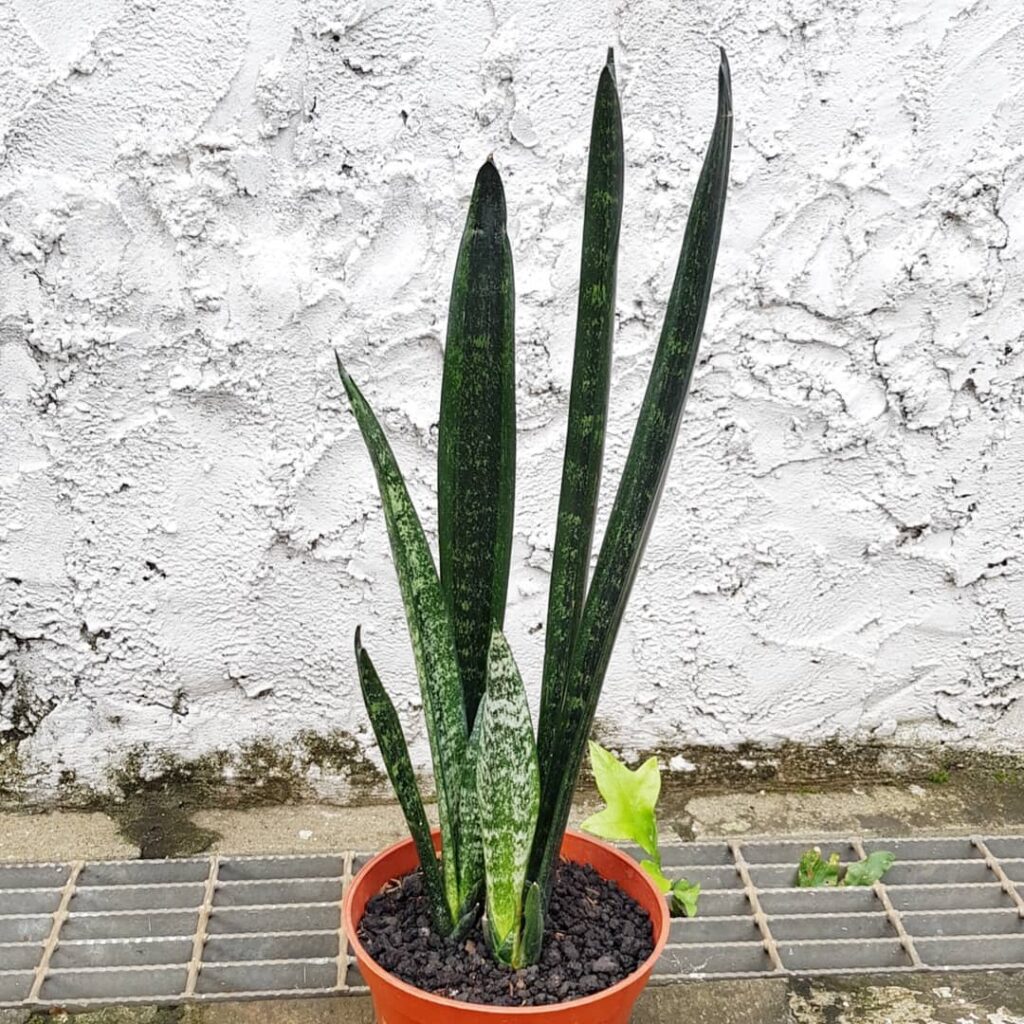
Sansevieria trifasciata ‘Abrorian Sword,’ also known as ‘Mein Liebling,’ is a unique cultivar distinguished by its dual naming—one of which appears to be German for “my dear.” This variety exhibits dynamic foliage changes, with young leaves displaying white markings that gradually fade as they mature. At full growth, the leaves take on a dark green center, flanked by lighter green edges, creating a subtle contrast.
Sansevieria trifasciata ‘Black Gold’
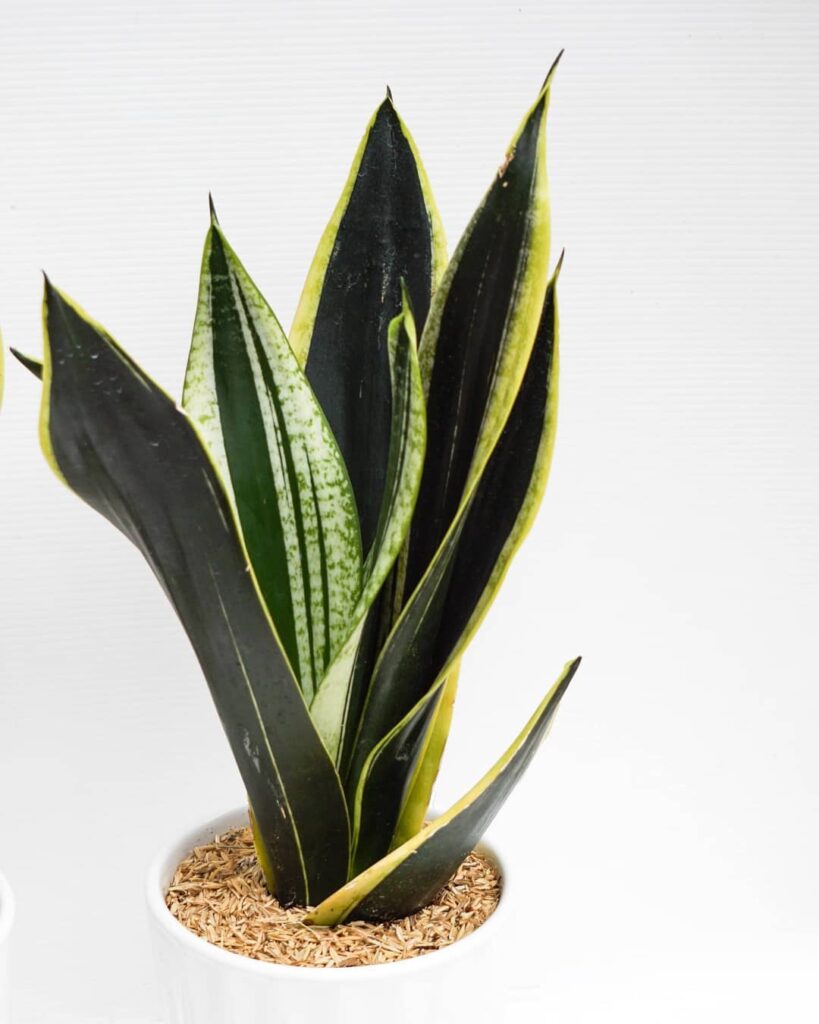
Sansevieria trifasciata ‘Black Gold’ is a striking snake plant cultivar known for its deep green, sword-like leaves edged with bold golden-yellow margins. This contrast creates a dramatic, sculptural appearance, making it a standout among Sansevieria varieties. The foliage grows upright and rigid, reaching up to 3 feet tall, forming a structured, architectural presence.
Sansevieria trifasciata ‘Brazilian Moonshine’
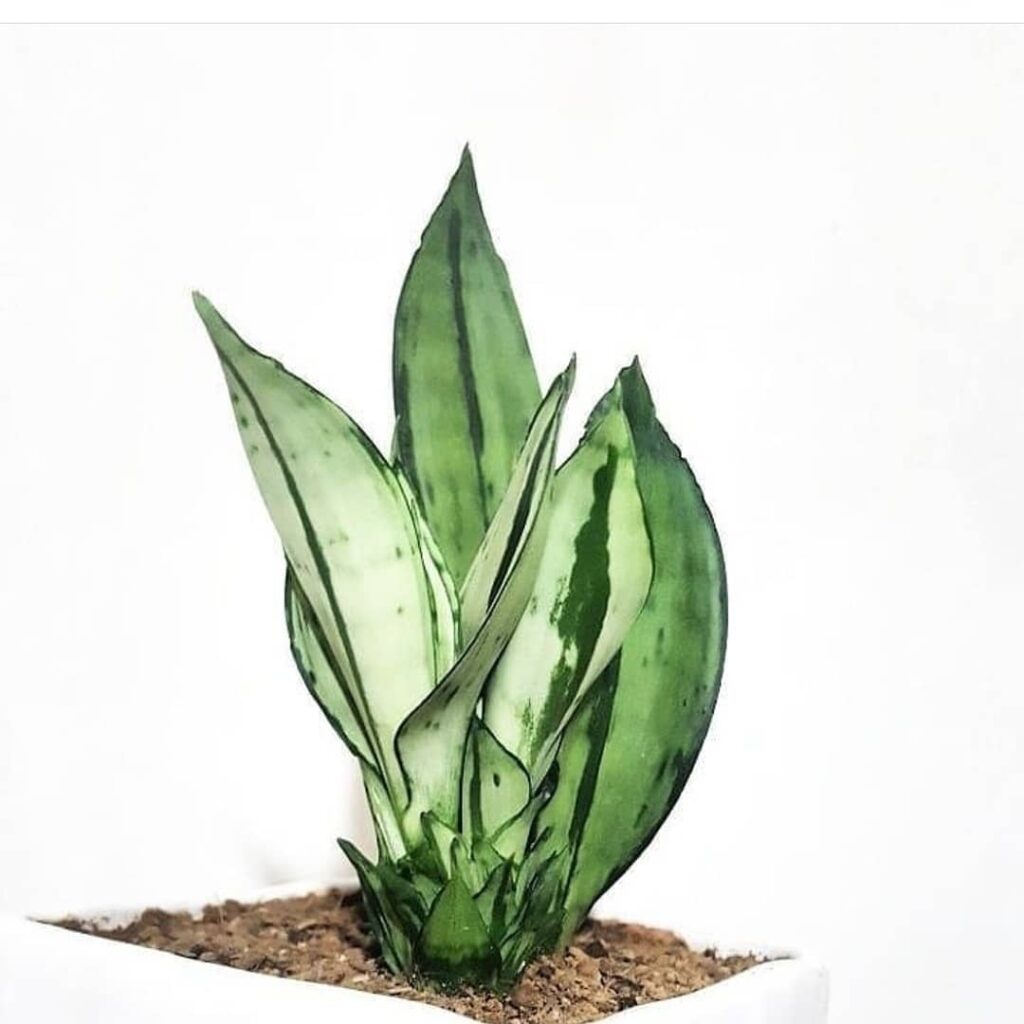
Sansevieria trifasciata ‘Brazilian Moonshine’ is a striking snake plant cultivar known for its broad, upright leaves with a silvery-green hue. The foliage has a smooth texture and pointed tips, creating a sleek, modern aesthetic. Unlike standard Sansevieria trifasciata, this variety features lighter, muted tones, making it a standout among snake plants.
Sansevieria trifasciata ‘Craigii’
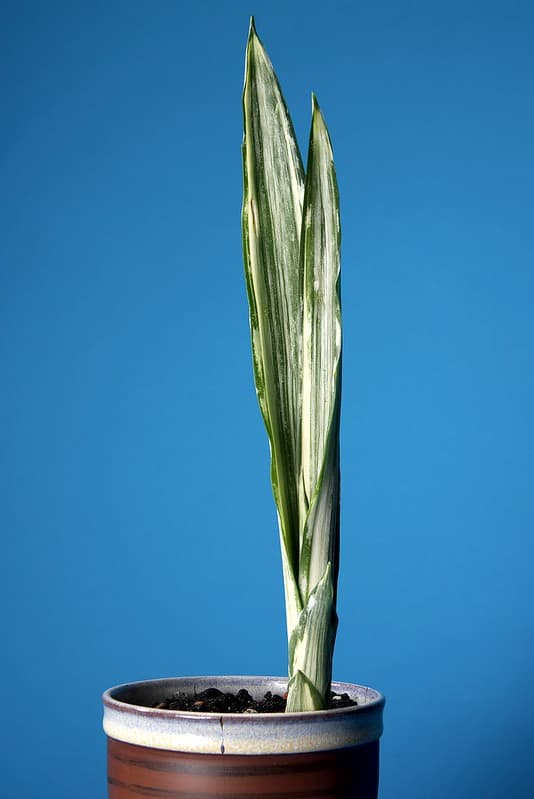
‘Craigii’ is a resilient, upright-growing cultivar with variegated foliage that thrives in indoor conditions. Its bold green leaves feature lighter horizontal banding, creating a textured appearance. Like other snake plants, it prefers bright, indirect light but can tolerate lower light levels.
Sansevieria trifasciata ‘Nelsoni’
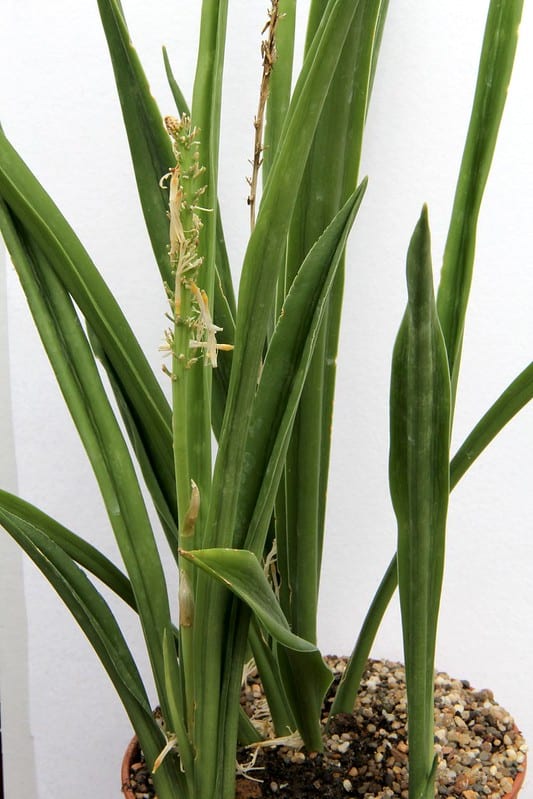
‘Nelsoni’ is a shorter, more compact cultivar, with thick, dark green leaves arranged in a tight rosette. Its dense growth habit makes it ideal for small spaces, offering the same low-maintenance care as taller varieties.
Sansevieria trifasciata ‘Midnight Shine’
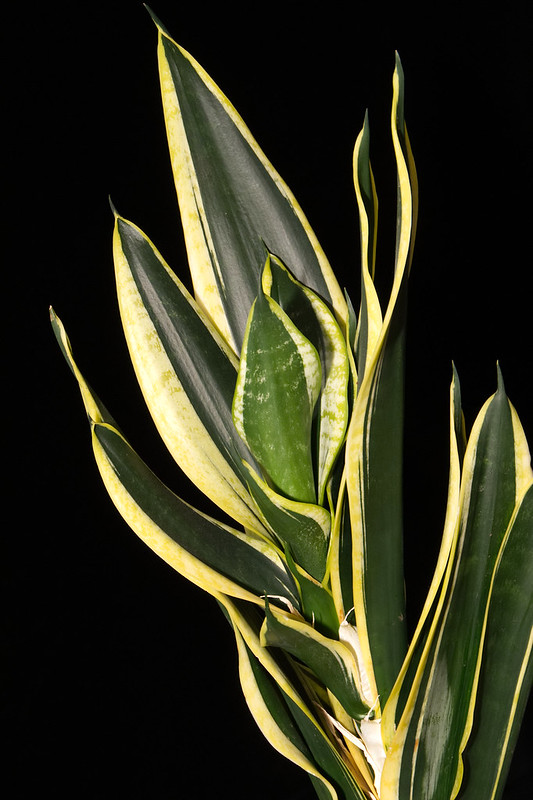
Sansevieria trifasciata ‘Midnight Shine’ is a rare cultivar of the classic Snake Plant, known for its deep, glossy green leaves that appear almost black under certain lighting conditions. The foliage is broad, upright, and sword-like, growing in a tight rosette formation.
Sansevieria trifasciata ‘Manolin’
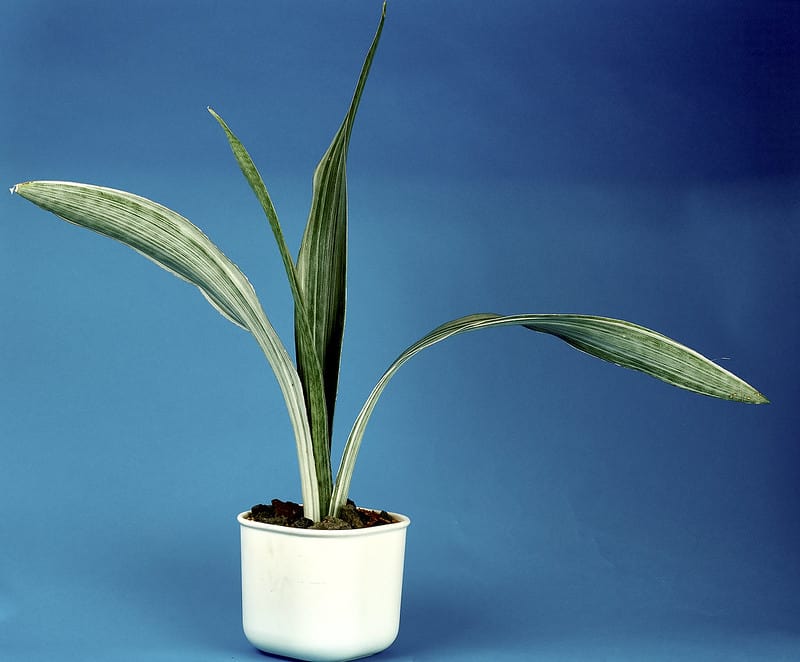
Sansevieria trifasciata ‘Manolin’ is a compact, variegated cultivar of the classic Snake Plant, admired for its thin, upright leaves with distinctive white vertical striping. Unlike broader-leaved varieties, ‘Manolin’ has a slender, refined appearance, making it an excellent choice for small spaces or decorative arrangements.
Sansevieria trifasciata ‘Futura Simplex’
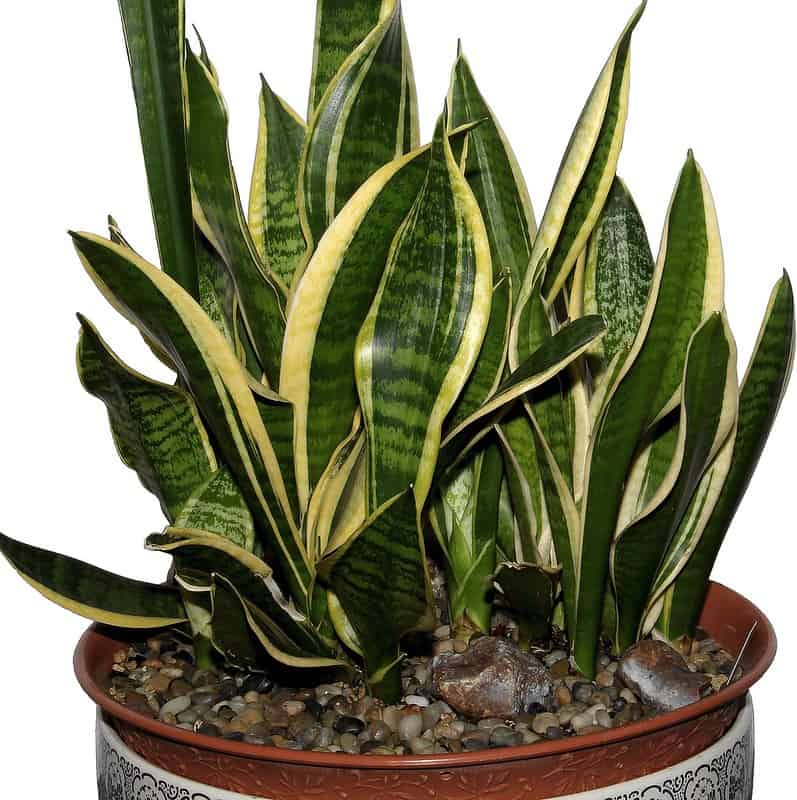
Sansevieria trifasciata ‘Futura Simplex’ is a compact, variegated cultivar of the classic Snake Plant, admired for its broad, upright leaves with green marbling and yellow margins. It combines traits of Sansevieria trifasciata ‘Laurentii’ and Sansevieria trifasciata ‘Golden Hahnii’, making it a versatile ornamental with a structured yet open growth habit.
Sansevieria trifasciata ‘Moonshine’
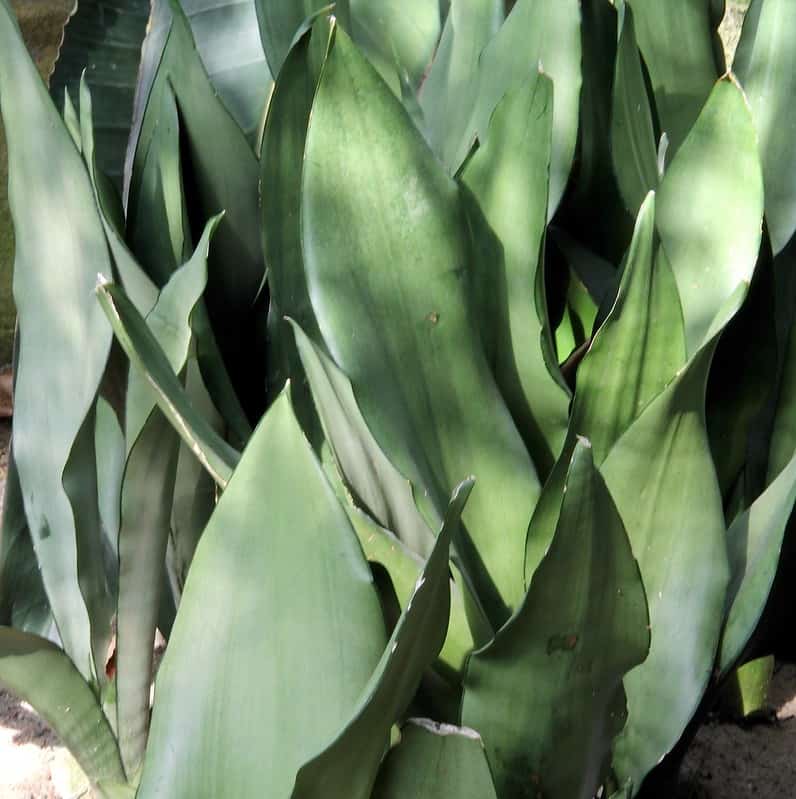
Sansevieria trifasciata ‘Moonshine,’ now classified as Dracaena trifasciata ‘Moonshine,’ is a striking, silvery-green cultivar of the classic Snake Plant. It is admired for its broad, upright leaves with a smooth, matte finish, giving it a moonlit glow—hence the name. Unlike other variegated Sansevieria trifasciata cultivars, ‘Moonshine’ lacks prominent yellow margins, creating a sleek, uniform appearance.
Sansevieria trifasciata ‘Hahnii Jade Pagoda’
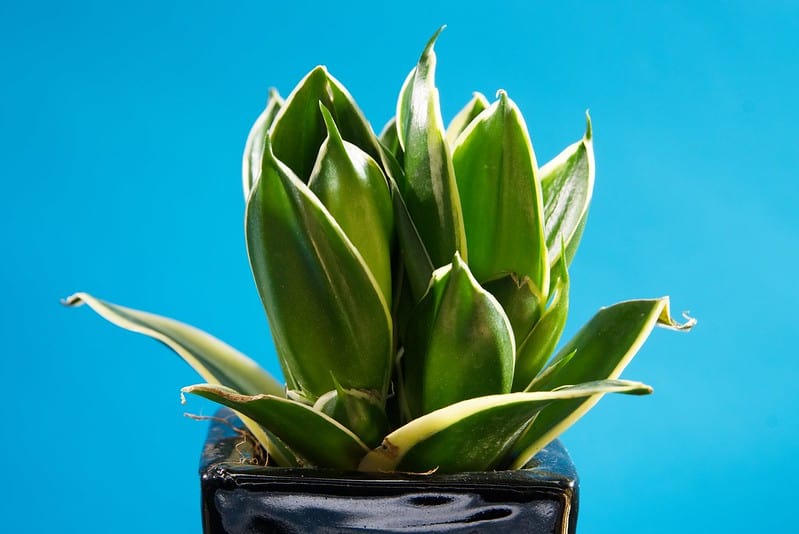
Sansevieria trifasciata ‘Hahnii Jade Pagoda’ is a compact, variegated cultivar of the Bird’s Nest Snake Plant, admired for its dark glossy leaves with bright yellow margins. The foliage forms a tight rosette, creating a sculptural, structured appearance. This variety is a dwarf hybrid, reaching only 8–10 inches in height, making it ideal for tabletop displays and small spaces.
Sansevieria trifasciata ‘Hahnii Green’
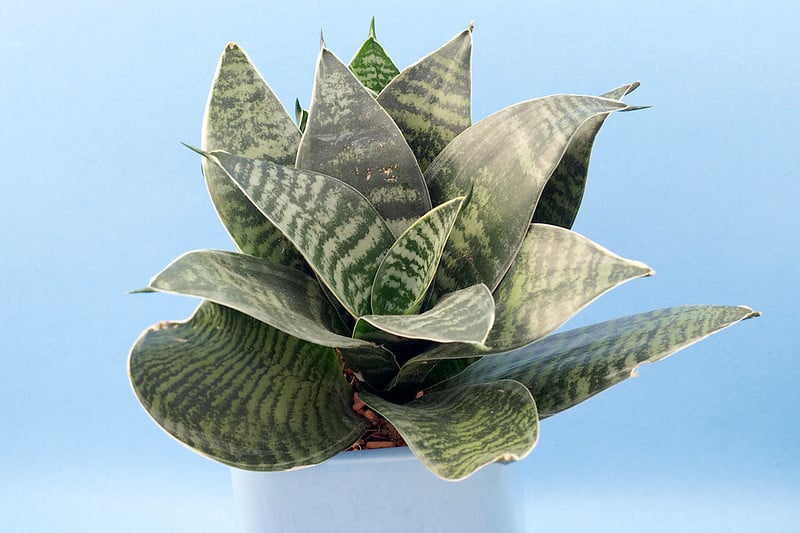
Sansevieria trifasciata ‘Hahnii Green’ is a compact, rosette-forming cultivar of the Bird’s Nest Snake Plant, admired for its deep green, glossy leaves with subtle horizontal striping. Unlike variegated Hahnii cultivars, ‘Hahnii Green’ lacks yellow margins, giving it a sleek, uniform appearance.
Sansevieria trifasciata ‘Golden Hahnii’
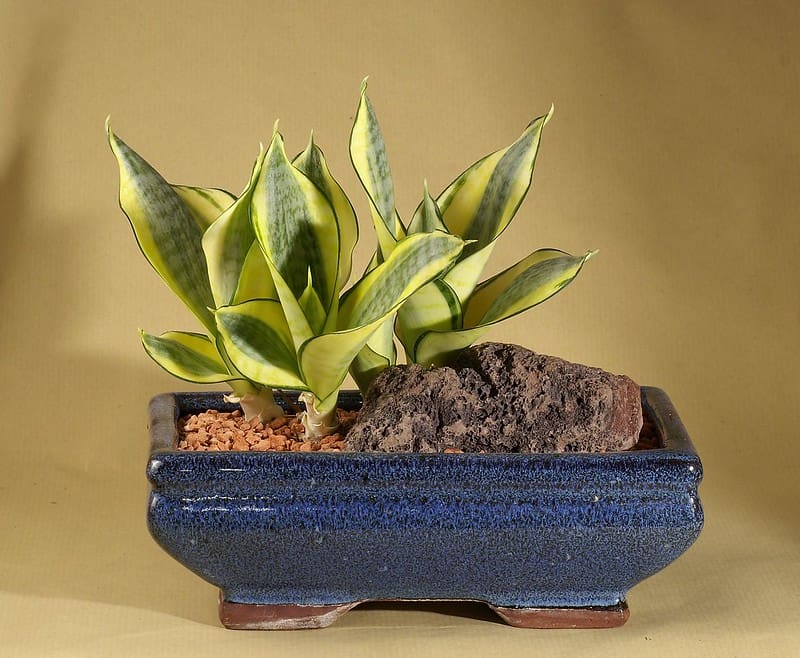
Sansevieria trifasciata ‘Golden Hahnii,’ now classified as Dracaena trifasciata ‘Golden Hahnii,’ is a compact, rosette-forming cultivar of the classic Snake Plant. It is admired for its broad, funnel-shaped leaves with golden-yellow margins that contrast beautifully against the deep green center. This variety is often called the Golden Bird’s Nest Sansevieria due to its low-growing, clustered form, making it ideal for tabletop displays and small spaces.
Sansevieria trifasciata ‘Silver Hahnii’
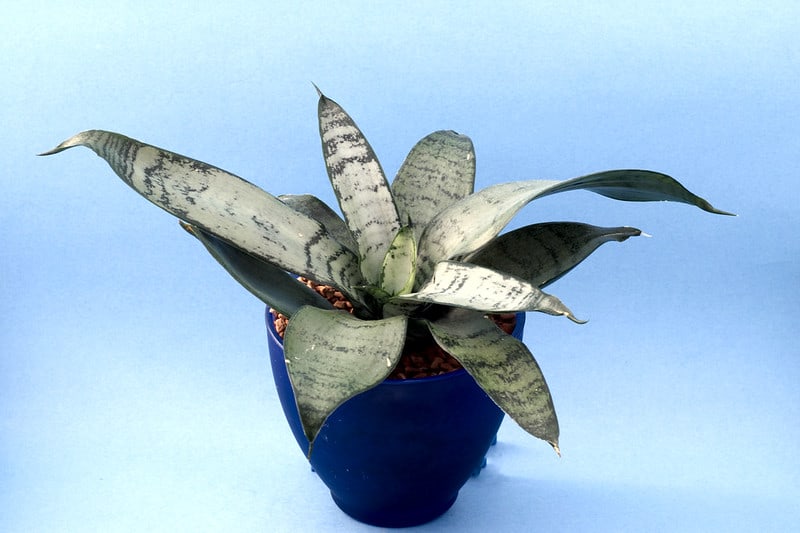
Sansevieria trifasciata ‘Silver Hahnii,’ now classified as Dracaena trifasciata ‘Silver Hahnii,’ is a compact, rosette-forming cultivar of the Bird’s Nest Snake Plant. It is admired for its silvery-green leaves with subtle horizontal striping, giving it a soft, frosted appearance. The foliage forms a tight, vase-like cluster, making it ideal for small spaces and decorative arrangements.
Sansevieria trifasciata ‘Gold Flame’
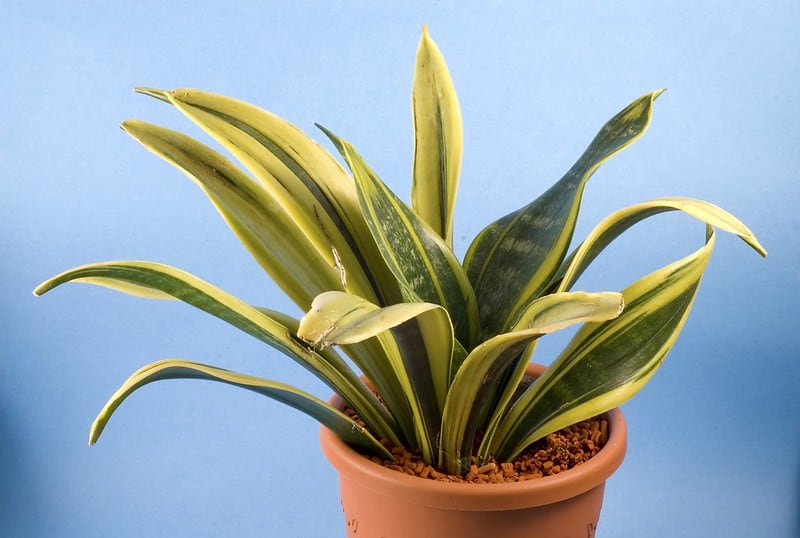
Sansevieria trifasciata ‘Gold Flame,’ now classified as Dracaena trifasciata ‘Gold Flame,’ is a striking, variegated cultivar admired for its broad, upright leaves with golden-yellow centers that gradually darken to deep green as they mature. This cultivar is prized for its dramatic color contrast, making it a standout among Snake Plants.
Sansevieria trifasciata ‘Laurentii’
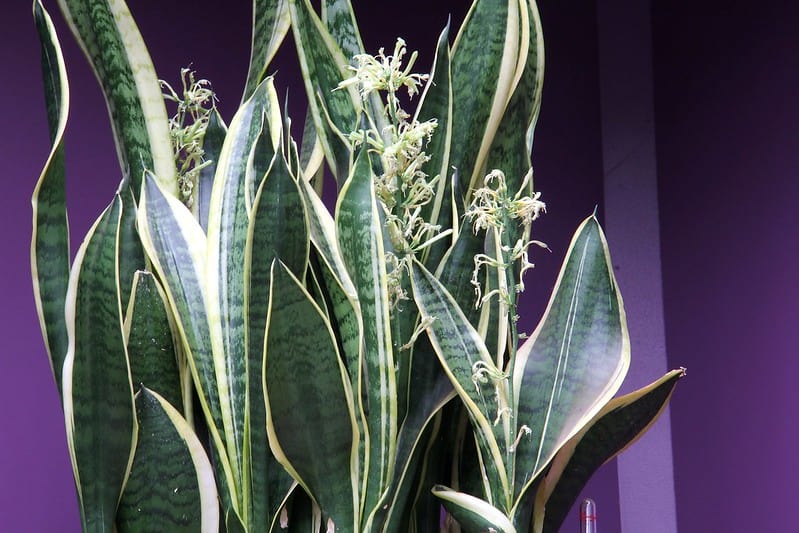
Sansevieria trifasciata ‘Laurentii,’ now classified as Dracaena trifasciata ‘Laurentii,’ is a classic variegated cultivar of the Snake Plant, admired for its tall, sword-like leaves with bold yellow margins and deep green centers. This variety is one of the most recognizable and widely cultivated Sansevieria types, prized for its architectural form and air-purifying qualities.
Sansevieria trifasciata ‘Laurentii Bird Beak’

Sansevieria trifasciata ‘Laurentii Bird Beak’ is a distinctive cultivar of the classic Laurentii snake plant, notable for its curled, twisting leaves that resemble a bird’s beak. The foliage retains the deep green center and bold yellow margins characteristic of ‘Laurentii,’ but with a unique curved growth pattern that sets it apart.
Sansevieria trifasciata ‘Bantel’s Sensation’
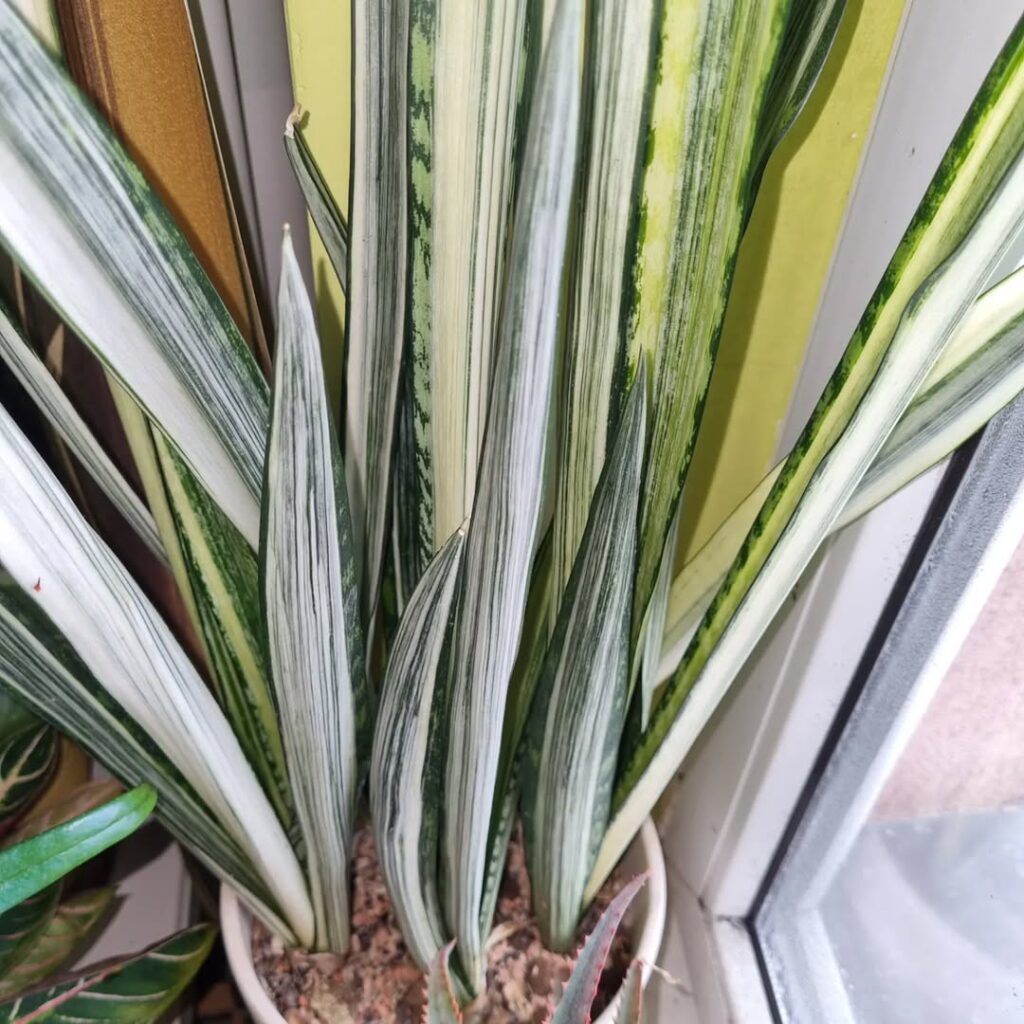
Sansevieria trifasciata ‘Bantel’s Sensation,’ now classified as Dracaena trifasciata ‘Bantel’s Sensation,’ is a rare, variegated cultivar admired for its tall, slender leaves with striking white vertical striping. This cultivar was developed by Gustav Bantel and patented in 1948, earning it the nickname White Sansevieria.
Sansevieria trifasciata ‘Whitney’
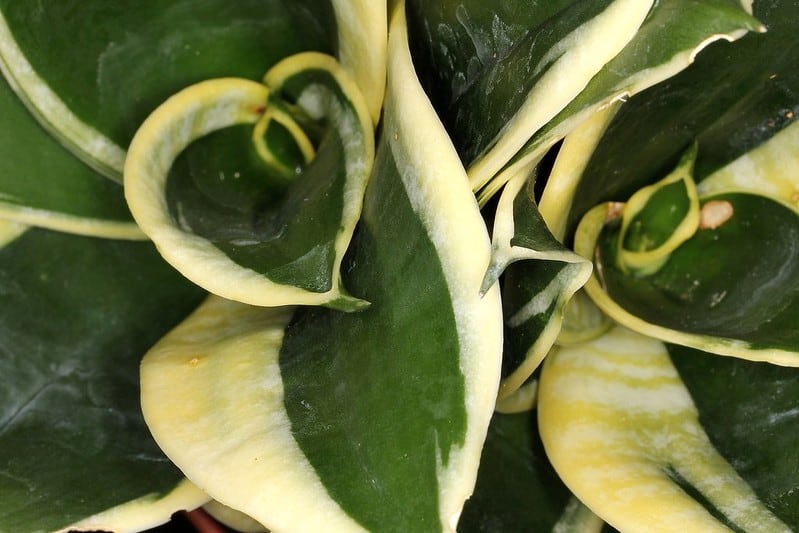
Sansevieria trifasciata ‘Whitney,’ now classified as Dracaena trifasciata ‘Whitney,’ is a compact, sculptural cultivar of the Snake Plant, admired for its dark green, glossy leaves with white-spotted borders. Unlike broader-leaved varieties, ‘Whitney’ has a sleek, refined appearance, making it an excellent choice for small spaces or decorative arrangements.
Sansevieria trifasciata ‘Hahnii Siver Marginata’
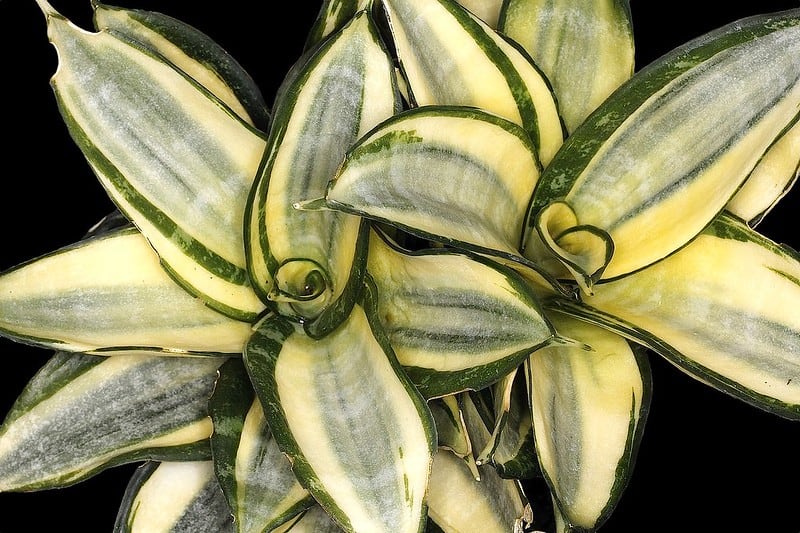
Sansevieria trifasciata ‘Hahnii Silver Marginata,’ now classified as Dracaena trifasciata ‘Hahnii Silver Marginata,’ is a compact, variegated cultivar of the Bird’s Nest Snake Plant. It is admired for its broad, funnel-shaped leaves with silvery-green centers and creamy-yellow margins, creating a striking contrast. This variety forms tight rosettes, making it ideal for small spaces and decorative arrangements.
Sansevieria trifasciata ‘Black Coral’
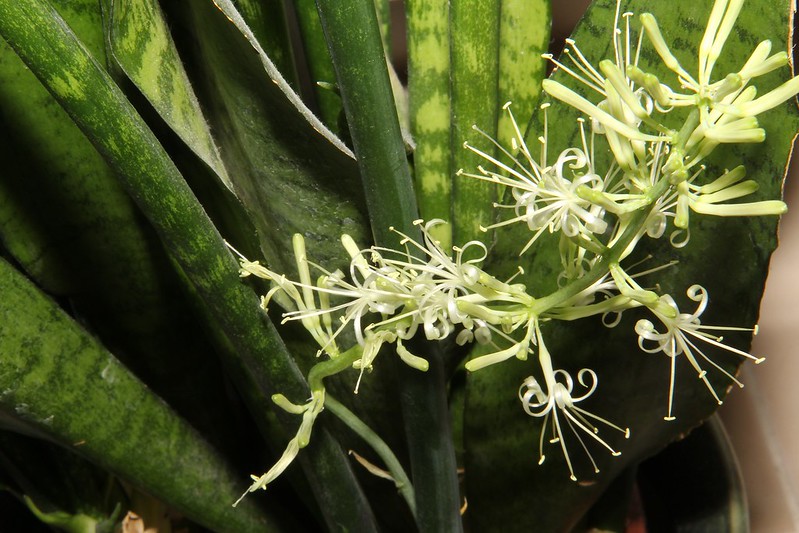
Sansevieria trifasciata ‘Black Coral,’ now classified as Dracaena trifasciata ‘Black Coral,’ is a striking, dark-leaved cultivar of the Snake Plant, admired for its deep green, almost black foliage with contrasting silver-gray horizontal banding. This variety is highly sought after for its dramatic coloration, making it a standout among Sansevieria cultivars.
Sansevieria trifasciata ‘Twisted Sister’
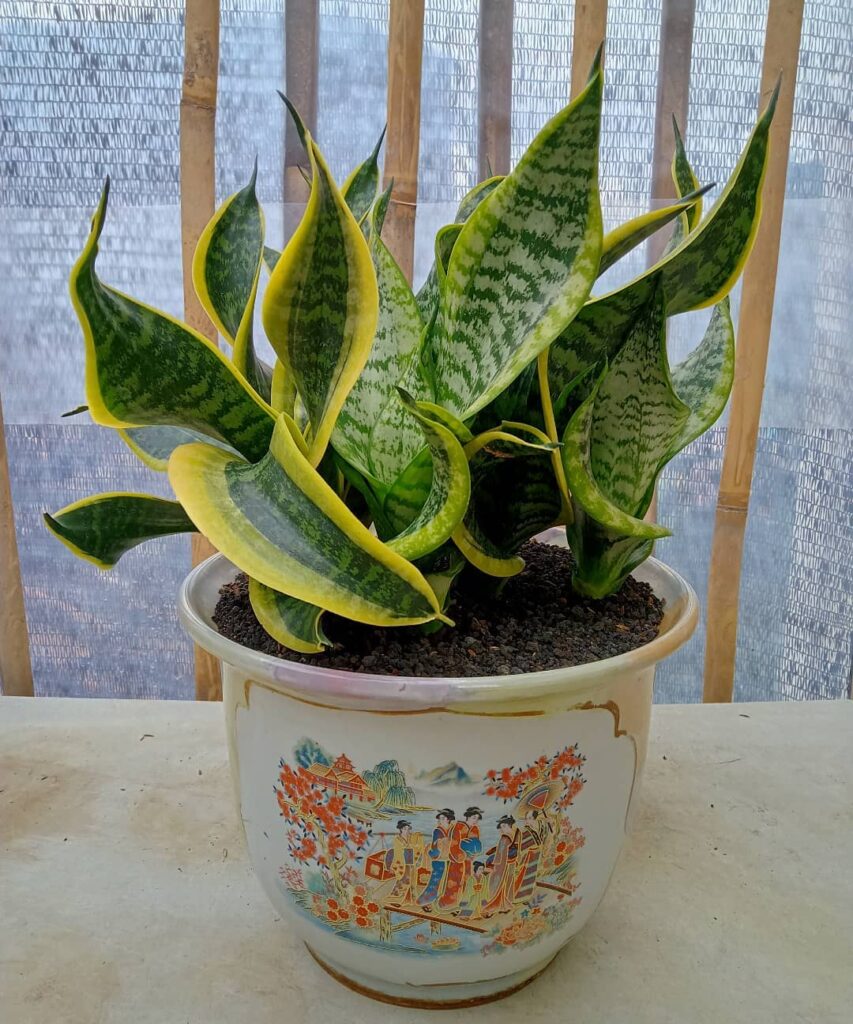
Sansevieria trifasciata ‘Twisted Sister,’ now classified as Dracaena trifasciata ‘Twisted Sister,’ is a compact, sculptural cultivar of the Snake Plant, admired for its twisting, curled leaves that create a dynamic, swirling effect. The foliage is green with gold variegation, forming a tight rosette that resembles a bird’s nest.
Read also:
Can You Plant Different Types Of Snake Plants Together?
Sansevieria volkensii
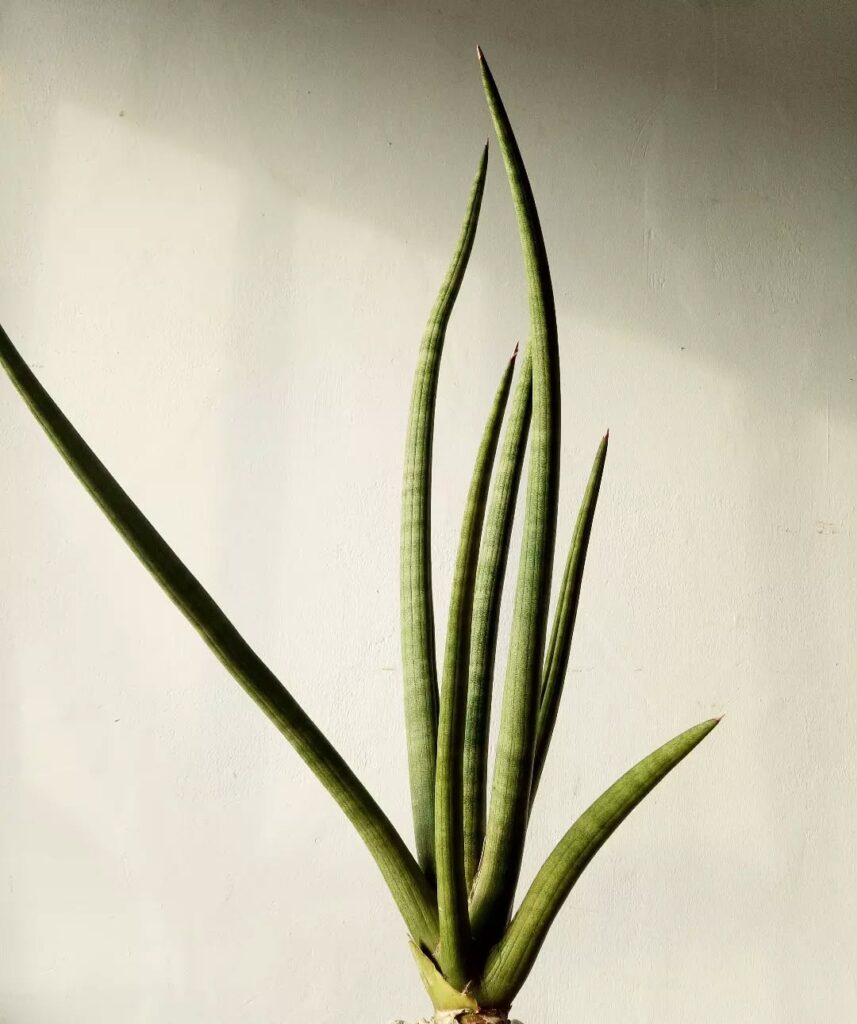
Sansevieria volkensii, now classified as Dracaena volkensii, is a rare, cylindrical-leaved succulent native to East Africa. It is commonly known as the Pencil Snake Plant or Skyline Spears due to its tall, round, upright leaves that resemble a cluster of green pencils. The foliage is deep green with smooth surfaces, growing in a perfect fan formation.
It is a slow-growing plant, reaching 1 to 3 feet in height. When mature, it produces clusters of fragrant white flowers that bloom at night.
Sansevieria zeylanica
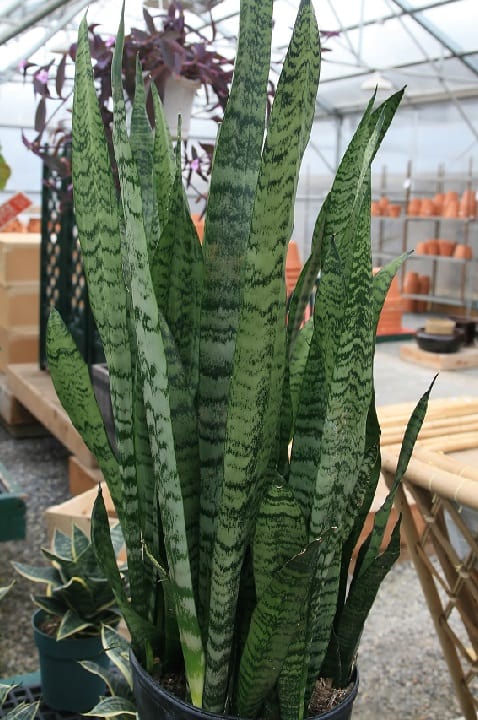
Native to Sri Lanka, Sansevieria zeylanica grows upright to 24-28 inches (up to 2 feet 4 inches) tall. Its leaves have a leathery texture, marked by gentle, undulating green horizontal lines, complemented by irregular white crossbands.
With a shallow root system, frequent repotting isn’t necessary—only divide offshoots when roots fill the pot. Provide direct or bright indirect sunlight and water sparingly, allowing the soil to dry completely between applications. A monthly cactus or succulent fertilizer ensures consistent health, making S. zeylanica a unique textural addition to plant collections.
Is a snake plant a succulent?
Yes! It is classified as succulent because it stores water in its leaves to reduce the need for hydration. Snake plants are perfect for warm humid or dry climates and they grow well in low-to-medium light levels.
Famous for its ability to remove toxic chemicals from the air like formaldehyde and xylene, this is one houseplant worth having around. Not surprisingly, it’s used as an ornamental plant in landscapes where it grows wild as well as indoors.
If you are a botanical garden manager or florist, it will make sense to put custom stickers on this wide variety of plant pots. The stickers can show varieties, characteristics, logos, and other information. In addition, this sticker has the characteristics of waterproof and sun protection, even the outdoors will not affect its normal use.
